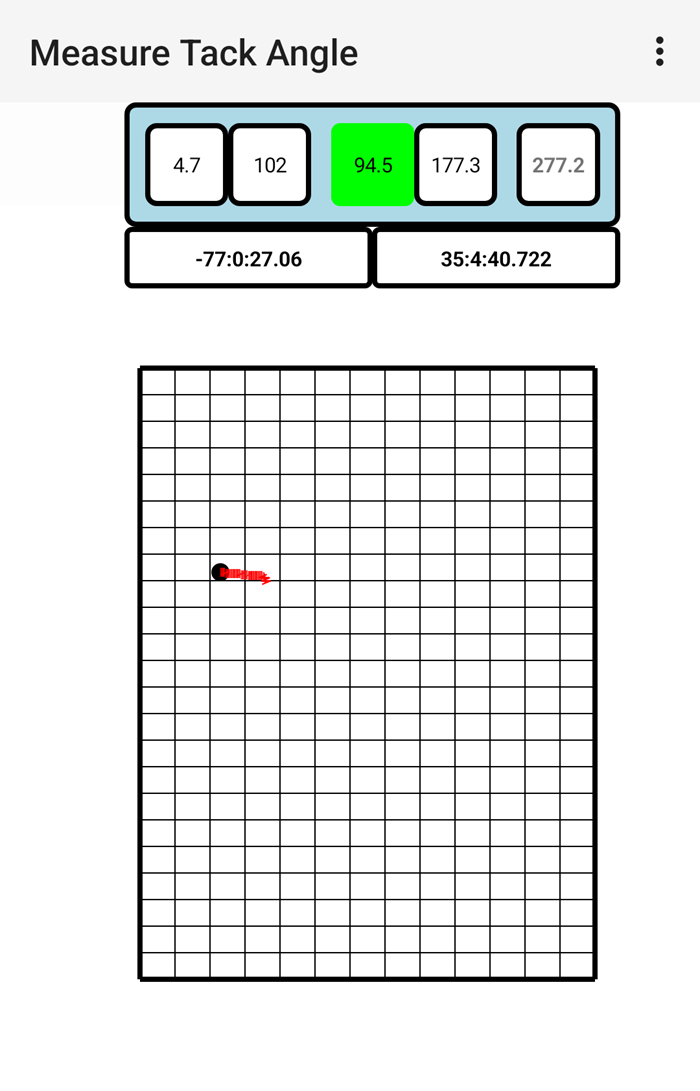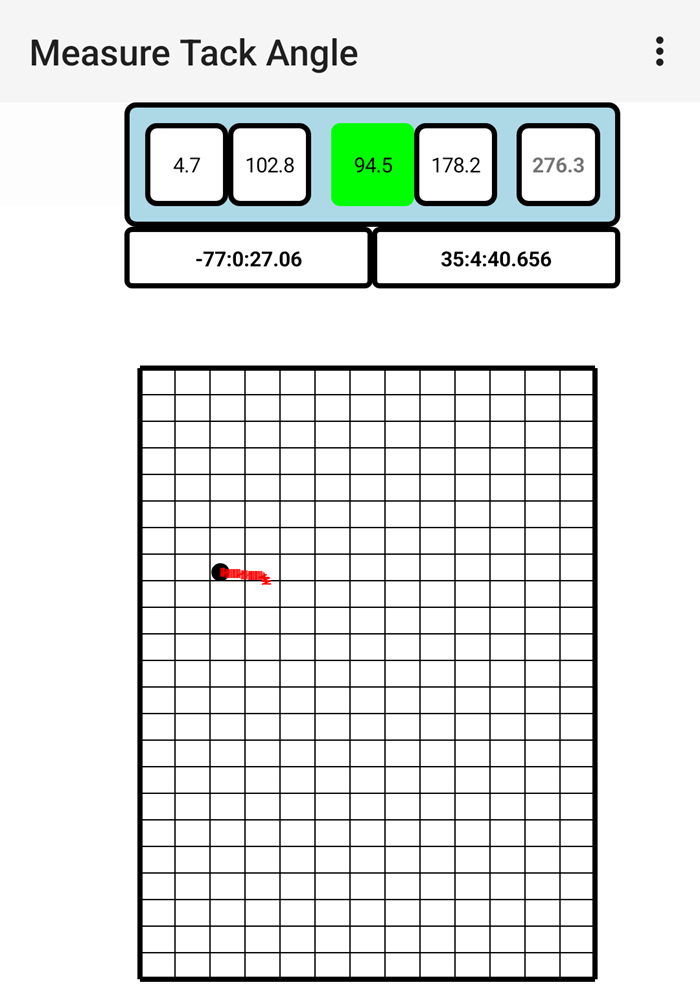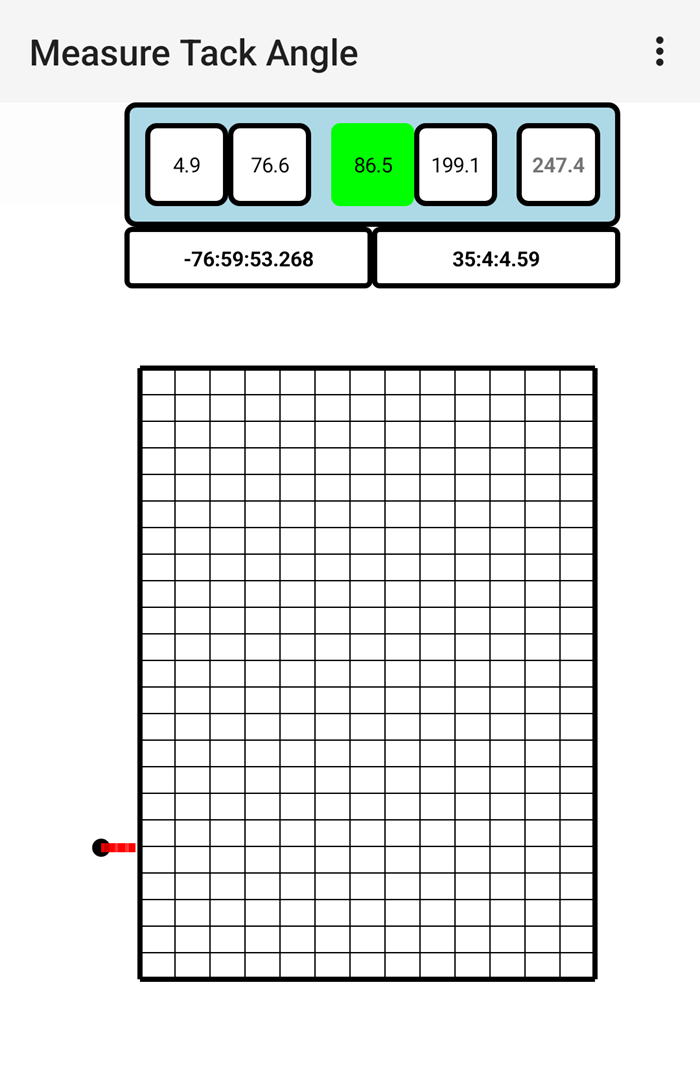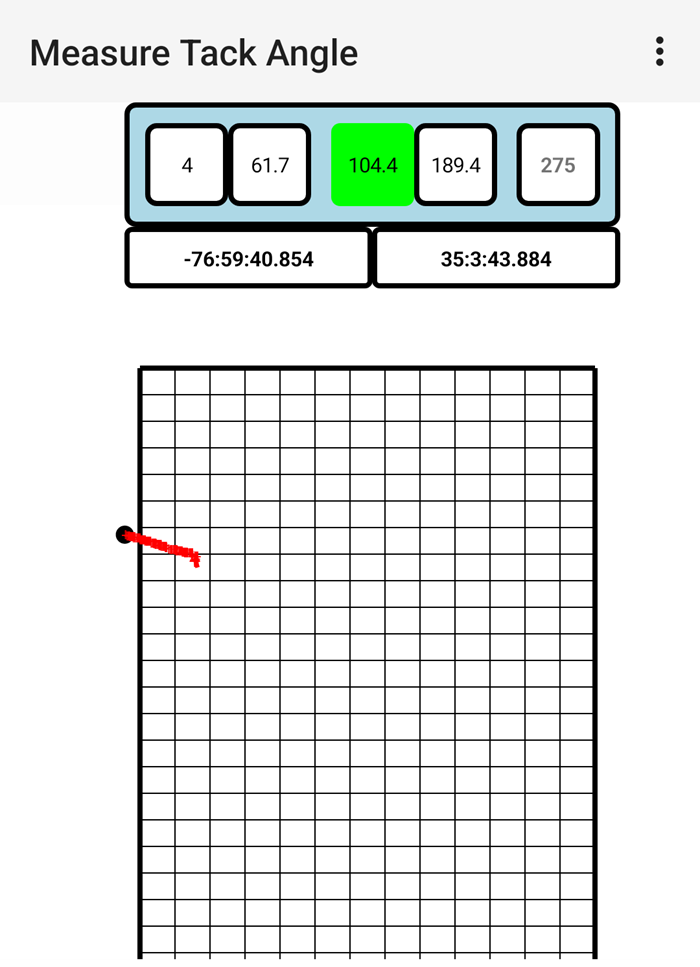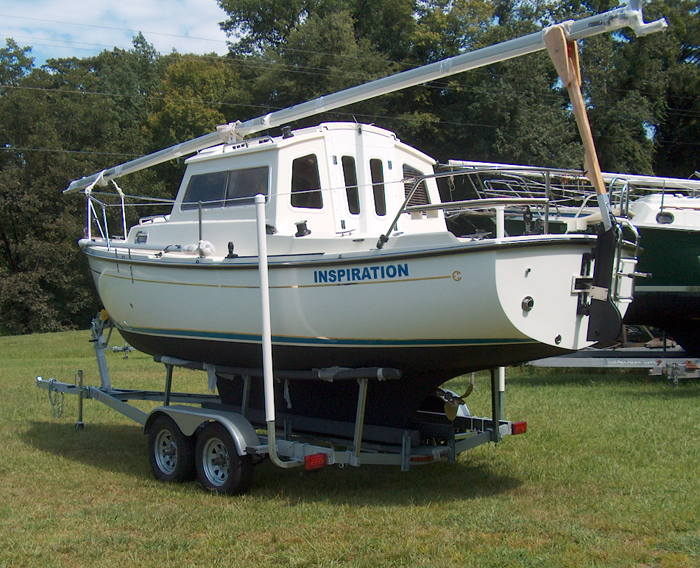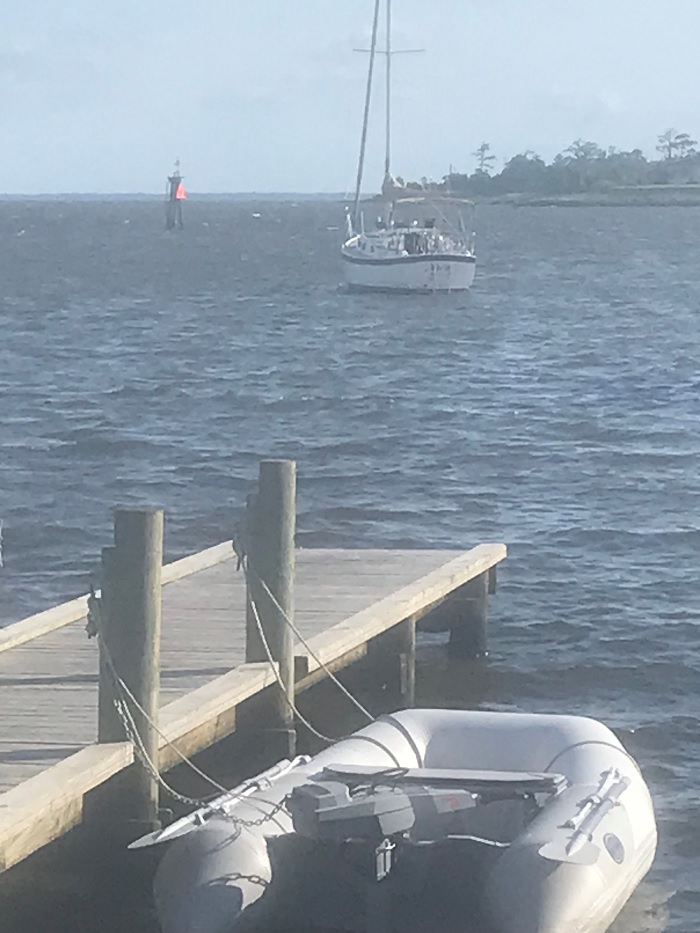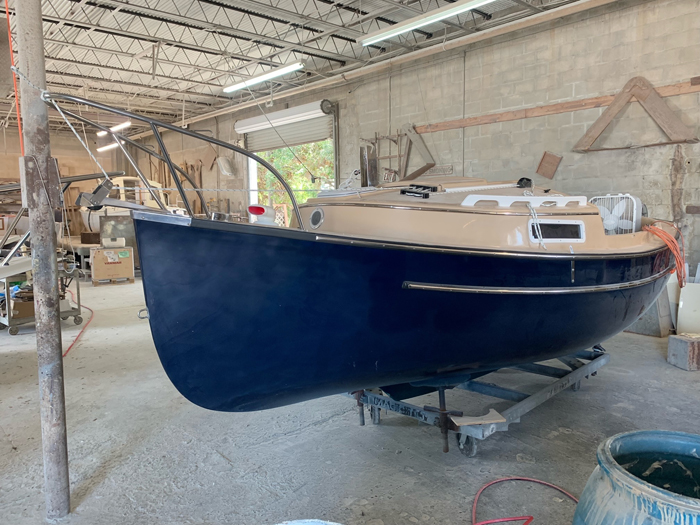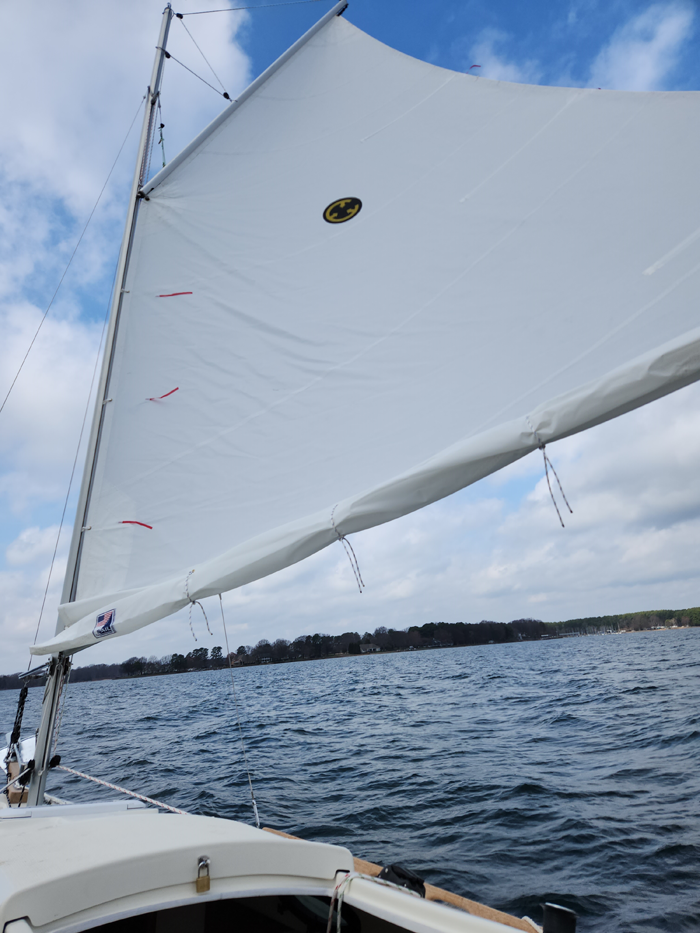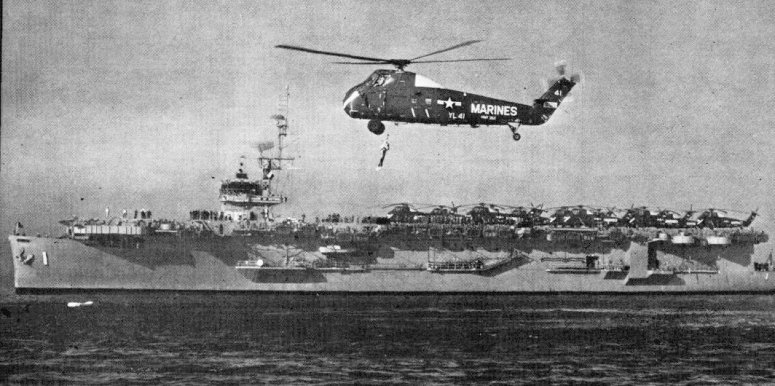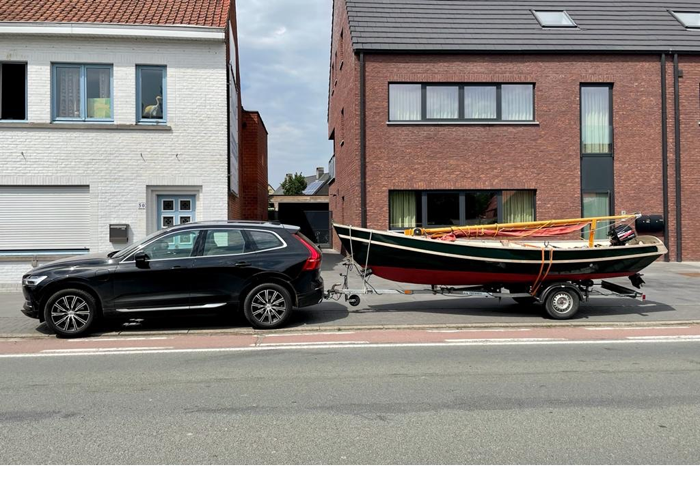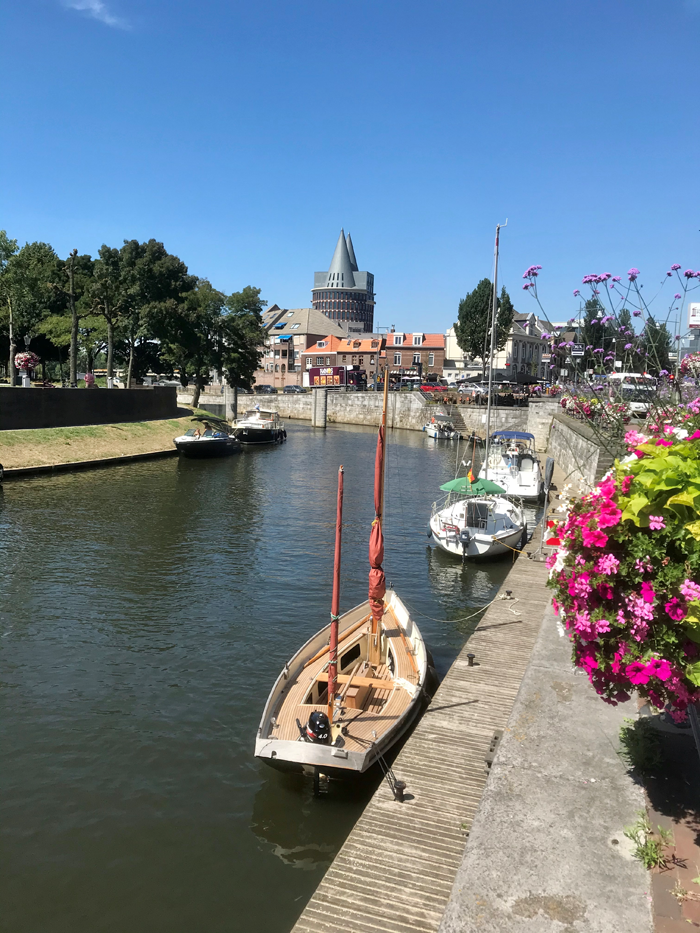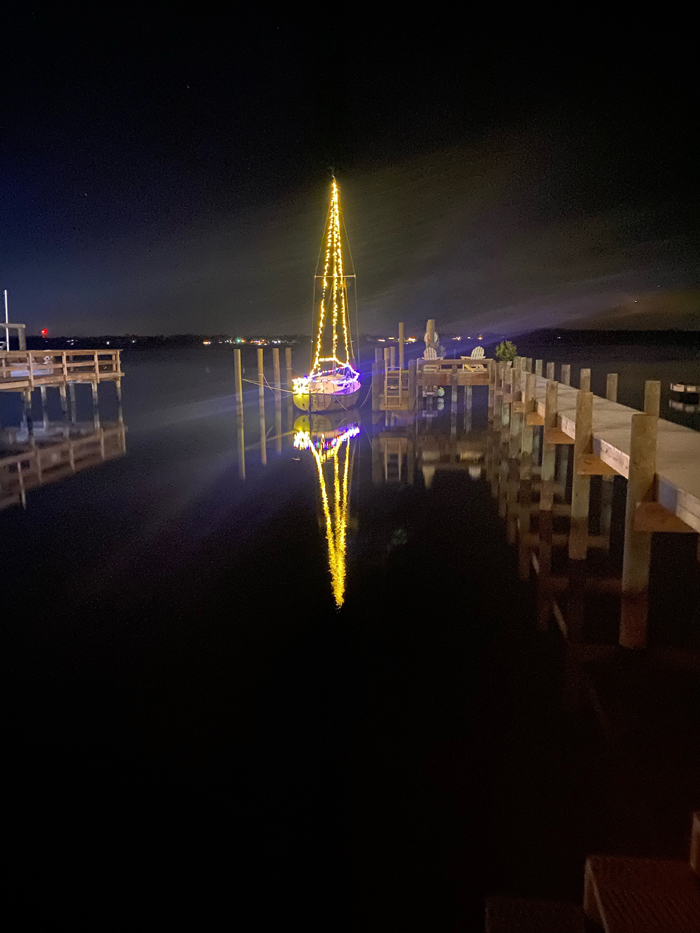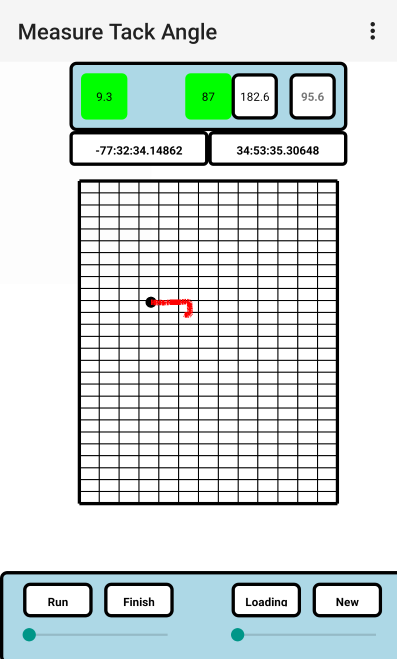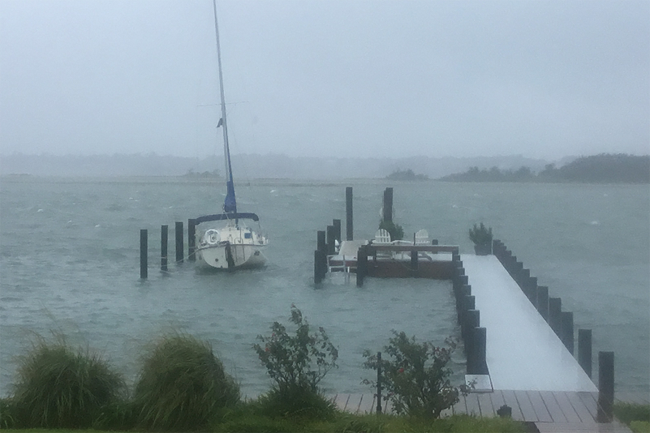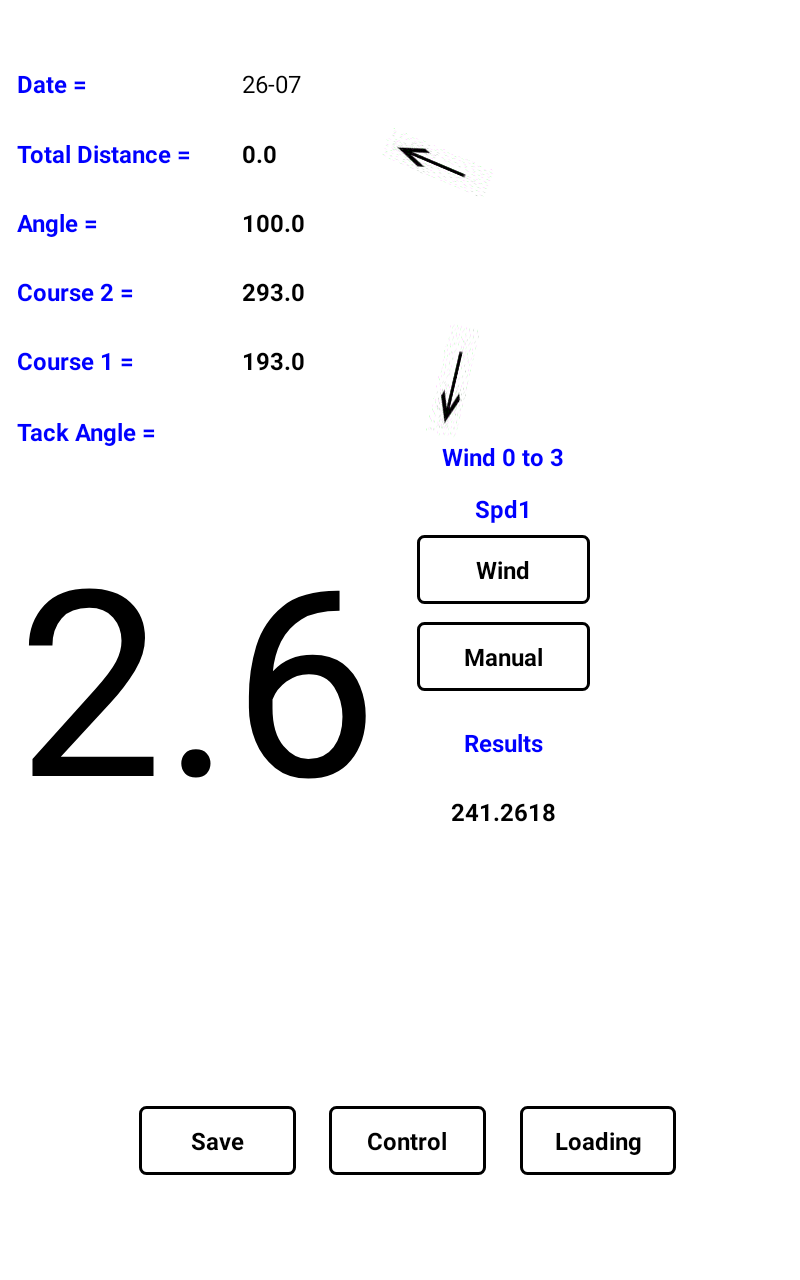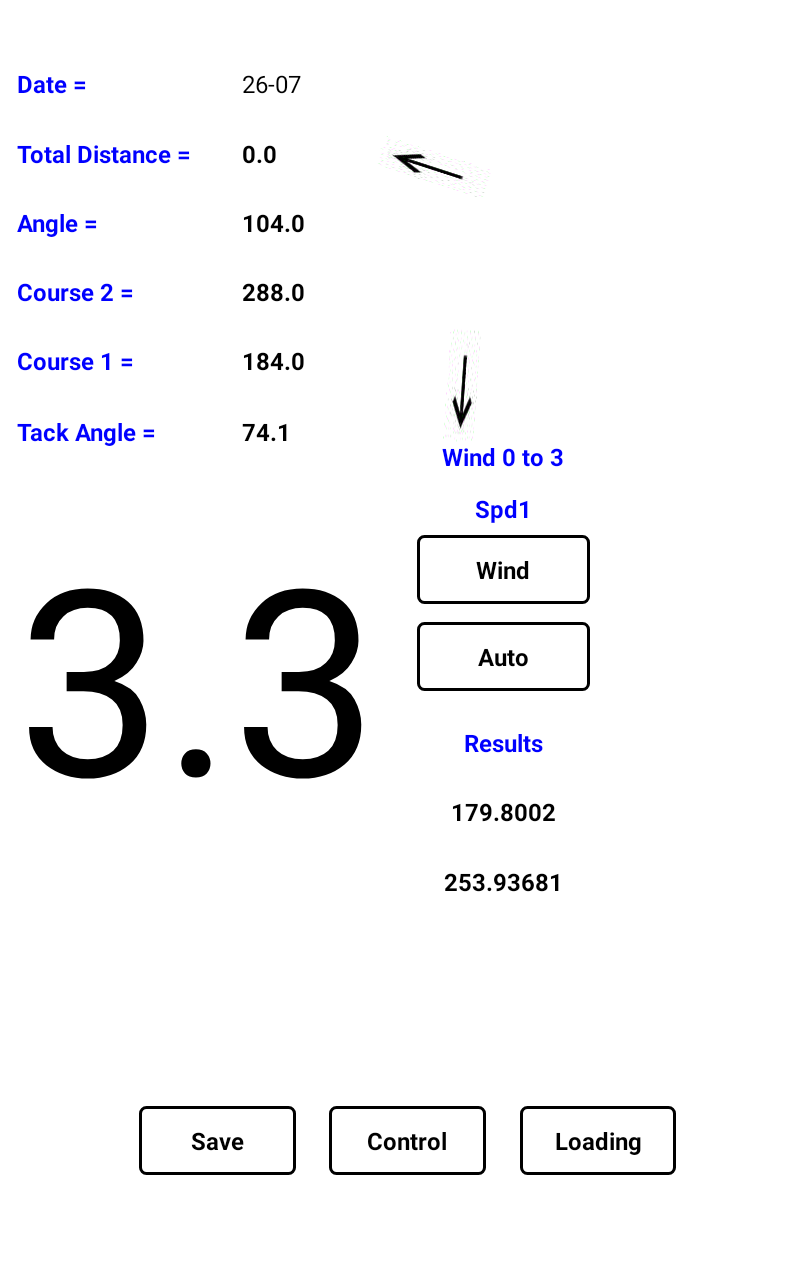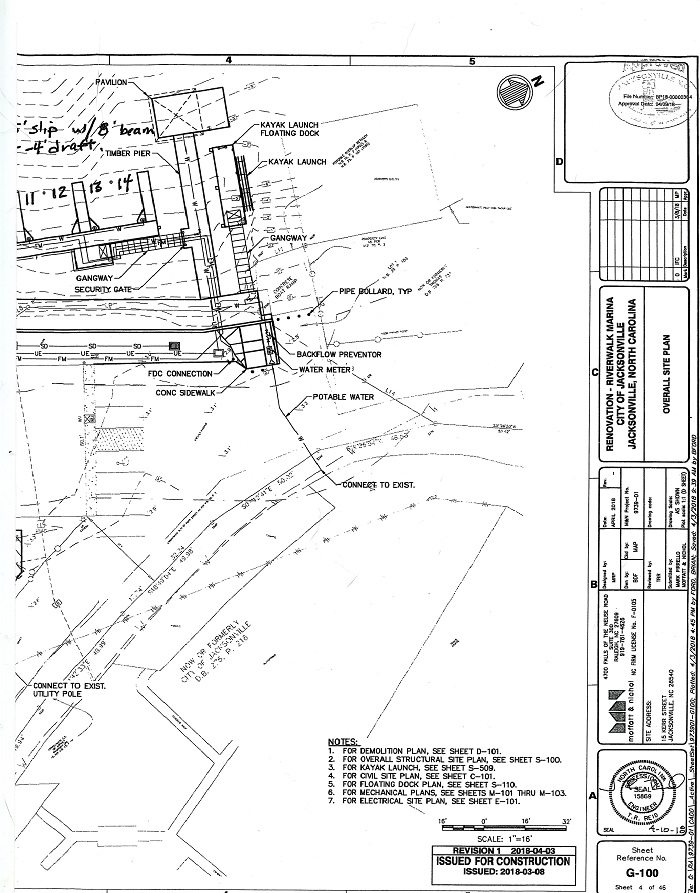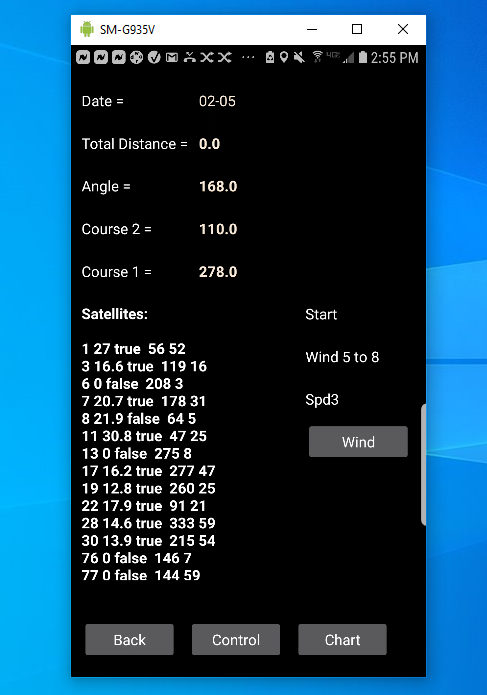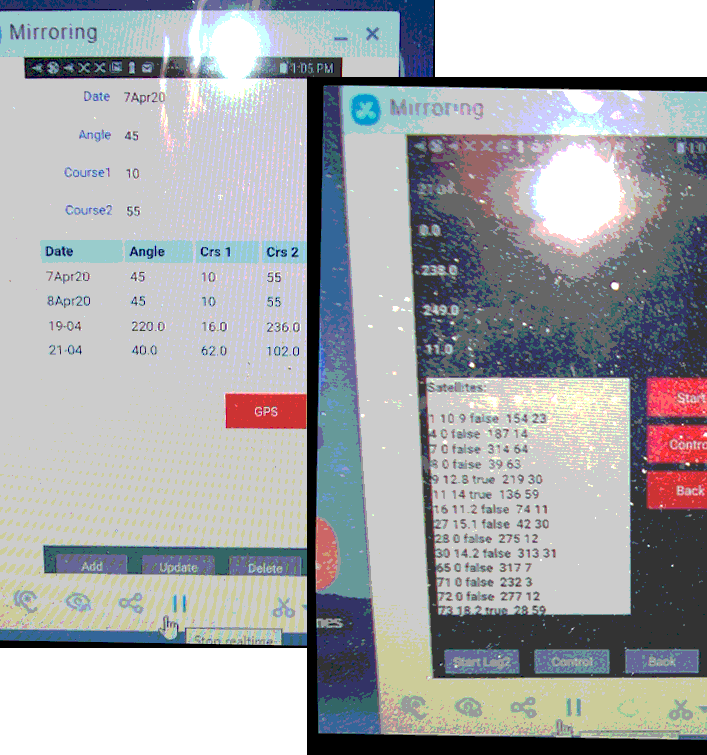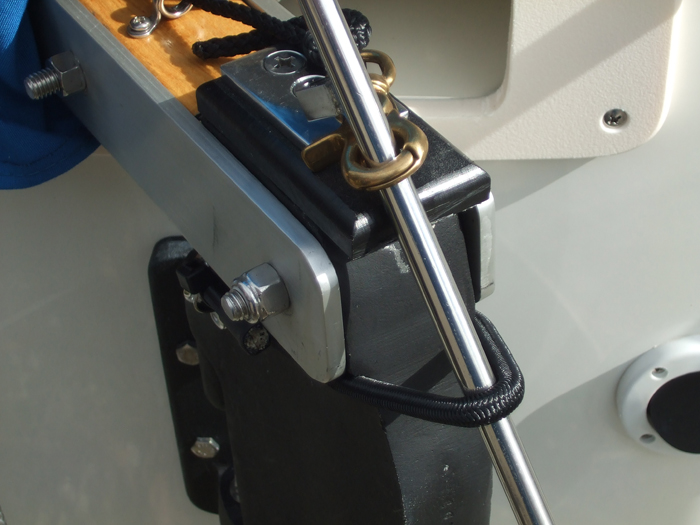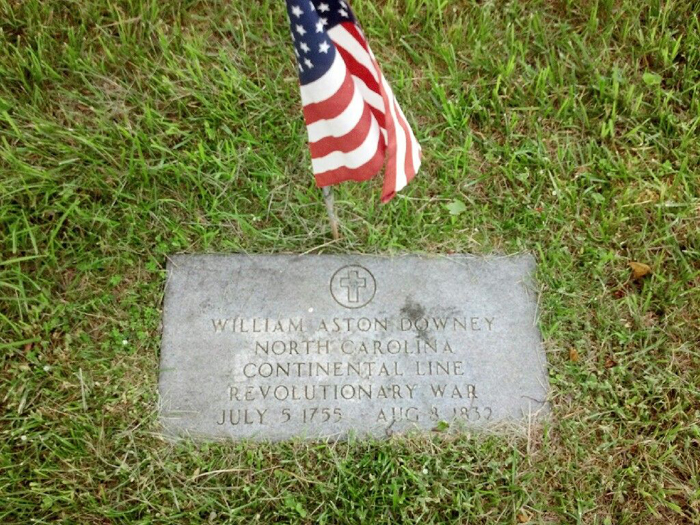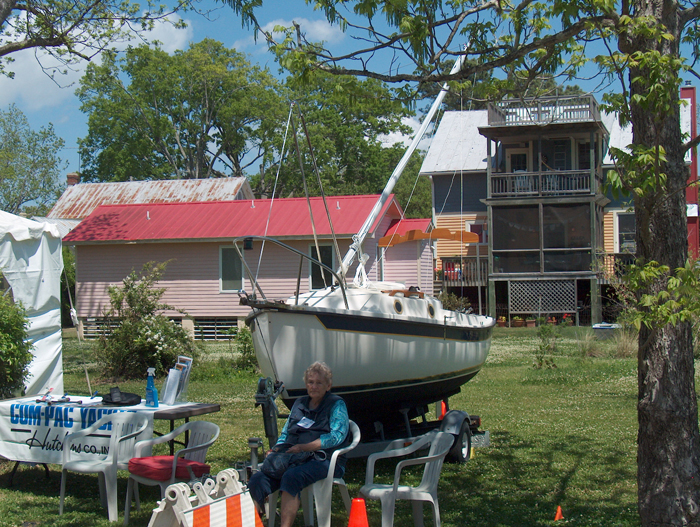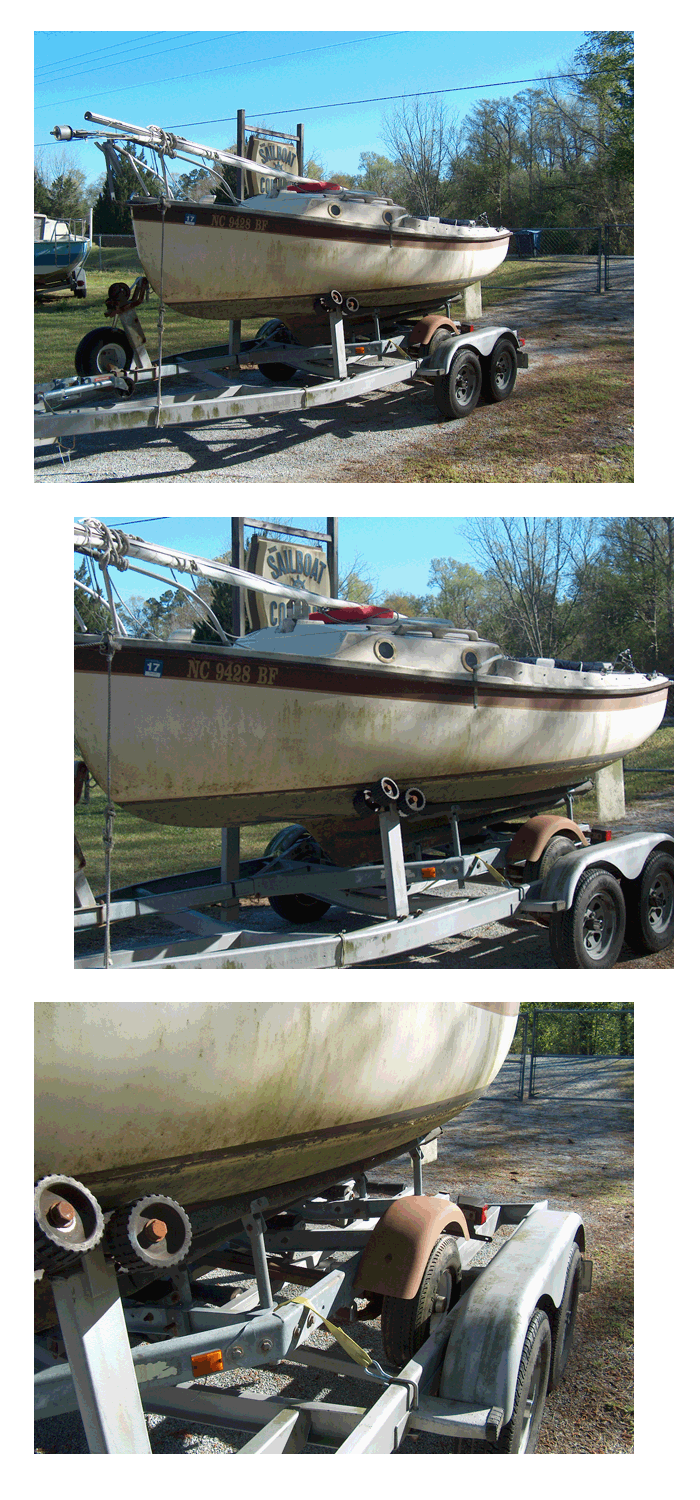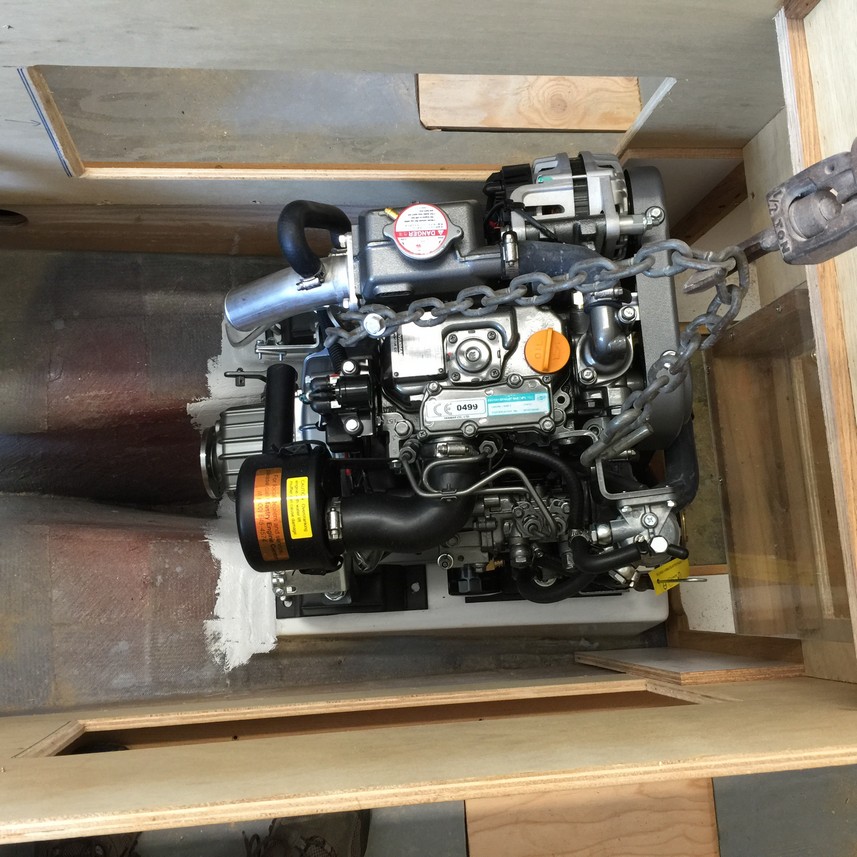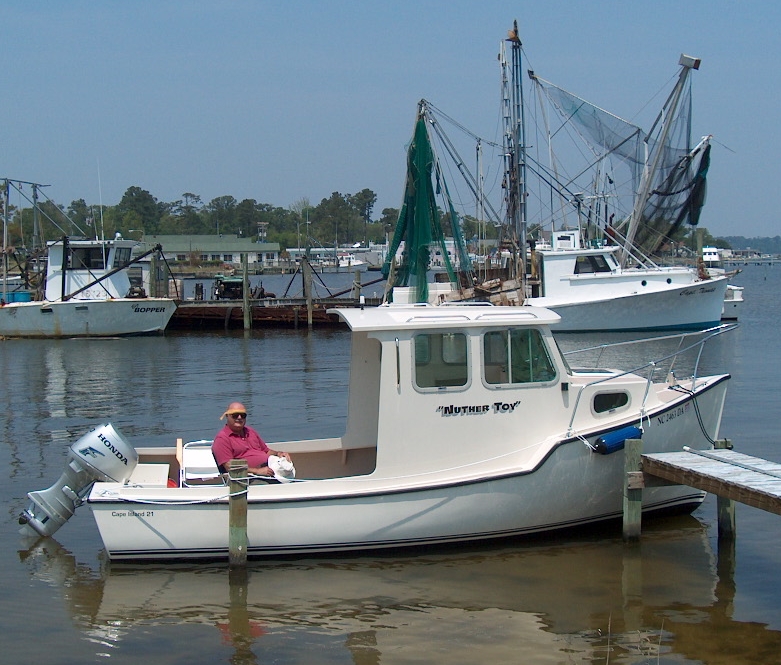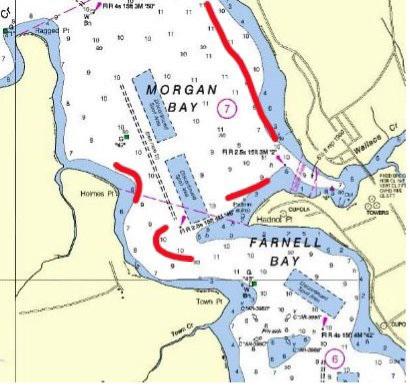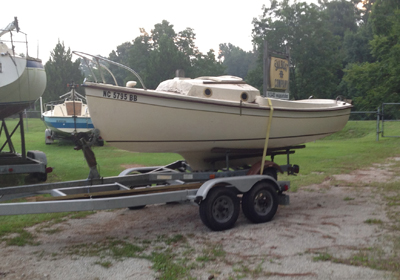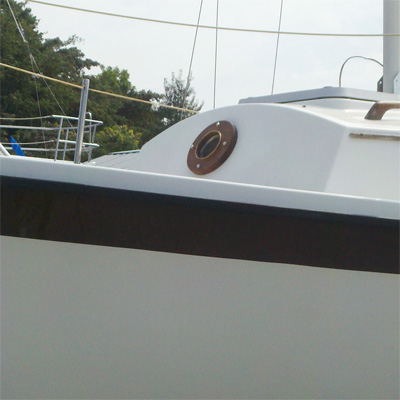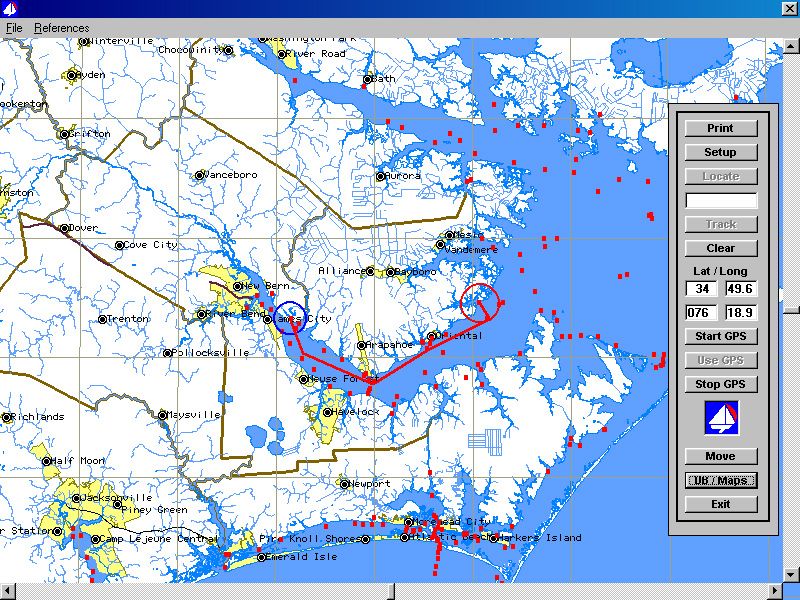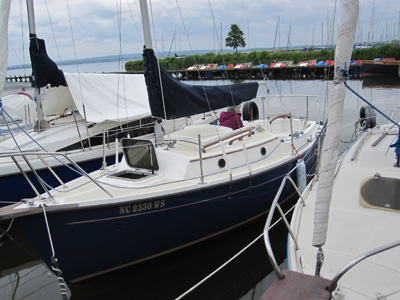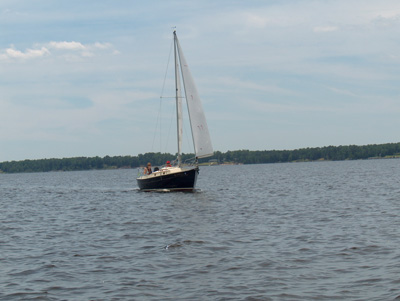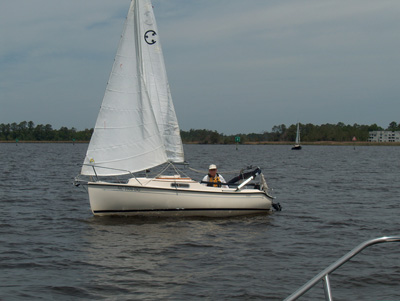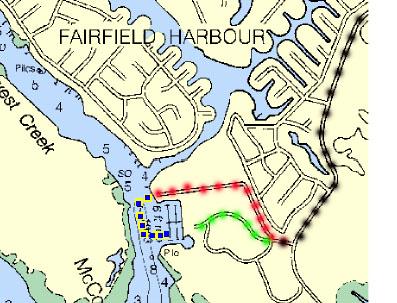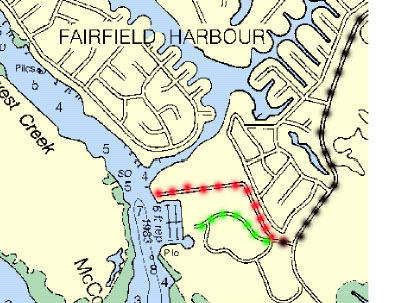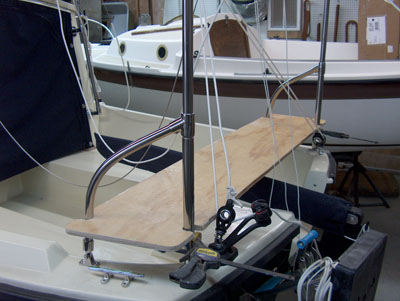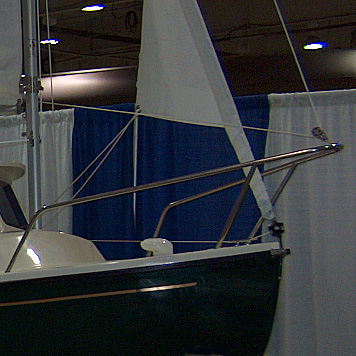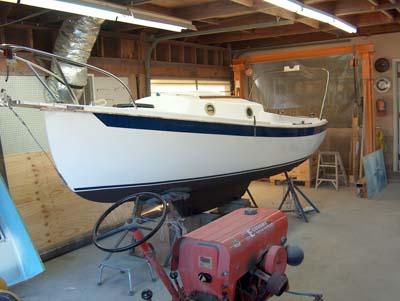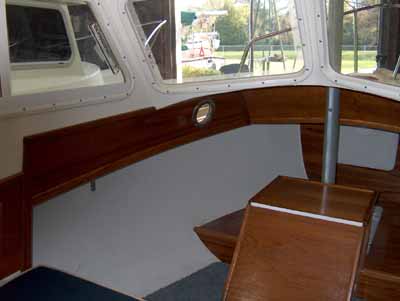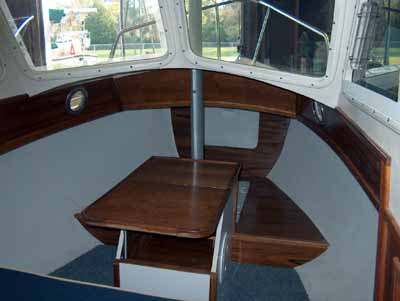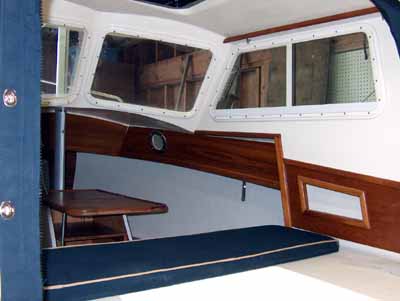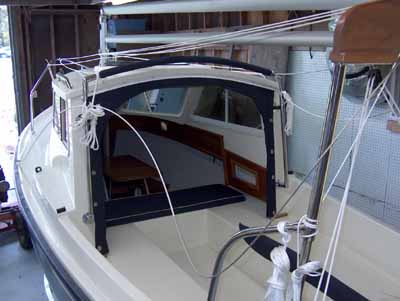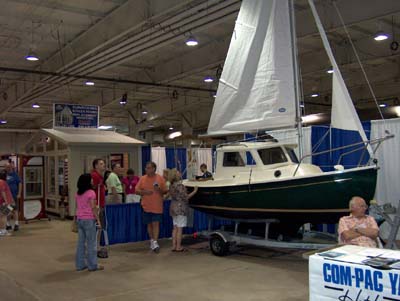LAST MODIFIED
Friday, 09-Feb-2024 12:44:09 EST
The following information is an important step towards getting good at sailing. Those that understand the principals involved will have a big step up from those that do not. For sailors, this may be the best thing since sliced bread. What is relative wind? It is a wind that blows in a direction other than the natural wind. It is a wind that is different from the general wind direction. When we talk about wind, it is either direction or strength or maybe both. Since I am talking about tacking, most sailors can identify a good tack from a bad tack from the results they achieve. Since it is dynamic, it is hard to tell the reasons for a good or bad tack? Some sailors can, but not many. The computer broke it down into its parts and pieces and we now know the answer. If you know what is going to happen before it happens, you are going to make a good tack. First, you need to know at what boat speed your boat will power through a tack. Second, if you can achieve that speed, the turning movement in the tack will generate a relative wind shift that will keep you sailing during the turn. When the boat turns on its own axis, it is going to make its own wind. Some of the fundamentals are your sails. How deep is the chamber. If the depth is large and can not be flattened, the sail will luff sooner in the tack. The sails on our competition Com-Pac 27 are new and they have a modest chamber depth. Jet aircraft wings are thin for good high-speed performance, and they use slats on landing to increase the chamber for a slower landing speed. We do not want to slow down in a tack, so we do not need slats or old sails. Can a sailboat sail faster leaving a tack than coming into a tack? The 27 did on his first two competition tacks. The 27 had about 5 to 6 knots of wind and it kept getting slower during the last two tacks. The speed coming out of the tacks were faster than the speed going into the tacks on the first two tacks! That’s success. Check your sails, determine the right wind speed for tacking by looking at the water, and practice. How do we tack in light wind? Very slowly. |
Sailors have been becoming better sailors for years through racing. Beer-can racing is still popular in some parts of the country. The best learning tool is another sailboat trying to do what you are doing. Getting to the finish mark first. That's how we learn. We are going to do the same thing, but it's going to be done with software and devices. Who can point the highest and make the best tacks? We are going to limit the boats to Com-Pacs for the first year and maybe everyone can join in the competition during our second year. The equipment needed is explained below. We have one entry so far and we will display results on a separate page. Click here to see that page. All aids to sailing like currents, wind lifts and the weather are legal. Plan your tacks for the best results. Good luck. |
Used Google phones are available on Amazon at cheap prices. The phone has to have GPS and Wi-Fi, and most do. You can use it as a computer and keep your Apple phone as a phone. In other words, you don't have to change phones. The software also works on Google tablets. The display will be a little bit to one side, but who cares. It's the data that's important. The display and the information work in a 1-mile square at most latitudes. Any 1-mile square north of the equator. If you are too close to the edge of the square, move over a little bit to get the display and the data in the square. Used Google A14 phones are available on Amazon for $125. They will work fine. The software will tell you about your sails, good or bad, your boat bottom, clean or fouled, and a lot about what you can't see with your eyes while you are sailing. The river currents, wind shadows and wind direction changes requiring a course change. |
The software tool described below is a free application available as a download from The Sailboat Company. You can download the application by sending an email request to The Sailboat Company Then you can install it on your Google device. I use Syncios, a free program on the internet to download application from your computer to your device. You can ask questions if you can't make it work. |
This software measures the angle and speed of your tacks. It is designed as a learning tool for sailors. Sailboats tack at different angles in different wind and sea conditions. Using a compass or "The seat of your pants" is a slow way to get good at tacking. The software can also help a sailor identify the effects of current in a river and the wind shadows created by the terrain on lakes Any and all sailors will benefit from knowing how well their boats tack. The software consists of an application and a method to record the results. We use a Google phone or tablet to power the application. They both can record the results, but the phone can normally email the results to another device. Keeping records over time should show improvements. You start using the software in your car or truck. It's the best environment in the beginning. A driver at the controls of the car and a navigator in the passenger seat works best. The driver looks for a straight road and drives at a sailboat speed, say about 15 MPH or less. The navigator starts the software (when the car is moving) with the RUN button. When the software's green light appears in the center window, the driver can tack the car after that point or turn the car to the right or left 90 degrees when possible. A city block works pretty well. You need to look at the Lat and Long display to see that you are not too close to the edge of the minute that you are using. We can't do math when the seconds are 0. A display will tell you if you are too close to the latitude or longitude lines. Move away and start again. We use a generic degree and a whole minute for our calculations. That way this software can be used anywhere north of the equator and east of Longitude 0. After moving into the new course, 90 degrees from the original course, you can push the "Finish" button and read the tack angle results in the middle window. The speed into the tack is in the first window and the efficiency of the tack is in the second window expressed as a percentage. The tack angles are in the last two windows. After getting your results in the windows, push the COPY button to save the results to the GALLERY. From there, the results can be mailed to your home computer and saved. Every new measurement needs to be started with the NEW button. The EXIT button stops the software.
The following images are of a test sail last week in a Com-Pac 27:
This was our first image going down the Neuse between Duck Creek and Fairfield Harbor. Remember what I said. We were going down the Neuse with the current. We were also crossing the river trying to get away from the Longitude line where the software could not do its math. We were just reading the tack lines, not measuring an angle.
This is our first measurement. It was pretty good. It felt good and the numbers were good. Why is the speed after the tack better than going into the tack. Answer: current.
This is the second measurement. Notice that the second leg is down river.
The third measurement and we were almost off the chart. Too close to the Longitude line, but it worked.
The angles are not improving, and the speed efficiency is not as good. Our 5 to 10 mph wind is going down.
With the information that the wind provides us at the surface of the water and the additional data that this software provides, we can analyze how we need to sail our boats to get the best results. In this case, always tack down current and with a little more wind if you are 6000 pound boat. |
Del Burns made it out to Silver Lake on the Outer Banks with some great weather. Coming home may not be as good. Wind on the nose and a little rain may slow him down some. See the light house in the background?
|
A loaded Com-Pac 23PH will be sailing on the Chowan River this year. My Great father times about 7 surveyed roads in that area for the King of England. It's going to be great to see where Grand Dad did his work. He had to stop his survey business so he could fight the English in the Revolution.
|
Diesel Fuel grows fungus or bio creatures that look like brown rice only smaller. It can't get through our R12 filters, but a clogged filter will shut an engine down. Who sells bad fuel? People that don't sell that much fuel. They don't keep fresh fuel if they don't sell that much, and the bad stuff is in the bottom of their tanks. The R12 in the boat takes a while to fully clog. The time between filling your tank and engine shut down depends on the amount of contamination. The Com-Pac Club got fuel at Oriental twenty-five years ago. Twenty boats were on their way to Ocracoke Island. The diesel boats got halfway to their destination before their engines quit. The outboard boats had to pull them to Ocracoke. I could tell you about more cases, but they are all the same. So how do you fix the problem. Don't buy diesel fuel in Oriental and buy it at a truck stop that sells lots of fuel. If you get contaminated fuel, everything must be cleaned including the fuel lines.
|
We converted a 1982 Com-Pac 23 outboard version into an almost new Com-Pac 23D with a diesel motor. The "D" stands for diesel motor, and this is one is the first outboard boat to be modified with the new improved 2-cylinder diesel, the 2YM15. It also has stainless steel hardware on deck and a new inside that is like what Com-Pac is currently building. The only original items left on the boat were sails and they are in good shape. It appears the next conversion will be an electric model Com-Pac 23E. We are currently talking to Electric Yachts, a Company that makes inboard motors that would be suitable for our boats. They say that we can expect 15 to 20 miles on one charge.
|
As sailors, we have been kicking the tires on our sailboats forever. If our sails didn't have holes in them and the brown stains were not too bad then they were OK. How many sailors sailed their boats, liked the environment and had a great time with friends and really didn't know or care what was going on with their sails. If you have fun sailing and don't know the details of sailing, that's OK. I think if you know as much as there is the know about sailing, that's better. One thing that not many sailors know about sails is the width of jib's chamber. Most sailors know that they can change the location of chamber by adjusting the jib halyard. Increasing halyard tension moves the chamber forward. When the wind increases, the chamber will move aft causing weather helm and increased rudder drag. Increasing halyard tension moves it back. A good sail with the right chamber should be able to produce a 3-degree trim condition on the wind. Bring the boat to a point where the jib just luffs and then fall off 3 degrees to a stall. If you fall off 20 degrees or more before the jib stalls, the chamber is too large. The sail could be blown out, the wrong material for the boat's size or a downwind sail popular on the West Coast. Being able to point to 45 degrees of the wind will be impossible. What causes poor pointing ability with a large chamber? The chamber's angle of attack is poor when close hauled. The sail can't be trimmed to a high point. With some exceptions, large cruising boats don't point as well as small boats. Some large cruising boats use double headsails to reduce the large chamber problem in large sails. They are called Cutters. These boats are up wind boats. When we use a genoa, we will have some of the same problems and we normally solve them by bringing the genoa around the rigging to reduce the sails angle of attack. We all know that genoas don't point as well as jibs on most boats. The reason is the width of the chamber and the chambers angle to the wind. If a jib and a genoa was sheeted to the same point on deck, the jib would out point the genoa every time. We hope to measure the pointing angle of all Com-Pac boats soon. Let’s hope the weather cooperates. I'm putting my money on the new Sun Sloop. I think is going to be a winner.
|
We all get one of those wonderful sails now and then. Del Burns got one last week going to Oriental from New Bern. The wind was over 20 knots and his Com-Pac 27 was doing 7 knots now and then. He was rail down and flying. After a really good meal at the M & M, he took his dink back to the boat. A preson on the dock yelled, you forgot to start your motor. Del yelled back, "IT'S ELECTRIC". He slept good that night.
We have lots of performance sailors in the Com-Pac Family. They love the Cat Boats, but they really love the sloops. Most started with a 16, 19 or 23 and they really liked those boats. The newest addition to the Com-Pac line is going to be a Sun Sloop. Clark Mills made them and now Com-Pac will do the same thing. The cost is going to be about the same as the Sun Cat. You are going to have a choice between the Cat or a Sloop. Get your order in early because this boat is going to be real popular.
We have some used Cat Boats on the yard that would be great cadidates for conversion to SLOOPS. If you are sloop person or if you sail on a lake, you might be interested in this conversion. Clark Mills designed the Sun Cat and he made both versions. We call the sloop version a Gaff Headed Sloop. It's about a $4500 conversion for the Sun Cat and more for a Horizon. We have an example on our yard of a Sun Cat that sailed from Forida to Maine outside. Some people could use a little more sail power.
Com-Pac has been building Gaff Sailboats for sometime. The mast and the rig fit inside the length of the boat and that's for easy trailering. Some sailors buy their boats for summer fun on the water and other want to go fast and efficient if the need arises. These comments are for the second group of sailors. I recently received an email from a new Horizon owner and he ask me my opinion about his sail shape. He sent a picture along with the email. This is want we talked about: Leahra, is sailing and operating beautifully. The picture is from yesterday 15- 20 mph winds reefed main. Not an Oz. Of windward helm. Out sailed a Catalina 22 all day. I have struggled a bit with setting the rig. I have moved the C.O.G as far forward as possible then adjusting the forestay so there is about 32 Loose reading on the rear stays. This also minimizes the aluminum to aluminum pressure on the rear side of the mast. Any advice from you?
This is what I said: You are looking good, but: The boom has to be below the hinge. The leverage is too great for the hinge to handle. The max chamber in the picture is about where the logo is. That’s a little aft, but you said the helm was balanced. I would put a tell tail on the leach up high. That would give you an optimum setting for the gaff and the right angle for that point of sail. You can think of the gaff as being a jib and adjusting it for the slot. The rest of the sail is like a main sail on a sloop. Its the power sail without a slot. You need my software on your phone so we could measure how well you tack. It measures the tack angle and the speed into and out of a tack for an efficiency number with a picture. It copies the picture and then it can be emailed. His reply was: I guess I am lucky no damage has been done sailing with the boom to high. I must have misunderstood the manual which is clear the boom must be below the hinge to let the mast down. There is a tell-tale at the top batten should there be one above that? My reply was: See what you think of this explanation? All sails need twist. The reason is that the drag is different from top to bottom caused by the surface of the water and the boat. Airplane wings are pointed because they have more drag close to the fuselage than at the wind tips. Same thing with sailboats. With sailboats, the faster wind speed at the top of the mast changes the direction of the wind a small amount. It’s always in the same direction, therefore we need twist to take advantage of this sail area. Taking the twist out the sail stalls the sail. Your power goes down and you heel more. One edge of the trim angle (gaff in this case) is a luff and the other is a stall. If all the tell-tails are flying straight back (luff and leach), you should be in the middle of a 3 degree trim angle. The tell-tails are flying at a 45% degree angle, you will be very close to as close as you can get to the wind. High pointing with a little less power. The max chamber will start to get weak and it will be easy to luff the top of the sail. In normal wind conditions, you will want to sail the luff. Set up your halyards for close hauled and sail the course pointing up just enough to cause the head to luff a little and then fall off and continue. That’s called testing the luff and it is the fastest way to get from A to B. If the tell-tail on the batten works, that’s OK. Before long you will feel the difference in the cockpit and you will not have to look at the tell-tails. It like driving a car, experience will make it second nature. |
Some of you may remember me saying in HMM-263 story on this Web site that "I could almost remembed the name of the ship". We were doing "Touch And Goes" off the coast of North Carolina getting ready for our deployment to Viet Nam as a Squadron. What I said in the story was that "I could almost remember the name of the ship", but I didn't and it's time to give that ship credit for being the first Helicopter carrier (LPH). The Thetis Bay started off as a jeep carrier in WWII and was converted to Helicopters in 1955.
|
Mike Humphreys spent the last few months sailing in the Netherlands. I'm thinking the weather looks pretty good in the pictures. Mike is currently sailing a Com-Pac Picnic Cat in the States.
|
Many thanks to Del Burns and his family for celebrating Christmas in such a wonderful way. You can get into the Christmas sprit by visiting Del's dock on Top Sail Island. You might catch the light just right like Del did in the picture below.
|
We have been working on some cool GPS tack measuring software for some time. If you have an Android GL G5 VS987 or a Samsung A20 phone, you can get a copy. Send me an email and I will send you a copy with installation instructions by return email. Hint: EBay sells used phones in the $60 to $80 range. You can use these phones as a computer and keep your old phone for making calls. The software measures your tack angle and speed. It's mostly automatic and doesn't require any special skills to operate. You are limited to a one-mile area anywhere in the US, Canada and Mexico. You can move the track to a better location if you are too close the edge with scroll bars and you can practice with your phone using your car. The software can copy the results to the Gallery and then the results can be emailed to anyone. If you send me a copy, I will put it on this Web site.
|
Southwest FL didn't do well at all, but the Clearwater area was spared. Com-Pac is hard at work building boats. It's raining cats and dogs today in NC and Ian should be gone soon. A pretty 23D is riding the waves at Topsail Island below:
|
It didn't work! We had a problem using our software at New Bern, NC. We had planned on sailing Al Parker's Horizon Cat and collecting the boat's pointing data. We did sail and it was hot and I used my old software to collect some interesting facts. Al is an excellent sailor and he handles the Horizon Cat very well. He says he sails two or three times a week and he and the Horizon are very smooth. We motored out of Duck Creek and Al put up the sail. It was blowing about 10 knots out of the southwest. The old software is very accurate and works well except that its a little too complicated for most people to use. Since the new stuff didn't work, I pressed on the old software. What we found was that the Horizon points to 50 degrees of the wind and that Al's tacking efficiency was very good at 25 degrees. The software has two modes of operation. One is manual and the other is automatic. The automatic measures tacking angle and efficiency, the manual only measures tacking angle. The manual system uses waypoints to measure angles and the automatic system uses both waypoints and course data. The difference between the methods is how we determine the efficiency of a tack. You can think of the course data being two straight lines where the waypoint calculations include the turn. A real good tack puts the numbers close together. An added note of interest. WE DIDN'T PUT THE CENTERBOARD DOWN. We could say it was the heat, but the bottom line is we screwed up a little. We are going to do it again when it cools off some and we will use the board. We plan on using the new software and the centerboard for the next test. It's not bad knowing what the Horizon will do in both configurations.
|
The Com-Pac Factory is building boats as fast as they can. They currently have a backlog of 30 boats and they plan on changing the waiting time from 18 months to 12 months soon. The parts suppliers have reduced the price on some items and some are slow in supplying the parts, but they are getting the job done. We will have a new Horizon Cat on the yard in about 4 to 6 weeks. It was sold to a customer about a year ago and he has waited on the list for that period of time. Someone said waiting for good things are worth waiting for. I think this saying applies Com-Pac boats. Transportation over the highway has got more expensive. Moving boats by truck may become too expensive and we may have to start sailing boats from point A to point B. Transportation has become a major part of the total cost of a used boat that may not be in your area. Used boats in the Chesapeake area have been more expensive than boats down south. Sailing one from that area to North Carolina is possible where boats in other areas can't be moved except by truck. The Sailboat Company has been working on a new software apps that tells sailors how well a boat points and tacks. The free Android apps can be installed at The Sailboat Company. Come by and get your copy. The Sailboat Company hopes to have an outboard 23 and 16 ready for sale this summer. Our satellite Office in Augusta, GA may have some used boat for sale also. Check out their Web site. Their link is listed on the left. |
Our long boat and skiff project has become a business. It deserves it own Web Site and we made one for those boats. You can click on it at the bottom of the page on the left. The 16-foot chassis is going to be the right size for the future. Boats need to be portable, but they still need to feel and handle like a big boat. The first test was a big success. Everyone is going to love the boat. |
The first cold air has arrived. My noise is running and the cat is getting as close the heater as possible. Christmas must not be too far off. The Sailboat Company has a tree and gifts under it with names on them of people that I know. I haven't seen one with my name on it yet. I still have some time before the stores run out of all the good stuff for Christmas. Let see, what I want is .......... Del Burns and family have celebrated Christmas with their boats for some time. This is last year's picture and they are going to do it again this year. It will happen on Top Sail Island Christmas Eve. You might want to be there. Wear something warm.
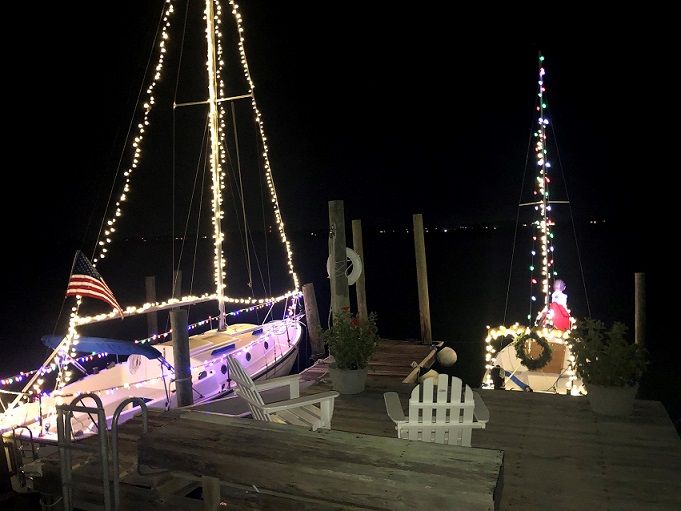
|
Most Com-Pac Owners know that the 16s before 1980 had deck problems. The core was wood and wood and water don't mix inside a fiberglass deck. Anyway, we put a new flat deck on one and installed a diesel. We took it out for a run yesterday and found it to be very stable and pretty fast. We clocked 5.5 knots with two men on board. I decided to add a small pedestal and a wheel after using the boat with a tiller. That will put the controls in one location. She floats on her lines and the drains are above the water line for self-bailing at a dock. We still have the cosmetics to do and that's going to be a winter project. Check out the exhaust coming out in the third picture.
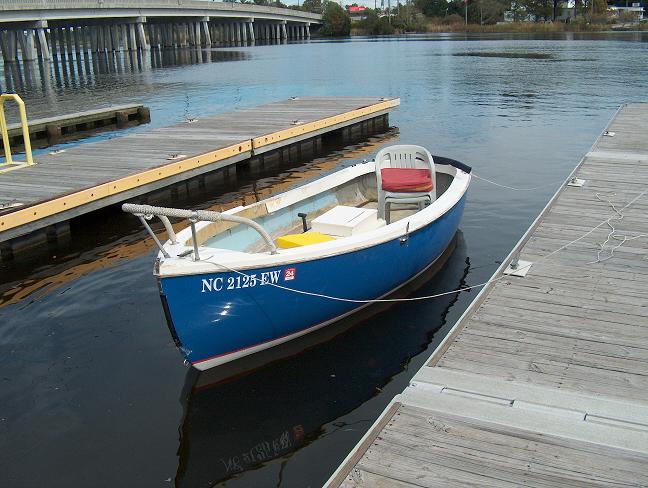
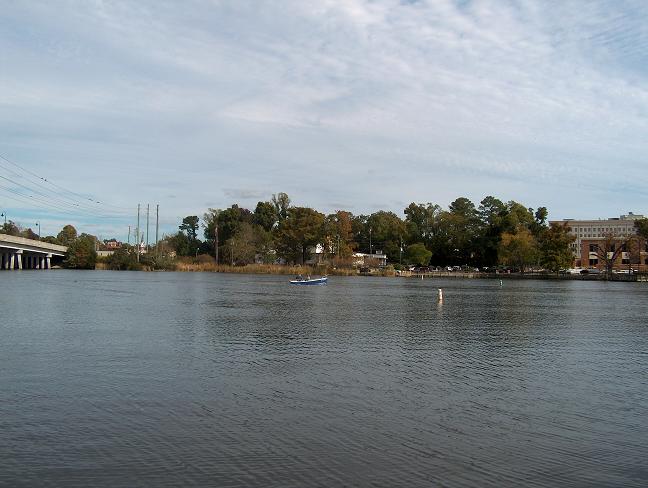
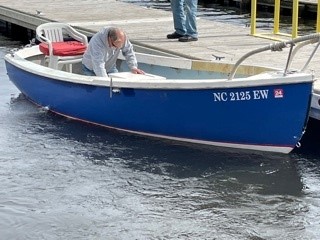
|
There are about 16 sailors that are going to have a wonderful time on Morgan Bay this fall. Morgan Bay is a wonderful place to sail with lots of wind and good sailing water for just about any sailboat. It big and wide and I love the sailing on Morgan Bay. The 16 sailors that I'm talking about are the ones that read this article and identify a good deal when they see one. The town of Jacksonville built a new marina about a year ago. It's not a big marina, but it going to be a nice marina with great access to Morgan Bay, the New River and the coast of North Carolina. It only has 16 slips. Currently, they only have 3 slips filled. You had better hurry. The City doesn't know it, but they built the marina for sailors like us. Big boats can't get under the 45-foot bridge that's close to the marina. Little coastal boats like us can launch from the public ramp a mile away and go under the only bridge between the ramp and the marina. We are the only boats that I know that can raise and lower their masts in the water. Maybe we need to get a club going at this marina? The details are below on cost and it's construction. Currently, they don't have parking close to the marina and no bathrooms. The person to call with your credit card is Amada at 910 938 5314. She works for the City Manager and if she is not available, talk to Pam. Pam is very helpful. See you on Morgan Bay.
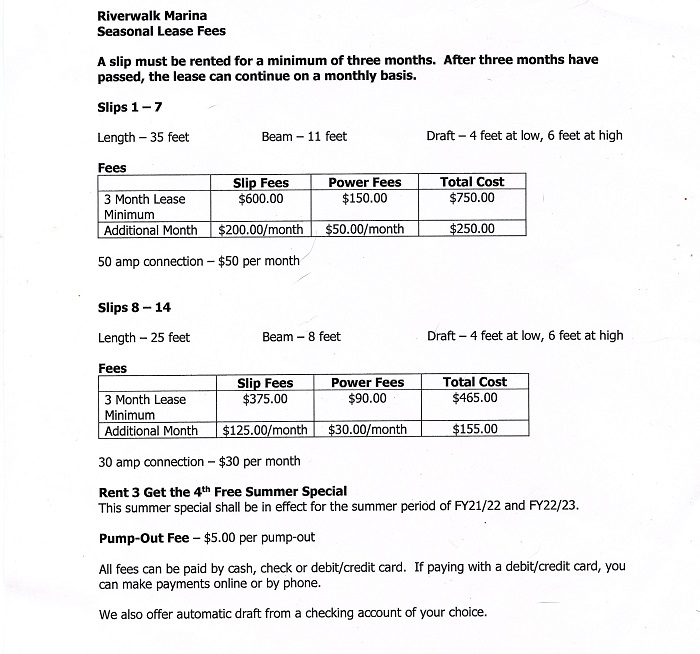
|
Not much going on without lots of boats to sell. The Factory is sold out until next year at this time. Just about all of the used boat have been sold. We are still working on boats and selling a few now and then. What's new this summer is the E-Sailing School and how well the software is doing. We can really talk to our customers through the school training program. We think the school training program will expand into lots of DIY programs. It will be like having a second set of hands helping with just about any project. It means you can do a professional job on just about any boat project and the boat doesn't leave the backyard. Used boats will be worth more as time goes on and modified and restored one will be worth the most. Something that should be a big hit is a new Yanmar YSM15 can go into a used Com-Pac 23. The factory builds new 23D and they are really expensive. The 23 is a great boat and maybe the best boat that Com-Pac ever built. The diesel makes the boat sail even better. Trying to find a 1GM10 to modify a 23 into a 23D is almost impossible. Installing a new engine will solve that problem and the used 23-diesel conversion is going to live again. We are building one now and I'm looking forward to sailing her.
|
I just received a super report on the Electric Outboards. Very little throttle moves a Com-Pac 16 to hull speed against the current at Top Sail Island. No noise and lots of power. Wonderful.
|
We are developing an Internet Sailing School that's going to be very cool. In the old days, sailors learned to polish their sailing skills by racing and participating in club events. There are not many races being held anymore and the clubs are few and far a part. The sailing schools where you sail on someone else boat and the instructor talks to you for a weekend is OK, but this is going to a better way to learn. Our plan is to use your boat as our classroom. A camera that's part of included tablet is going to our recording device. One on one with your instructor will answer your questions over time. GPS software programs will measure your boat's performance and utilize what is needed for improvements. A push button tablet program will sends the pictures and data to your instructor. It's as easy to do, as Face Book and every student will have their own private Web site that can be shared if desired. The best boats for learning will be a ballasted boat between 16 and 28 feet. Daysailors and larger boats will be considered on a case-by-case basis. The cost for the school is going to be low. It will be about the same as a Knot meter or GPS receiver. I will let you know when the school will start on this Web site.
|
The Com-Pac Factory is sold out until next year, 2022. Trailers are impossible to get along with canvas and other people created products. Used boats are few and far between and someone has to die to make one available. Of course the Virus has done its part with that detail. I'm thinking the Virus may be over by next year. It should be over this summer after we all get vaccinated. Getting back to normal is going to take longer because Governments are always slow to change back to normal after some calamity. I think the price of fuel will be going up and the price of gasoline will be going up and that will raise the price of everything we consume. The resin that we use to build boats is created from oil. Without that many boats to sell, we have been working on a virtual sailing school for sailors. The school is going to be divided into two parts. They are Basic and Advance Courses. As an additional benefit, both schools will include a show and tell section about the maintenance on your boat. Each sailor will receive a tablet loaded with some great sailing programs. The tablet is equipped with a camera and a way to communicate with a very experienced instructor. The instructor is going to see what you see when you are on your boat. He will be able to make suggestions and tell you why his recommendations are appropriate. The Advanced Course is mostly sail shape and its application in different wind conditions. It's also longer than the Basic Course. At a minimum, day sailors on lakes in light wind will work for instruction purposes. Ballasted boats on lakes and in coastal area will work best. They heel over less and stay put long enough for us to analyze the forces involved at that moment in time.
|
Several years ago (about 30) I made an automobile tracking system for me. I was spending lots of time on the road between FL and NC and keeping track of where I was, was a safety and efficiency feature for my company and the people that I was doing business with. With new technology better than it was back then, I though it might be time to do it again. I also found the old maps in a stored away box that hadn't been opened in years. My Daughter travels from FL to NC and we need a way to keep track of her while she is on the road. The Web page on this site will keep track of several people. Where you see the little red square is where they are. Anyway, that's the way it suppose to work.
|
I just developed a great piece of software that will teach almost anyone how to sail. I know what I say is true. The best way to make lots of sailors really good sailors is to teach them how to point their boats into the wind and tack well every time. They need to sail their boats like they drive their cars. Most everyone drives without really thinking about driving. We need a sailing school with an instructor to teach new sailors how to use the software and teach the students the fundamental of pointing and tacking. The school would be a one-weekend class. The student leaves the physical instruction with a tablet and a plan for getting good at sailing. There could be hundreds of instructors all over the country-teaching people how to sail well. An instructor needs to complete an on-line school from The Sailboat Company. He or She needs to qualify for a Six Pack License from the Coast Guard. A license would not be needed if you use two boats to teach. The instructor in one boat and the students in another will do the trick. It would be harder to do, but possible. Two boats like the Com-Pac 16 would be perfect for teaching. If you get your license, one boat would work just fine. Every student would end up with a tablet and a plan for becoming a great sailor. Sailing schools that are currently in business need to think about using our procedures to improve the instructions they already provide. A plan for instruction after the student's time on the boat will make sailing a success story. The following database page shows two pieces of data. It shows a course one and two and how well the tack was performed. The auto tacking method is the only one that shows how well the tack was performed. The manual method doesn't have this feature. You can tell which one is which because the auto method has two angles and the manual method has one. The first entry was edited to show a desirable tack. The rest of the entries were conducted using a car. It's too cold in NC for a demo on the water. We will do some real tacking on the water as soon it get warm.
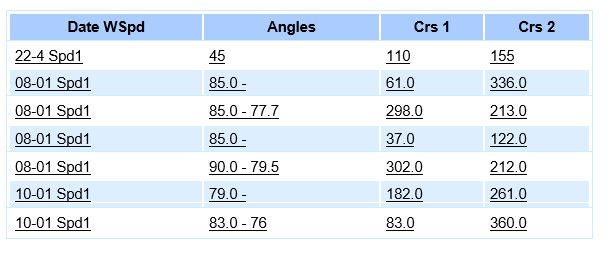
|
I assume that everyone with a Com-Pac 16 or Sun Cat received an Electric Motor for Christmas. Some years it's a new sail and other years it's a new motor or what have you. This year, this Sunday Cat owner is getting a new quiet outboard motor with remote controls. She is going to operate 2 hours without a recharge. The price is about the same as what you would pay for a remote controlled gas outboard of the same horsepower. Looks good?
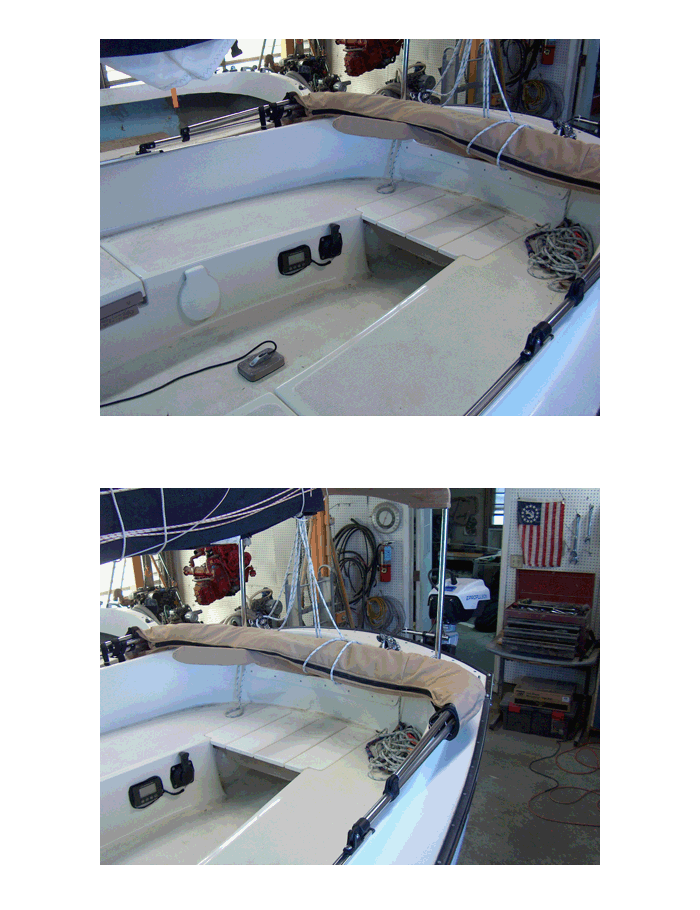
|
We have something new in navigational software. Everyone looks for those mileage markers on the highway so they can figure how far they have to go. If you have a GPS and you happen to be in your car, with a little bit of practice, you can use it to do the same thing. My new toy is tracking software with a measuring capability. You swipe the screen to see how far someplace is from some other place. Your finger becomes a measuring tool. On the water, it was always a guess of how close you were to the next mile marker. Mile markers are 5 miles apart on the ICW and if you do lots of traveling, this new software is going to be very useful. I have an old Windows program that I use all the time. I measure distances on the water and have used it for years. Now I can use a Tablet or a phone to do the same thing. I can retire my big old computer program.
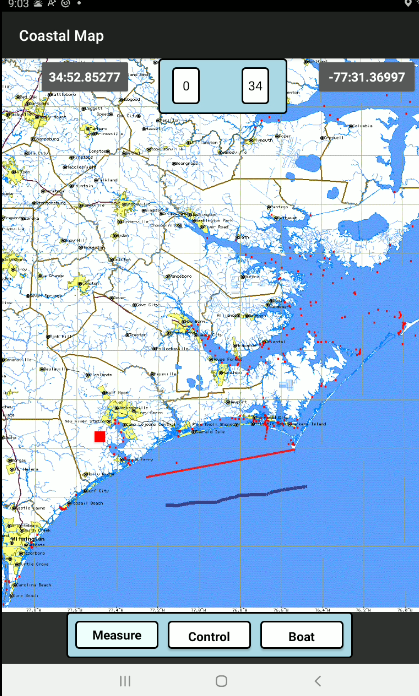
|
It looks like we have an improvement on the good old 4 stroke outboard motors for small sailboats. We used Seagulls 3hp and Tohatsu 2.5 hp motors on Com-Pac 16s for years. They worked well, but they made lots of noise. I think the new standard is going to be an ePropulsion 3hp. It's quiet and simple and can get 2 hours worth of running at half throttle on one charge. Some additional improvements are a wireless throttle control in the cockpit. No more hanging over the transom to control the motor. If you trailer, you can remove the battery for charging and forget about someone stealing the motor off the back of boat. The battery comes with a handle and it's easy to remove. Without the battery, the motor is useless. The controller gives you time remaining and speed and has it own solar charger that's built in. The included charger can be installed inside the boat for boats that live in slips. I think I want one for my boat.
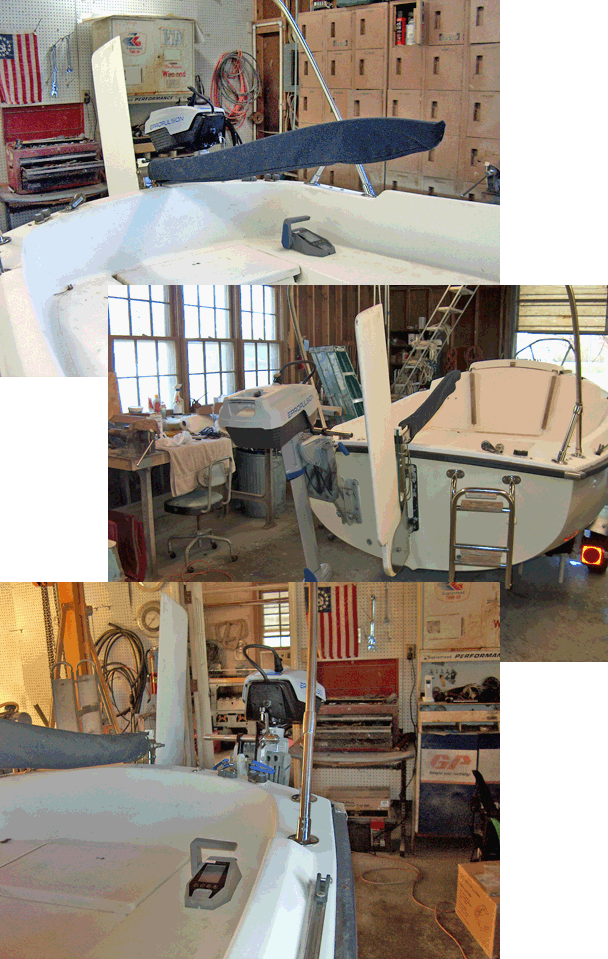
|
Hurricanes happen and boats fall off blocks and stands. Not at The Sailboat Company, but at other places. When a boat falls off of blocks in a Marina, it can do lots of damage. Notice the second small picture below. Many holes and cracks. The West System of Epoxy Resin and Glass is made to repair damage like this. After the repair was made, the next job was to make it look like it never happened. That's where a technician like Ron McCarten comes in. He did the repairs to the outside and the inside. The inside was almost as bad as the outside. He knows his business and he likes what he does and it shows. The finals touches will be done in the spring when the weather gets warm. Chemicals require heat to cure properly. Who can sail in the winter anyway?
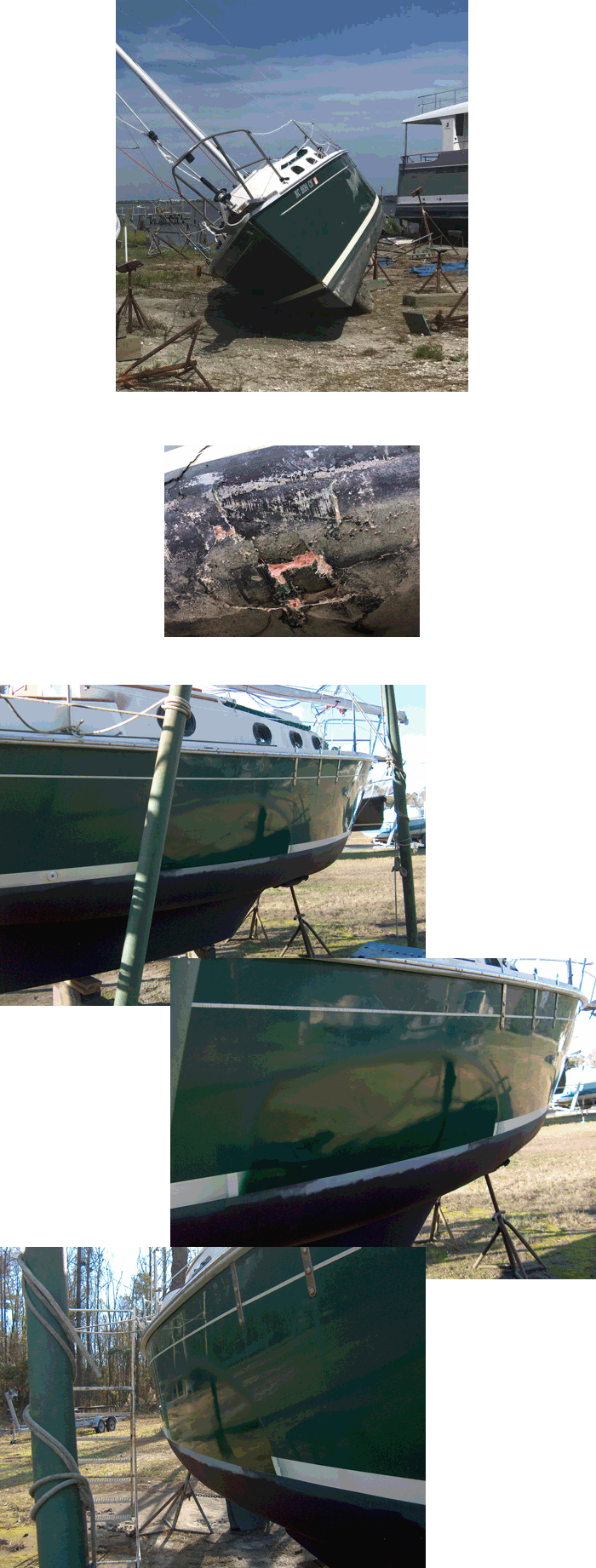
|
Just after President Obama was elected, a strange thing happened. Several Com-Pac owners brought me their boats and I purchased them for almost nothing. They thought the country was going to hell in a handbag. Currently, we have had a dry spot in sailboat sales for several years. It reminds me of the 70s when used and new sailboats were few and far between. I tried to find a used boat back then and all I could find was a 12-foot wood day-sailor. In the early 80s, we had a boom in new boat sales and that lasted until the early 90s when the price of oil and sailboats went up. We were getting our oil from the Middle East, which was a bad idea. Gas for our cars cost $4.00 a gallon and the government kept 25% of my social security check because I was in business. Depreciation on cars and trucks went from 3 years to 15 years. The government needed our money to support their social programs. Between the virus and what may come, small businesses will have a hard time staying in business. If you don't have a sailboat now, you had better get one soon. Gasoline is supposed to be gone by 2025 and sailing will be the only way to be on the water. Of course electric power with a solar source may be the answer. I have always liked fishing from a sailboat and we can all scull a sailboat if we have too. |
Are they talking about you! Maybe, some sailors can get really good at sailing and some not so good. What is good? Better still, what is great? I'm sure you have seen the Americas Cup Boats tacking up wind on TV. They are on a course and when they tack they pick up the new course in a smooth continuous extension of the first course. Some one-design sailors can do the same thing. They have a smooth continuous tack that really looks good. They do their tacks in light wind and in the heavy stuff and they are perfect. These sailors are good sailors that practice their tacks. They practice over and over again. If you do it enough, you are going to get good at anything. For the rest of us, there may be a better way to get good without putting in hours of practice. We know that most cruising boats can point to 45 degrees of the wind. Some more and some less, but we never know for sure how much. It could be the boat or it could be me doing lousy tacks? Is it the sails or is it the sailor? Who knows for sure? What if we had a method to record our up wind angles and also record our tack angles? And what if it did it automatically. Push one button twice to start and stop and that's it. If you and the boat's performance are worth saving, you will have to push another button or two. This cool program is riding on a cheap Android Tablet. It has been too hot this summer to do sea trials on the UpWind II program, but it's looking promising. In case you didn't guess, a perfect tack angle is 90 degrees for two 45-degree legs into the wind. I think this little bit of knowledge will tell us when to reef, when to buy a new sail, and maybe when to buy a new boat. If anyone can do the above, I would consider he or she to be a GREAT sailor. |
This Eclipse is going to have a light blue bottom. It's going to Lake Norman. Keep an eye out for it. It's what we call a pretty boat.
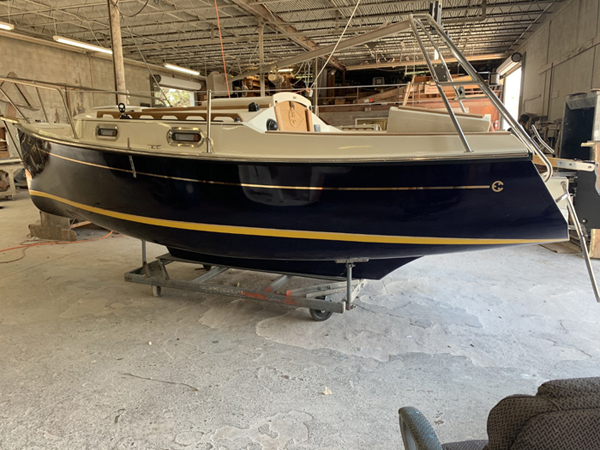
|
All Sailing Schools should have tablets with our "On The Wind" sailing program installed for every student. The program tells sailors how close they can point into the wind. Now, the automatic mode has only a start and stop click to make the program function while you are doing your best sailing. It's easy to do and now the program gives you one more additional feature. The program measures your tack (good or bad) along with your pointing angles. I have lots of new sailors that ask me why their boat point better on one tack than on the other. I explain to them if we had a river that ran north and south and the wind was out of the south; sailing into the wind going south would be pretty good. If the wind was out of the north and you were sailing north into the wind, pointing would not be as good. The reason for the difference is current. The keel below the water keeps a sailboat from blowing sidewise. The keel below the water also moves with the water when the water is moving. It's called current. Another reason to measure your pointing angle is terrain. Terrain can cause the wind to change directions in the middle of a lake. One time I measure my pointing angles and they were too good. The wind was bouncing off the terrain and changing the wind direction where I was tacking. I did one angle in one wind direction and did my tack and took advantage of the "lift" on my second angle. Like I said, it was too good and I didn't understand it until much later when I analyzed my data. As soon as we can, we will publish some pointing angles for the Com-Pac 16 and other boats. It's going to be interesting. |
Gerry at Com-Pac told me this morning that Magic Tilt has orders for the next two months. You can't sell a boat if you can't find a trailer to put it on. Gerry is concerned. Since we are the new Social Distancing Sport, everyone is buying boats. New or used doesn't make a difference. Of course you have to have enough money for a new boat. Used ones that are worth anything are few and far between. When it comes time to sail this fall, I hope we all have a boat or something to sail. The most popular boats are the small boats. Boats that you can put on a trailer and launch from a ramp and that's what we sell. The larger sizes that need a slip are still a little slow. That might change when we don't have any more used little boats to sell. The well is just about dry. I'm looking forward to getting some input data from our new sailing programs. If we get lots of data, we are going to be able to compare boat performance, area sailing conditions and of course sailors. Our software has got smarter. It tacks when you tack automatically and the curser on our map program follows the Tablet wherever it goes. I have been playing with the program when I'm in my car. The knot meter is in nautical miles per hour, but everything else is the same. So far we have a map of coastal NC on most Tablets and one program has a map of Lake Norman. We do custom maps for people buying a boat of their sailing area. |
Something positive: I think we might have a solution to the leaking centerboard housings on the 2000 to 2004 Sun Cats. We all know that the stainless housings had sharp edges and when the boats stayed in the water for a long period of time, the housings were damaged from electrolysis. You should never leave one of those boats in the water for a long time or just maybe; you can glass the slot on the bottom and sail without a centerboard. I'm guessing that the Sun Cat just might sail pretty well in light conditions with no board? I'm thinking the little boat will do pretty well until the wind picks up and then it's going to start going sideways. Some people don't like to heel that much anyway. Going sideways might be desirable when the wind gets that high. Someone needs to take a tablet and my upwind program and tell use the straight scoop. Can a Sun Cat sail upwind without a board and if it can, what were the wind conditions? We need to know. Thanks. |
We are currently installing a 1GM10 diesel in a Com-Pac 16. The only problem with future installs is the availability of the little diesel engine. They are no longer available in the United States. However, doing an electric installation will be doable and make for a very cool boat. My electric motor distributor has motors and batteries for any size boat. If we can install a diesel in a 16, we can also put an electric motor and batteries in a 16 and other Com-Pacs with centerboards too. We do cost estimates on request. |
Our Speed and Distance program on the Tablet that we give away with new boats has a map of your local sailing area. We haven't done a foreign sailing area yet, but I think we could and will with time. The little "X" on the map moves as you move. It's really not for navigation, but it will give you an idea of where you are in a pinch. I play with my tablet in the car when I go somewhere. Of course the program gives you speed and distance and records it for future use.
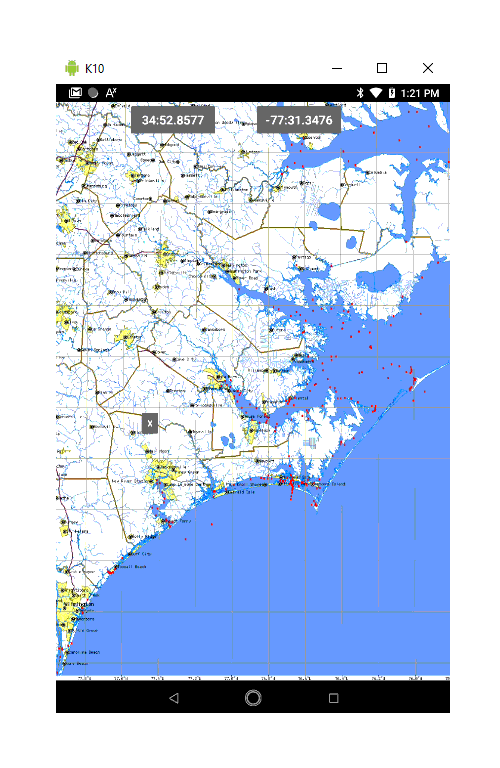
|
Paul Hofmann did our first remote installation of a Com-Pac 16 Gallows. Paul did an excellent job installing one of the best accessories for a Com-Pac 16. We shipped him the parts, he read the instructions and asked a few questions and then he did the magic. Not only does it look good, but it also holds the mast for trailering and stores the bimini where it is out of the way. Old men like me need one when getting on and off the boat. Paul did well.
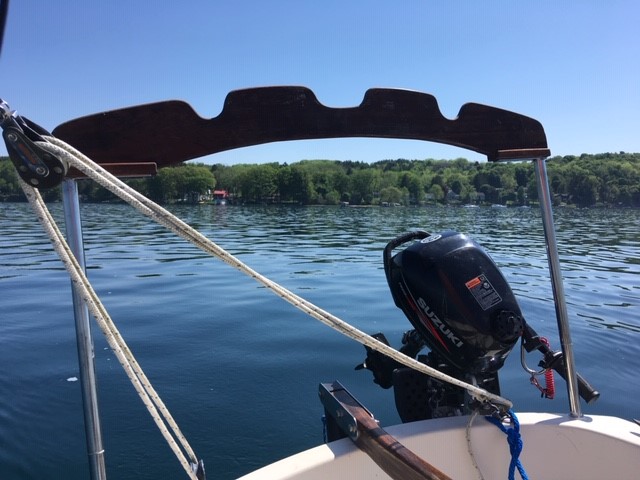
|
Hello David, I m glad you are doing well. We are the same here. We have a little bit of cabin fever from staying at home because of the virus. Hopefully the summer heat will kill the virus. Going up stream in any river is very difficult if not impossible. We learned down here on the coast that shallow water has less current than deep water because of bottom drag. We have times when the current is less and we keep track of those times. On the Ohio I think the current is about the same all the time. Most old sails are better sails for sailing than new sails. That assumes that the old sail are not damaged or blown out. I don t think you can blow 16 sails out made after 1979. New sails are hard to use until they get broken-in. You can use either Mark One or Mark Two main sails on your boat . The Mark II cost more because they have slides instead of a bolt rope and they come with one reef. The Mark I has a bolt rope and no reef. I don t think a new sail will help going up-stream. What you have is a common problem. I just wrote a software program that addresses that problem. The program records your upwind progress on two courses and one tack. You should be able to sail 45 degrees to the wind in your 16. The program puts you and your boat s performance into a database where you can compare apples and oranges over time. To make the program practical for most sailors, I plan on installing the program in a tablet and selling the tablet with the software for $250.00. Another program measures speed and gives you a knot meter and both can be used in the cockpit. The price of the tablet with GPS has come down where this is possible. Com-Pac and I plan on giving one away with a new boat purchase. I just wrote one manual for the first program and it s on the my Web site. I still have to write the second manual. All things being equal, you should be able to gain pointing ability when sailing down-stream. Maybe gaining as much as you lose sailing up-stream? We need to see the figures. Most 16 sailors over-power the keel causing less pointing. In light wind, sit on the low side aft and that will point the keel up another 5 degrees. The boat is going to follow the keel. Point up in gusts and you need to steer in a 3 degree slot. Luff and one side and a stall on the other. All jibs need tell-tales in light air to show the luffs and stalls. If you can t get a 3 degree slot with the jib halyard, you might need a new jib. Take care of yourself and avoid the virus. Keith |
Sailing is going to get bigger and bigger for everyone with social distancing becoming the new normal. No more crowds of people that could pass along that dreaded virus. We will all have to avoid crowds. Sailing is a great pass time that lets use do just that. And to make things even better, (This is the Big deal) we now a way to make everyone an experienced sailor quickly through technology. we have always needed a good way to teach sailing. Most classes where too far away, had bad weather, cost too much or provided insufficient time to learn sailing. You got a taste of sailing and that was about all that happen. The best way to teach sailing is on your own boat. I have done it many times. I see kids and old ladies playing games on their phones. Guess what, they get good a playing games. We can use the same procedure to get good at sailing. We can't use our phones because phone builders want a cut of the proceeds and they make it difficult to produce a program without lots of hoops to jump through. Most people have i-phones an they are the most difficult to program. The Android phone is less difficult to produce a good program, but fewer people own Android phones. The solution is a tablet that we can sell with our sailing program installed and we can also give it away with a new boat. The price of a small Tablet with GPS has come down where this makes it a practical solution for most new sailors. The lessons will be on the Internet and the homework will be in your hands. Get in your boat and lets get enrolled. It's going to be fun.
|
With our business next door, we are staying busy. We just helped a customer install a diesel in his Com-Pac 23. He had a pretty boat to start with and now it's even better because the boat will sail much better with a diesel. Boat builders build generic boats that most people can afford. A customized used boat could be a better choice for some sailing areas and also less expensive. A diesel in the Com-Pac 23 is a good example of that idea and a great choice for coastal North Carolina. In another lifetime, I programmed computers and got paid for my efforts. I also taught programming at Coastal Carolina Community College for about 3 years. I really enjoyed my students when their eyes lit-up when they understood what I was teaching. In the old days, I created GPS mapping programs and Hurricane Tracking programs. Programs like that are currently being produced in many other venues. The new GPS mapping programs are excellent. In my spare time, I have been working on a new sailing program. A talented sailor should be able to sail up wind well. He or she has to know their boat and lots of little details. The way you get the experience or "talent" that you need is to sail a lot and have a great memory or in this case, my little phone apps. Currently, the apps uses an Android phone with an installed GPS. Some time in the future, I hope to port the apps to I-Phones if we have enough interest. What the apps does is it gives you a course one and two and calculates the pointing angle up wind and records the results to a database. You won t have to have a great memory.
|
We are currently building Com-Pac 16s into Custom Center Console Boats. We might consider some other kind of sailboat based on the type of sailboat you own. You bring us a boat and between The Sailboat Company and the boat owner, we will build you a custom boat that you will be proud to own. You can learn the principles of boat building and most of the skills used by boat builders. Work as much as you like and the price of doing the modification will be adjusted accordingly. Working one or two days a week can really change the bottom line. I would say you need to be within 200 miles of Richlands, NC to make this oportunity work for most people. We are also currently installing a diesel motor in a Com-Pac 23. The owner is assisting us with the installation and saving money at the same time. He is going to learn fiberglass, gel-coat repair and in this case, how to rebuild a diesel motor. Teaching has always been a favorite vocation of mine. Knowing why we do what we do is the root of all knowlege in everything we do including the boat business. The boats in the pictures below are from the GA Com-Pac Dealer doing his thing with the Com-Pac 16 Utility boat.
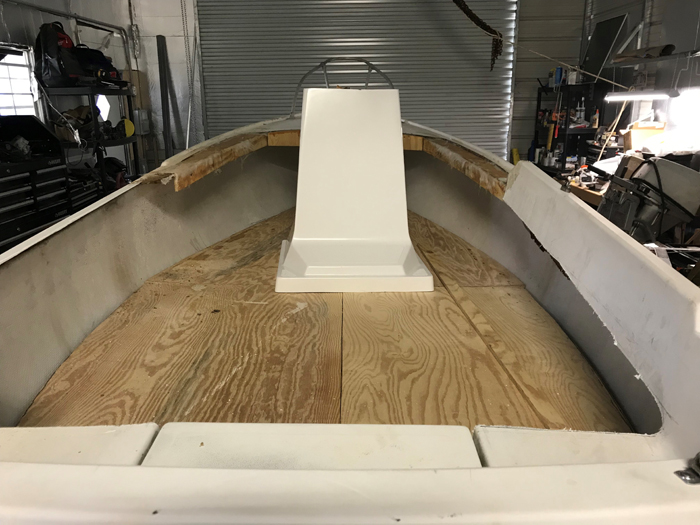
|
The reason most people sail is to get good at sailing. When you sail like you drive your car, you have become an experienced sailor. You don't think about the physical aspects of driving your car while you are driving. You are thinking about something else. To get there as a sailor takes time just like becoming a good driver takes time. We have noticed that a good sailing school shorten this period of time by allot. Now we have something else that going to shorten this period time. It's called a wristwatch made by Garmin. I purchased a Garmin Forerunner 35 for myself this Christmas. It only cost $92 from Amazon. I didn't know if it was going to work for sailing, but it was cheap enough to see if it would work. The good news is that it did. It's a watch designed for runners and not for sailing. Sailing and running move at about the same speed, so it should work and it did. It turns out that Garmin and Microsoft have come up with some cool software that's free to use with the Garmin watch. The watch and the software give you a great tool to measure your sailing abilities. The maps used with the software are outstanding and your track can be measured accurately on those maps. This is going to help us understand the terrain and why obstructions make wind direction change. If you sail in coastal waters, seeing how the current is helping or hurting our tack is important. The maps cover the World and they have great detail. After you understand the external forces that affect your sailing, what left is your skill in making the boat go forward. What you need is a watch and the Garmin Base Camp software. Microsoft GPX viewer and Recorder is also nice to have. You plug the watch into your USB port on your computer and it will synchronize with Base Camp. The watch creates a file with an extension of .fit. This file can be converted to a .gpx file in Base Camp if needed. A .gpx file is a standard for tracking software. You don't need to convert if you don't leave Base Camp. If you have a question about how a boat sails, you can send me a copy of your .fit file and we can talk about and see the same problem. It will be like going to sailing school with some great results. I plan on publishing submitted .fit files on my Web site so everyone can learn. I think I can retire my old race files from my Web site. Notice that the Green23 race file works in Base Camp. This system is going to be much better as a learning tool. Go buy a watch and send me your .fit file. Learning to sail just got better.

|
Gerry Hutchins and Ron McCarten have made raising and lowing the rudder easy on a Sun Cat. Gerry sells the modification and Ron came up with some needed improvements. You need to study the pictures to make your handle work as well as Ron's does. No more broken backs trying to get to that rudder handle.
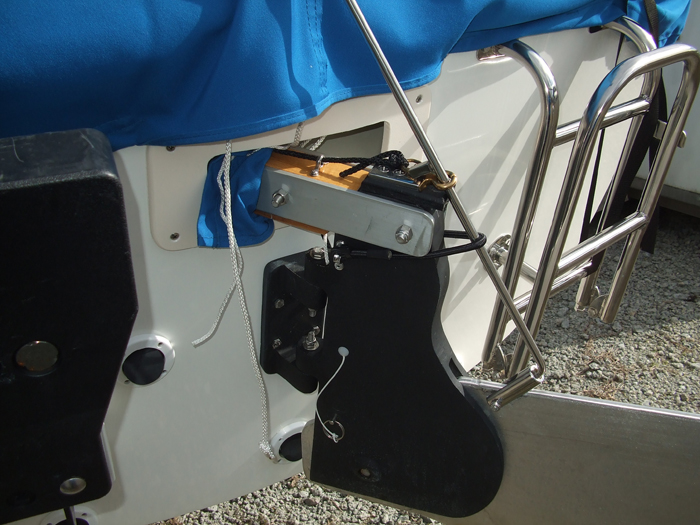
|
People with Com-Pac 16s love the way they handle. That 40% ballast ratio makes for a steady boat. How many times have you stood in the cabin and raised the sails. I can't count the times. What I'm getting at is that we can modify a Com-Pac 16 into a center console boat for about $4K. We are doing a modification now to a boat that we own and it's going to turn out really well. That boat is going to have a diesel motor and maybe a mast and sail. I think most owners will want the outboard version with the remote controls. The motors are not included in the $4K price. The Com-Pac 16 Utility Boat will have limited storage. It will have more storage with the outboard than with the diesel. The diesel is in the console and the outboard uses that space for storage. We only have a limited number of 1GM10 diesel motors available. The flat floor makes the boat easy to walk on and easy to clean. The included pedestal seats are comfortable and work well for fishing. The optional sail package gives you something to do when the fish are not biting. The consoles are made by Com-Pac and used on their Launch. If you own a Com-Pac 16 or some other suitable small sailboat, send me an email and ask for the Com-Pac 16 Utility Price List. The first picture is our concept boat; a 17 foot Herman Catboat. The second picture is a Com-Pac 16 Utility, hull number one.
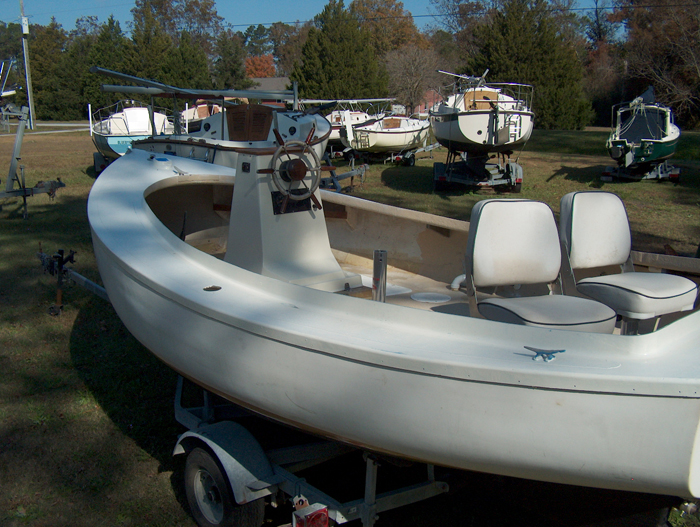
|
How many center console boat have mast? The answer is none. The problem is that I'm old school and when the engine quits, I sailed my boat home or to a marina. Most people don't do that today. They call Boat U.S. and ask or a tow. A tow wasn't available back in the old days and sailboats were supposed to sail if the motor failed and that's what I did. I don't plan on buying the Boat U.S. tow service although I sure its an excellent service. Since the center console is a diesel, my backup power could be an outboard motor or a mast and sail. I don't like the idea of an outboard hanging on the transom waiting for someone to steal when it s in a slip. Since I'm a sailor anyway, I guess our new center console is going to have a mast and sail. The boat started off as a catboat back in the 1960s and I guess it's going to sail again. Sitting behind the console and sailing should be interesting. We will have pictures soon. |
If you own a Com-Pac 16 Hutch Trailer and it hasn't had it axle changed, you might need a new axle. The way you can tell is if the wheels have negative camber or if they are not straight up and down The picture below shows the angle of the wheels when the axle needs to be changed. The metal in the axle disappears because of corrosion next to the wheels. We have had them fail on the highway and that's not good.
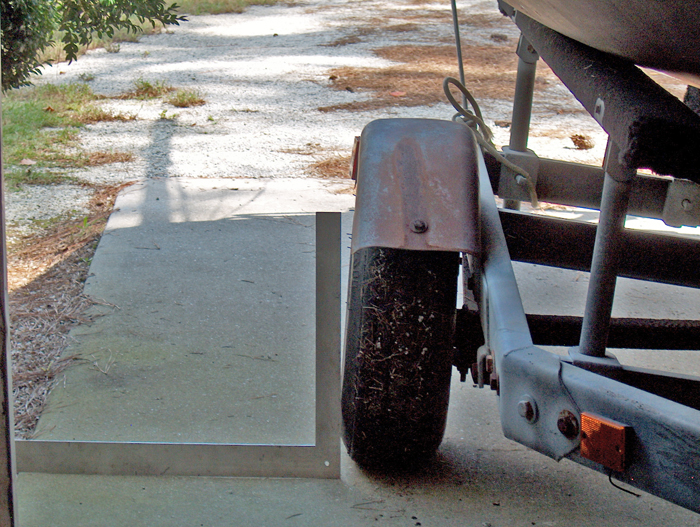
|
Some lake sailors might want a Sun Cat with a little more sail area. A Sun Cat with more sail area could be a competitive PHRF racer in some locations. Squeezing the air between the jib and main could make the little boat point really close to the wind. Clark Mills built both configurations and he let the customer choose the best boat for his or her area. Com-Pac is going to build a kit that will convert a standard Sun Cat into a sloop. The boat will use the current sail as a main sail. The mast will be moved back to a location behind the see though hatch. New components will include a new forestay and a furling jib. It will also include genoa tracks and cars for the jib. The mast is going to stick out a little more when trailing. The one handed mast raising system will work the same way and the mast in the cabin will give us something to hold on to when moving around the cabin. Just about everything on the standard boat is used on the modified boat. That's going to keep the cost down. Lots of lazy sailors will love sailing with the jib and leaving the main under the sail cover. |
The big Show starts tomorrow and Com-Pac is going to have a Sunday Cat and a Sport at the Show. North Carolina sailors can drive up there in about 5 hours and see those new boats. |
It wasn't a big show and it was hot, but we enjoyed talking to the people in Jacksonville. The little Legacy looked small with the larger powerboats at the show. We talked to some of the city officials and they told us the new marina in Jacksonville was waiting on the contractor. We are thinking about starting a new sailing school in Jacksonville and employing some of our retired schoolteachers as instructors. Morgan Bay is one of the best places I can think of to hold classes on the water. We will report progress as it happens on this Web site. 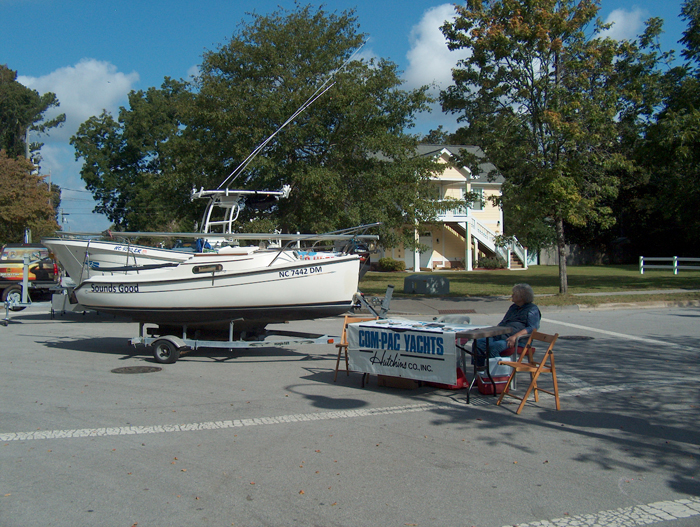
|
Ron McCarten has made some major changes to his almost new Sun Cat. His engine modification is really cool and I can't see why anyone would do anything else if they were buying a new Sun Cat. Some Com-Pac sailors with older boats might consider a change in their equipment if they use their motors allot or have short arms. We are going to consider this configuration for our new center console Com-Pac 16. 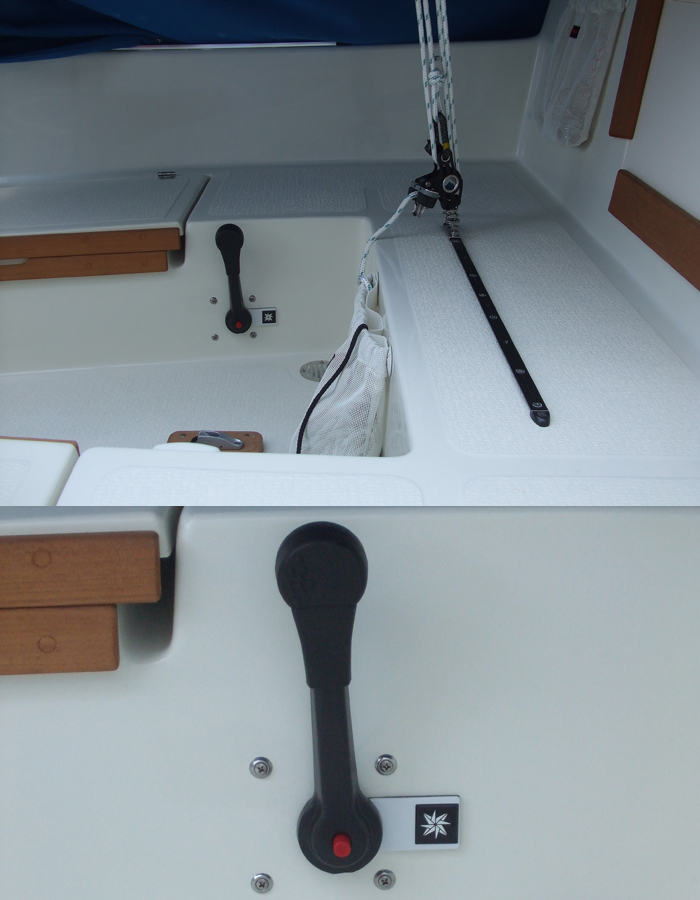
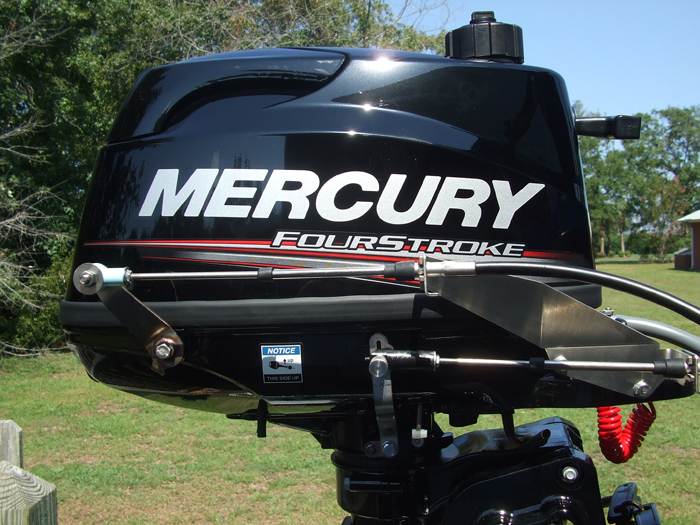
|
Most of you know that The Sailboat Company has been working on a center console fishing boat. The boat started off life in 1968 as a Hermann Catboat. I'm sure it provided lots of enjoyment to its owners through the years as a sailboat. Its sailing days came to an end when the cost of repairs was going to be too great for the boat to continue as a sailboat. However, the old Hermann had some beautiful lines and some strong construction. They put extra fiberglass in those boat back then. What the old girl gives us as a fishing boat is a boat that's as steady as a pontoon boat, but more seaworthy in wind and waves. You can standup in this boat and feel good about not falling over the side. As rag sailors, we all know what ballast has done for use in the past. It makes us look good, even when we screw up. Ballast is a wonderful thing and I would never own a boat without it. Some of our larger conversions will have diesel power and the smaller boats will be outboard powered. We are presently building a 1976 Com-Pac 16 as a center console. From my experience, I know that lots older customers stop sailing because of the physical effort required to sail. Being on the water for most sailors is part of our life and it's difficult to quit cold turkey. With a little self-bailing center console that has an electric start outboard and a smooth ride should be just what the doctor ordered for our seniors. We might even sell a few boats to fishermen that want a super ride at a good price. We hope to sell the first few CP-16s for $10K including a black hull, off white deck and a new 9.9hp motor. We will build you one with a deposit. |
2Jun2019 A Fast Way To Get Good At Sailing:
A young sailor was at my shop recently asking questions about his boat. While he was here, he showed me a picture of his mainsail. He took the picture while he was sailing on the wind. A light bulb went off in my head. All our new sailors have cell phones and just about all cell phones have cameras. If you want some help with your mainsail trim, I think I can help. I need two things to analyze the condition of your mainsail and your mainsail trim. Send me a picture of your mainsail while you are sailing on the wind. I also need to know the wind strength as follows:
| Wind Speed Water's Surface | |||||
| 0 to 2 knots | Flat Water | ||||
| 3 to 5 knots | Dark Spots on Water | ||||
| 6 to 9 knots | Dark Water Everywhere | ||||
| 10 knots | One White Cap Anywhere | ||||
| 12 knots | White Caps Everywhere |
Some Com-Pac boats had bad sails before 1980. We can identify those sails and maybe help some sailors with suggestions on trim and how to do it.
Send me a picture of your mainsail, who built your boat, the year and the wind strength via email and I will give you my opinion on this Web site. This is going to be fun.
A professional artist is doing hatch board art for sailors. Most sailors would love to enhance their boats with a personalized hatch board. A Web site to get connected with the artist is: Custom Hatch Boards
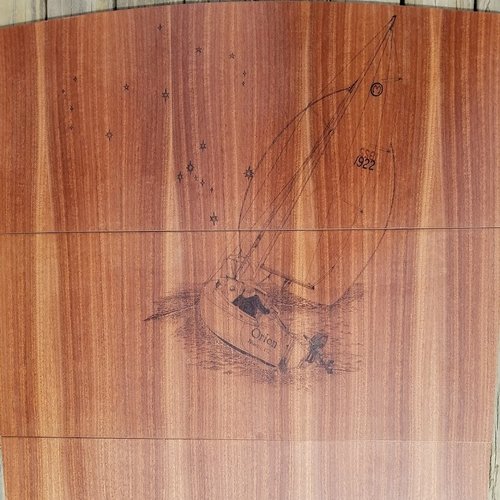
|
Would you believe the Factory has built 500 Sun Cats? It has and number 500 is coming to North Carolina. The boat's new home will be in Washington, NC and she going to sail on the Pamilico River. This is an excellent boat to sail where Blackbeard sailed in his home waters. The Factory is also building a new Legacy Sport. The first boat will be going to the Annapolis Boat Show this spring. New features include a mast raising system and furling gear as standard. This is going to be an affordable day sailor for most families. |
Two Com-Pac Catboat owners in Chapel Hill, NC got together to fix a persistent leak in one of their boats. They found the leak that had been around for years and then they came up with an inexpensive fix for the problem. You may have the same problem if you own a Sunday Cat. One of their boats was located at Crosswinds Marina on Lake Jordan. That boat would have wet inside cushions from time to time. The owner knew he had a leak, but where was that ### water coming from? No one goes sailing when it s raining and the boat always leaked when no one was around. Two great minds got together and they found the source of the leak. They may have used a water hose? When it rained big time, water ran down the mast raising system halyard. They both came up a great idea to fix the problem. The device is called a Leak Defender or maybe a bungee cord in some circles. It looks like a cool device that works. See picture below.
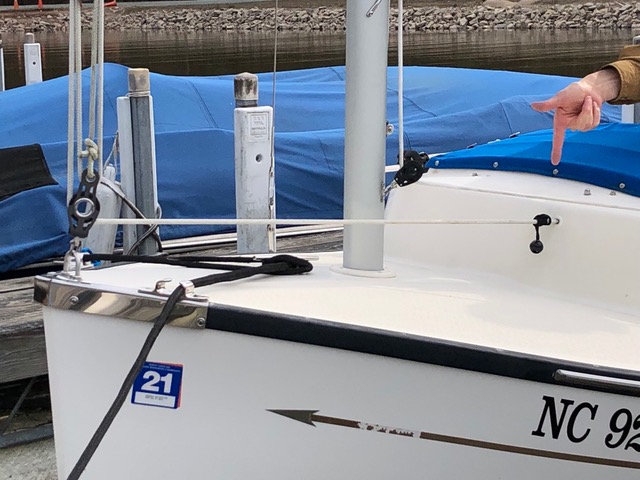
|
6Mar2019 Old Boats Never Die:
I recently received an email from the son of the original owner of a boat on my yard. The boat is a 1979 Sun Cat designed and built by Clark Mills. He was wondering if it was the same boat. It is the same boat. This boat has a long history and I only know parts of what has happened to this boat over time. I think it started life with a gasoline engine in 1979 and had a new diesel replacement engine in 1999. It was restored with a new hull and deck paint sometime during the last 10 to 15 years. Maybe it was in 1999. The boat had a wood fixed mast when it was built. A new Horizon Cat mast, boom and gaff were installed last year. The boat was sold to a southern owner several years ago and the trailer for the boat was purchased then. The boat spent most of its life in the northeast where a trailer isn't practical. Clark looks as I remember him in the picture below. He was a great man in my opinion. The boat is pictured in his marina in Clearwater, FL. The marina looks about the same as it did when I was buying boats from Clark.
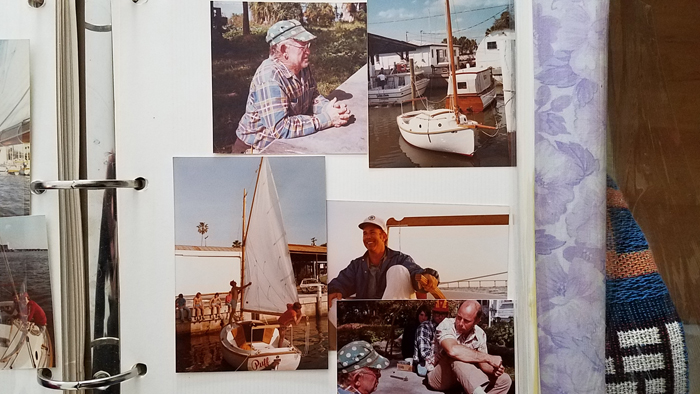

I'm sure most of us know the problem with electric motors in sailboats is keeping the batteries charged. We have tried solar panels, more batteries, helper diesel motors and other solutions. Some solutions work on larger boats that can support the additional resources. Smaller boats normally have limited capability. You better know how to sail when you choose an electric motor for auxiliary power on a small sailboat. In our southern coastal waters, we sail or motor great distances to see the wonderful areas of the coast and the barrier islands. They are full of white sand, sunshine and lots of history from the beginning of our country. We call that process coastal sailing, but in most cases we motor though channels or cuts to cross large shoal bays to reach our destination. Our mechanical motors have to work well. The price of an electric installation is about the same as a diesel motor. That's progress in itself. The small boat installation only uses 3 batteries. That helps keep the cost down and reduces the space needed for an installation. So far so good. To make it work for a long distance cruiser, we need one more important feature. As you guessed, a way to keep our batteries charged. A Com-Pac 23 installation would include The Sailboat Company's rumble seat with an extension for a small Honda generator. The generator would be permanently mounted in a weather-resistant vented white box with a top. The same safe location an outboard motor would normally occupy. Re-fueling would be safe with spillage going over the side. Spare fuel would be kept in the outboard fuel locker that is vented to the outside. The small Honda generator would provide a constant 3.8-knot and the next larger generator would give you 4.5 knots. I think I could get to Silver Lake on Oracoke Island at that speed.

|
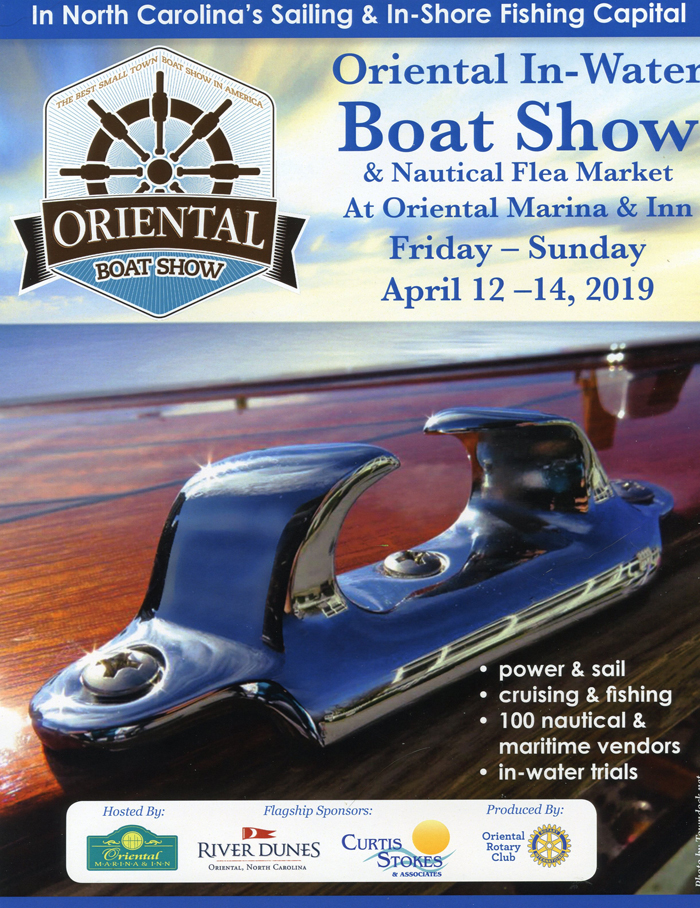
|
If you own a Com-Pac 16 and it s not equipped with a boom gallows, you are doing more work and enjoying sailing less than you should. The boom gallows on a 16 is really not a boom gallows. Our boom gallows is designed as a mast carrier, bimini storage location and a supper handhold for moving the boat around at the dock. We built our first boat with a real boom gallows that would rest on the boom and eliminate the topping lift. When sailing, the boom has to clear the gallows and then provide enough headroom in the cockpit for captain and crew when the mainsail is down. The first boat was a little short on headroom and was difficult to build considering the boom on the mast might vary from time to time. The pretty little boat below sold to a California customer for $10,000 back in the 80s. It was our only 16 with a true boom gallows.
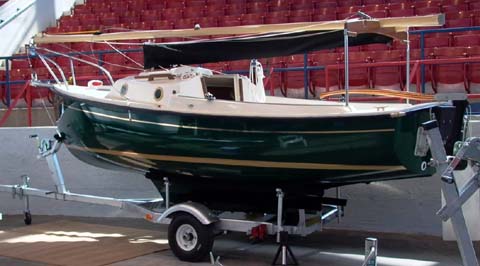
Our current version the 16 boom gallows carries the mast when the mast is down. We go down the road with the mast in that position. The laws in North Carolina say if you project anything beyond 3 feet behind your vehicle, you must identify the object with a red flag. Most other States have similar regulations. The masts on our 16s project less than 3 feet beyond the rudder when it is in the up position. Boats in NC have trailering their boats that way since 1983. We have had no accidents and no tickets. You can see that putting your mast in the gallows and not disconnecting it at the mast step saves time and effort at the launching ramp. Easy mast stepping means more time for sailing and that s important.
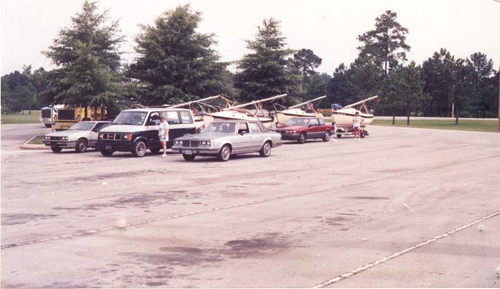
Everyone is concerned with skin cancer and being in the sun for too long at one time doesn t help that concern. The only satisfactory method of storing a bmini on a 16 is with it leaning up against the gallows. It allows room for the crew to get to the engine and into cabin without moving the bimini. Other locations for storage on the 16 always place the bimini in the way and require constant relocation to get it out the way. A bimini needs to be available when required and also have proper storage so it doesn t interfere with sailing. Most people without a gallows keep their bimini in their garage. They never have it when they need it. The only solution for too much sun is a boom gallows.
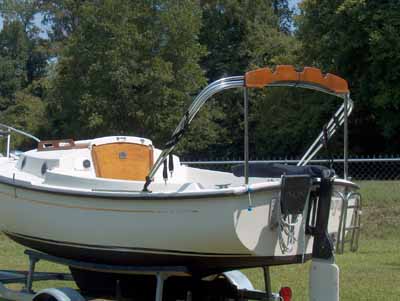
|
The birds know about hurricanes. They leave the area and stay gone. I haven't seen a bird in 3 months. We normally put out food for birds during the winter. This winter, the popcorn on the ground stays on the ground. It s odd not to have birds sitting on power lines during the winter. The blackbirds normally stay around here in the winter. We are seeing some improvements sense Florence. Anytime people rebuild, whatever that's being worked on is going to look and work better than before. That's the case with Florence. All of us down here on the coast are working to repair the damage caused by hurricane Florence. The roofers are really busy. Medal roofs did well and old shingled roofs did poorly. More people flooded from old roofs and rain than from water going through their homes in low areas. Wet insulation in the roof can be a mess. I'm glad the people that built my house didn't have enough money to afford insulation in the walls. Our brick walls works pretty well as insulation and they can't be damaged by water. The new Jacksonville, NC marina is still being built. They are behind schedule. It was suppose to be ready by November last year. The Marine Corps Air Station Marina was blown away by Florence. It had fixed docks. Everyone that had a floating boat after Florence moved to the Camp Lejeune Marina. They have floating docks and weathered the storm well. In general, marina with fixed docks had dock damage caused by the storm. Reports from Duck Creek in New Bern are that they are back to normal after the storm. Some reports from the field are disappointing. Insurance companies have totaled boats that took on water during the storm. Their diesel engines were underwater! The insurance companies paid and then they gave the boats back to their owners. A little known fact about engines and electrical motors with switches is that they will work after being wet. We have been saving diesel engines, outboards, washing machines, refrigerators, and electric stove and so on for years. The only difference between a diesel and a gas motor is that the carburetor has to cleaned on the gas motor. The injector pump on the diesel doesn't. The kitchen appliances have to be dry before you put power to them after being flooded. Of course, you have to drain the oil and water from the engine and service the engine with new oil. The starter might work after being drained. If not, that will be the only item that will need special attention after a flood. Owners that have boats with a dead engine normally can't sell their boats for any price. A new engine is going cost a lot more than a service call on the old engine. It's still not too late if an owner can turn the engine over with a wrench. |
Com-Pac is selling lots of boats and The Sailboat Company has lots of interest. Clean used boats are still the hot items in our sailing market. The Sailboat Company has decided to make it even better. We have been doing full restorations for years on older Com-Pacs and that cost money. Some of our used boats are going to be offered for sale with only a minor restoration. They will have major items replaced that need doing like trailer tires and bearings and other boat equipment that is too hard for the average individual to handle. Buff and wax, bottom paint and teak refinishing will be optional items. The cost of a boat will be much lower for the DIY sailor. The other big news is electric motors for our 27s and 23s. When it's replacement time for the old diesel, you need to consider changing to electric power. The solution to our running time problem may be a Honda generator. Crank up the super quiet generator and that's going to keep those batteries happy for a long period of time. Maybe long enough to go to Cape Lookout or Oracoke. The price of an electric installation and a new diesel is about the same. A new installation in our outboard boats will cost a little more because a shaft has to be added. |
Almost all of our boats did well during Hurricane Florence. We did have two that got loose during the storm. Our little Cape Dory Typhoon moved to the edge the creek on its stand and our Yamaha 25 came off its trailer and ended up on its side next to the shop. We picked up the Cape Dory last week on a Magic Tilt Com-Pac 23 trailer. The trailer can put its first roller on the ground. We winched the boat aboard the trailer and pulled her out of the creek area. I guess we could have floated her out on the next high water, but the leaves from the trees kept clogging the cockpit drains. The Yamaha was going to be a bigger challenge. The Yamaha draws 4 feet and its displacement is 4700 pounds. I didn't take any pictures of our Yamaha 25 when it was on its side. I don't like looking at sailboats lying on their sides. It hurts my eyes. Picking up a sailboat that on it's side with a crane normally causes some damage to a sailboat. A hull to deck joint isn't designed to take that much pressure. Toe rails bend and other bad things happen with a crane lift with a boat in that position. About two hours of digging and a few other tools put the Yamaha on an even keel where a crane can do a pick-up without damage. We had to dig a hole for the keel and a smaller hole for the drive shaft and prop. The rudder also has its own hole. The sandy soil was an easy dig for two men. We connected a come-along to a sheet winch on deck with a truck on the other end. We also used a floor jack and boat stands to rotate the boat almost 90 degrees. The keel is currently on the ground in the hole. The boats looks a lot better and it's going to look even better when it gets back on its trailer.
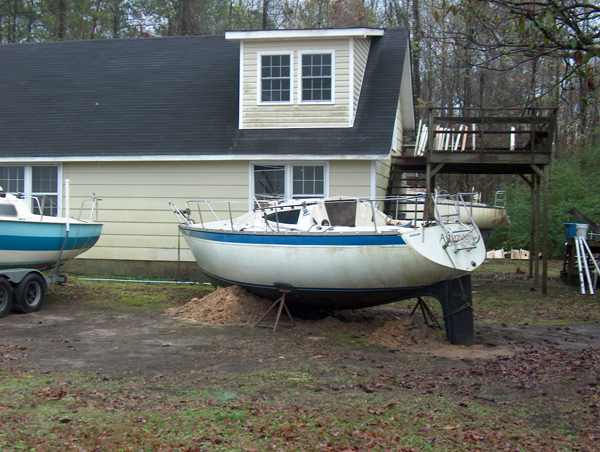
|
The Annapolis Boat Show was really good for Com-Pac. They sold 3 new Sun Cats based on the modified boat on my homepage. A local experienced sailor wanted a Sun Cat made to his specifications and the factory built the boat. It has really been a super success. Everyone likes the stainless handrails and the bow pulpit. The boat also has a new modified ladder that's going to be a big improvement over the old ladder and poly-board in the gas hatch instead of teak. The Sun Cat continues to be the best selling boat for the buck and the most popular boat that Com-Pac makes. The Insurance money has been distributed to the sailors that lost boats in the recent hurricane. They are looking for good replacement boats now. Good clean used sailboats that look great and sails great are few and far apart. They have a choice between new, restored or old and similar to what the lost in the storm. They need to remember that one boat can t do everything. The most important item on my list of important features is the ability to teach my grandchildren how to be sailors. Some day they will take you sailing. We have lots of used boat on the yard and we normally sell restored boats. Some sailors like cheap better than restored and we have a plan to offer some boats on Craig's List. They will be DIY boat projects for sailors. We can tell you what the boat needs and you can do it yourself or not and save the cost of restoration. We currently have a plan to teach sailing in Com-Pac 16s early next year. It will take place at different locations over several months. We currently have 3 sailors signed up and we hope to have lots more. See and do is one the best teaching methods available. Everyone will need a 16 to participate. This winter will be the time to tune-up your boat and get it ready for the TEACH-IN in the spring. |
The wind blew and the boats floated. We have about 23 boats on the yard. Our plan was to tie the boats to the trailers and if we flooded, the boats would float with their trailers and come back down on the trailers when the water receded. It worked and we had no major damage to our boats. We still don't have power in our shop, but we are hard at work using a long extension cord to the house. We just completed work on our first customer's boat since the hurricane. I hope everyone did as well as we did with the hurricane.

|
The Sailboat Company sells bargains and a customer in Texas identified one that we had for sale. A new Rhodes 19 sells for $30K and we sold our 2009 model for $4.5K. That's a bargain. He drove from Galveston to Richlands and back again to get his boat. We have sold used boats to Germany and Alaska and other far off places. Our bargains have lots of new parts and pieces. That's what makes our boats bargains. They are almost like a new boat, but at a much reduced price. We just sold a new Sun Cat and the boat will be on our yard in about 5 weeks. If you are thinking about a new Sun Cat, you might want to take a look. The new Com-Pac 23 Pilothouse is going to be berthed in Oriental and will be available for showing by appointment. Send Keith an email if you are thinking Pilothouse. |
The picture below is our hard dodger on a 23 in its summer position. Everyone needs all the air they can get when it's hot. The winter version will have front windows and side curtains with windows. It will extend our sailing season.
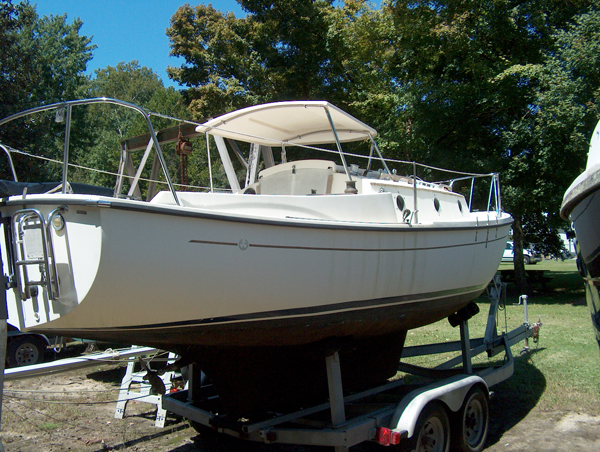
|
If you happen to have a sailboat in the backyard that's not doing anything, any kind will do, we can make it into a British Launch. A Catalina 22 would be a good candidate for modification or most anything else. When some sailboats get old, it takes too much money to restore them back into an operational sailboat. Most of the hulls are in great shape, but everything else really looks bad. In some cases, the older the hull, the better they are. Why not make them into a center console boat with ballast and a diesel. Of course an outboard will work just like a diesel and maybe cost less. Our first boat is going to be a diesel. The engine is going to hide under a cushioned seat and a center console will hold the instruments and steering wheel. This boat will have a Yanmar 2GM20 for power, a bilge pump to keep her dry and a portable fuel tank because diesels use so little fuel. The hull color is going to be black with a beige deck. All kinds of sun shade is possible, but we are not sure yet what kind of canvas we will use. It's going to be fun!
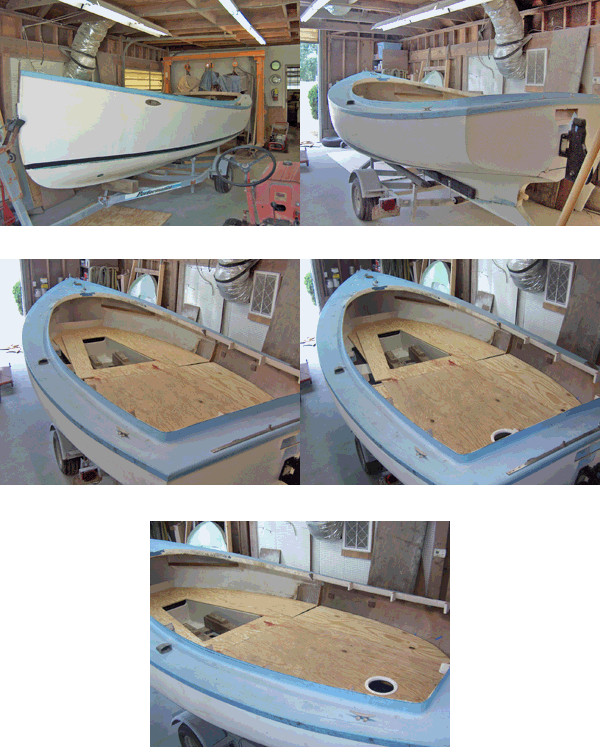
|
The Com-Pac 23 and 19 hard dodger is coming along just fine. It gives sailors some shade in the cockpit and standup headroom in the hatch area. You can leave the hatch open when it rains. This dodger comes with or without windows. All models fold down for transport. The pictures below show the dodger folded down for transport and storage. We will have more pictures soon.
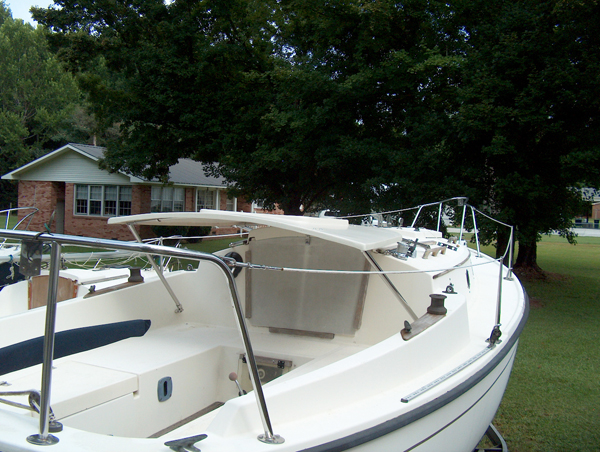

6Jul2018 Com-Pac 23 Trawler Available :Who can't afford a great looking boat at a much reduced price? People interested in Trawlers can get a new Com-Pac 23 Trawler for $46,350. It's a Pilothouse without a mast and sails and includes a 10% discount. The engine and all the options are extra. The outboard version steers with the rudder and the engine controls can be mounted inside next to the wheel. The sailing version is just a little more expensive if you need to sail.
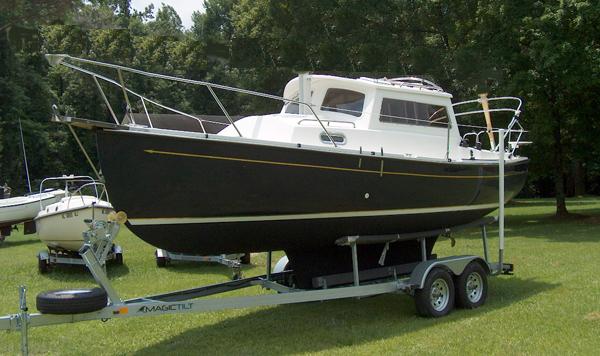
The new Pilothouse 23 will be at Duck Creek, New Bern for a few weeks. Stop by and see her in the water. She is a very pretty boat. The Sailboat Company is taking orders. The price of a new outboard version of the Pilot is very interesting. Ask Keith for quote. |
This is as good as it gets. The best of what Com-Pac makes will be sailing North Carolina waters.
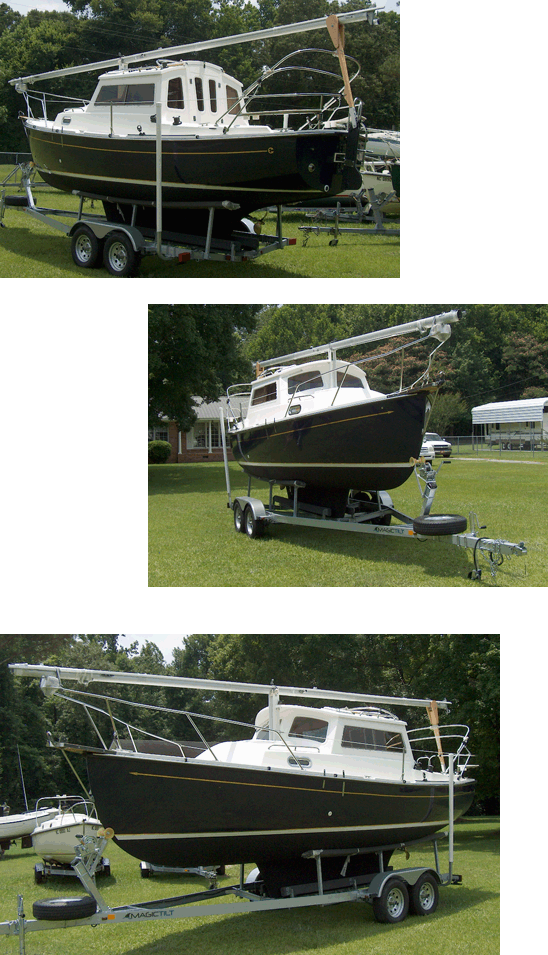
|
How can I tell if my sails are good or bad? If they are new, you can skip the following information. Some of us are sailing boats that are old. The sails are old and they were designed poorly when they were new. We are trying to make them sail well and in some cases, this just isn't possible. Lets use a mainsail as our example. The conditions for the jib or genoa are the same. We put the sail up the mast and go sailing and point our boat into the wind. I don't care about the hardware on the boat or where it is located. I'm going to look at the mainsail. The first thing I'm going to look at is the chamber and where it is located. What is the chamber? It's a portion of the mainsail that's tight and travels from the boom to the head of the sail. The tight part of the sail is fabric that you could throw a dime or quarter at and they would bounce off. If you threw the dime or quarter at either side, the coins would not bounce but would fall to the deck. The shape of the chamber should be even and proportional, as it gets higher on the sail. If it's 24 inches at the boom and then goes to 48 inches a few feet up and then back to a smaller size as it goes higher, it's likely that you have an old blow-out sail. Our sail on this boat looks good with a good-looking chamber area. We notice that we have some weather helm at the tiller and the chamber is located aft of the fifty percent point on our boom. We increase the main halyard tension to move the chamber forward to the fifty percent point and reduce the weather helm. We also make sure that the top the sail has twist. A tight mainsheet can stall the top of the sail. Let the mainsheet out until the sail has twist at the top. All the tell-tales should be flying off the leech of the sail. You only have 3 degrees of trim adjustment available to you while you are pointing. One side is a stall and the other is a luff. Some people sail the luff because you can't see a stall except with tell-tales. How good are your sails? |
I was talking to a friend in England and he told me the following story about the Southwest corner of the Isle of Wight. He said: Those islands are outcroppings of chalk, ergo they are white. Funny that you should mention them as a starting line for sailboat racing. Last year, at the big Around The Island race, think almost 1,000 sailboats, one of the entrants was a very classic entrant. Think wood, originally made in the 1930 s, and spotlessly maintained ever since. As race day approached (Cowes Race Week), the owner, who was always the skipper took ill. Well, his good friend, that always was in the crew volunteered to skipper the boat in the race.So far so good. when he approached the Needles (the outcropping you saw) for whatever his reason, he elected to sail between the rocks, saving some distance.Well, the tide was out, the water was very thin, and he tore the bottom out of the boat and it sank. It is still on the bottom. It seems to be one of those things that if it worked, he would be a hero, and if it didn t, and it most certainly did not work, he is the village idiot (and he is).

|
Little diesel motors are no longer available in the USA. They are raw-water cooled like every outboard motor ever built. The EPA is saying no to little diesel imports. It's funny how that works, but that's the way it is. Anyway, The Sailboat Company has three almost new engines that can be installed in Eclipse sailboats. The Eclipse is really too small for the next larger motor. A limited number of Eclipses were built with diesel motors and they were wonderful. It's a small boat on a trailer that launches well and has a slow smooth running motor. It doesn't get any better than that. |
We have enough 16s to do some sailing together on the New River. If you want to learn sailing and if you have a 16 and if you can come to the New River in Jacksonville, NC on Saturdays, let me know by email. If we can get 3 boats at the same time, we will do some teaching and have some fun on the New River. Let me know if you are interested and I will organize the sailing dates and let you know by email. Like I said, we need at least 3 boats to make it worthwhile. Send me an email and let me know. |
If you own a Com-Pac 16, you may own the best looking sailboat ever. These two pictures were selling other items in the current edition of Sail Magazine. Cool.

Check out the Keel/Rudder Lift conclusions on the left. We may have solved one of the big mysteries of sailing. How well does your boat point? |
With Snow in North Carolina, everyone around here would love to be sailing in Hawaii. John Climaldi and his Com-Pac 16 belong to the Waikiki Yacht Club in Honolulu, Hawaii. He said that he has the only Com-Pac in the Islands and everyone comments that he has a pretty boat. He plans on sailing around Oahu sometime soon. We will report his adventures when it happens and maybe we will see a picture or two.
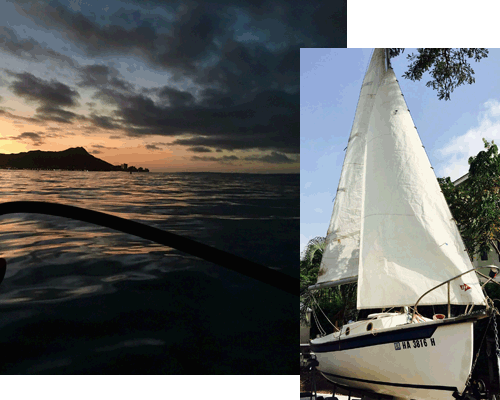
|
The 27 on our homepage with the radar arch belonged to Richard Summers. He was pretty old, but he wanted to see more of the country by boat. He knew that was best way to see the country and met lots of fine folks was on the waterways. He had previously circumnavigated the east coast in a Com-Pac 23 and he wanted more room to live on the boat and be comfortable. The Sailboat Company installed all kinds of navigation equipment, refrigeration and air conditioning in his new Com-Pac 27. We packed it up and I trailered it to Florida to be launched there. We didn't install the radar arch until we arrived in Clearwater. Richard sailed the boat across Florida to Fort Pierce and took up residence in a nice marina. It had great showers and a restaurant on the grounds. They served an outstanding breakfast. After about a year of enjoying the marina and Florida, Richard decided it was time to move on to the Keys. He asked me to join him like I had before in the 23 when we sailed down the Delaware River to Cape May. We enjoyed Fort Pierce for the last night and the next morning departed out the inlet and headed south. Our next destination was Lake Worth, Florida, about 60 miles as the crow flies. The first part of trip was in the ocean and then the rest was via the ICW. We had some excitement on the way and I have some good memories that I will never forget. After doing our thing in the Keys, Richard took the boat to Texas with another crewmember. After all that travel, Richard s boat, the Harriett II came home to New Bern. The boat posed for the picture that you see on our homepage for the New Bern Chamber of Commerce. |
The Com-Pac 27 owner that has his boat for sale on my used boat page sailed a lap around our Neuse River Race Course. You can see him sail around the course on our "Pick A Race" link on the left. I think it might be interesting to talk about some the details of his sail when it's too cold to sail. If you have a boat on the Neuse, you might want to pick-up a recorder at The Sailboat Company and try to beat his time next summer. Now is a great time for analyzing and next summer will be a great time to run a race. You turn the hand held GPS receiver on and lay it down in the cockpit. You start sailing between marks 22 and 24 towards the white Duck Creek Marker. The 27 had the wind out of the northwest and that s good for several reasons. The upwind legs would be over shallow water that water has less current. The downwind leg will have less relative wind, (you add boat speed to wind speed for upwind and just the opposite for downwind) but the deeper channel water will produce more current than the shallow water. If you have less wind, more current will help. He could have sailed the course at any time, but he picked a wind direction and speed that was good for this course. He laid a course for the white Duck Creek Mark and only tacked one time. That's not bad considering he was sailing by himself. You have your hands full with the sheets and wheel all at the same time. He came within one boat length of the marker and tacked. The next leg had wind obstructions caused by the high-rise bridge. The angle of the wind to the course didn't cause problems until about the middle of the leg. The boat images looked red and consistent and then they start adding white to the images. That's the boat being affected by the bridge. As the boat approaches the bridge navigation channel, the boat falters and has to be corrected with helm. Some of the wind was blowing through the bridge where the bridge construction allowed the channel and the wind to pass to the other side. The 27 made a big correction and continued to the next mark. After rounding the mark, he set the boat on a broad reach. He had some wind obstructions from the terrain the bridge that caused gusts. On two such gusts he reached 7 knots of boat speed. I'm sure it felt like he had a tiger by the tail. The wind was blowing over 12 knots, which is an excellent wind speed for a 27. The finish was between marks 22 and 24. We consider the course length to be 2 miles. The 27 has a rating of 237 seconds. You take twice the rating or 2 miles worth of rating off the total time sailed in seconds. That's his finish time and that's how PHRF ratings work. The owner remembered to turn off the GPS by pushing the off button. It will turn itself off if you forget to turn it off. The Sailboat Company takes care of the calculation and posting the data on the Web. Come see what you can do! |
I just received a call from my favorite sail makers and their backlog is zero and they can make your new sails before Christmas. After Christmas, Super Sailmakers will be busy and everyone will be waiting for their new sails. Spring is a bad time to order sails. Check with them at www.supersailmakers.com. Good prices and excellent builders of Com-Pac sails is what they do. |
You can see how well a boat sails by looking at the Performance Data available on our used boat page. Click Performance Data next to each boat's name. We can't do it for every boat, but some of our boats will include this feature. The owner of the Com-Pac 27 listed on our Used Boat page recorded his boats performance. It shows good pointing ability and excellent speed. River current was less on the shallow upwind side of the river and greater on the deeper downwind side. This may have improved his downwind speed. Sailing on the leeward side of the New Bern bridges with all their turbulence was precise and well done. A boat with a less accomplished shipper would have not sailed as well. |
A North Carolina customer will be getting a new Com-Pac 23 Pilothouse in 2018. This one will have all the bells and whistles and may be the perfect boat for this area. A boat that can go anywhere by water or road is about as good as it gets. I have talked to lots of old customers over the years that remember the wonderful experiences they had with their 23s. You add the standing headroom of a pilothouse and it only gets better. Maybe I can talk the wife into getting me one for Christmas. |
Buying a new mast for your sailboat is expensive. Com-Pac 16s have our largest broken mast rate around here followed closely by the Com-Pac 19s. Boats that live on trailers and go to different places have mast raising problems sometimes. The cost of a mast is mostly in the transportation from the builder to the customer. They are long and hard to ship. On the 16 and the 19, we have a fix if you are handy with tools. If you have a Dwyer Mast and most Com-Pac Yachts do, then you can order a 6 foot stub from Dwyer and they will ship it UPS. The big brown truck is much cheaper than shipping a whole mast by an 18 wheeler. Most mast break or bend in one spot. We spliced a piece of mast into the broken area of a 16 mast in the pictures below. Starting the repair needs to begin with cutting the ends as perfect as possible. We used a table mounted cut-off saw. That gave us a perfect right angle cut. Check the mast for bend on a flat table and cut out the area that has the bend and the break if it is broken. We made two splices 18 inches long. Our mast was an 1989 mast and our replacement piece was much older and didn't match that well. Most people wouldn't have that problem if they purchased a stub from Dwyer. We used what we had on the yard. A table saw will cut the slot groove portion from the splice that needs to discarded. Make the cut as close as possible. Hammer the splice sides together with a rubber hammer to fit inside the mast pieces. Make it fit as tight as possible. Rivet the new pieces together making sure the mast is straight and the grooves match. The repaired mast appears to be a little more rigid than before. I think it is going to work well.
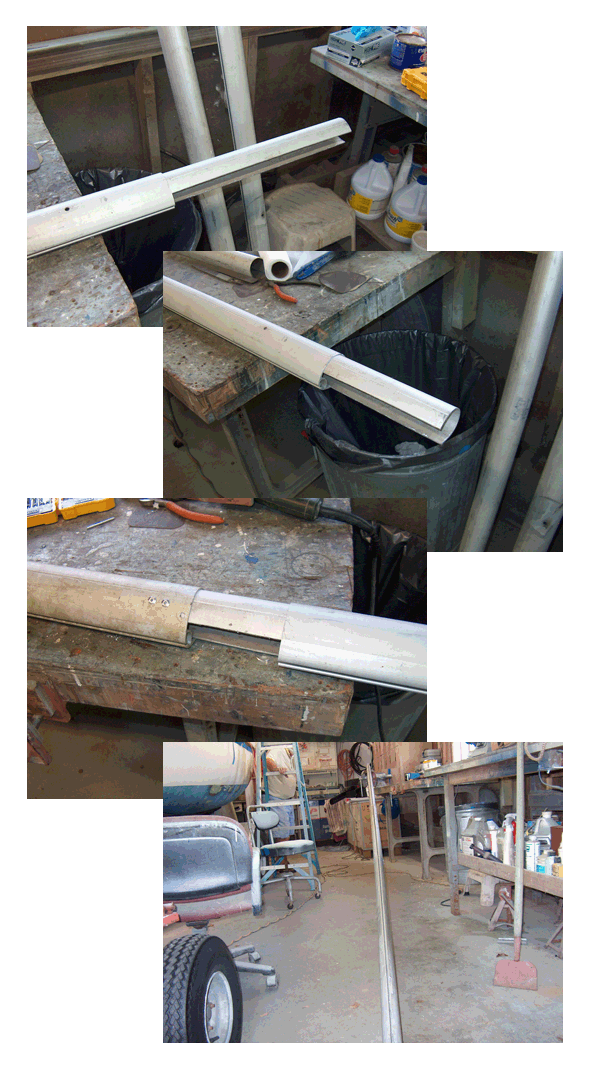
|
This has been a busy year. The Sailboat business has always been bigger in the spring than in the rest of the year, but this year it has been bigger than normal. We sold some new boats and also all the used boats that we could restore. Most small companies are limited by sales, but we are limited by labor and the time it takes to restore a boat. Our Company installed a new diesel motor in a Com-Pac 25 that was located on Topsail Island's Sound. That's a stones throw from the ocean. The motor was a new high tech motor made by Yanmar. The local marina had some crazy rules about who could work on boats and who couldn't. The engine change was unusual in that we were not exchanging the same type of engine. We were replacing a 160-pound 1GM10 with a 360-pound 2YM15. The EPA decided that the 1GM10 was a dirty engine and that the American public could no longer purchase those engines. The rest of the World can, but we can't. Making the swap required lots of measurements and some boat modifications. Everything turned out well and the boat's performance is outstanding. The 2YM15 is a smooth engine. We had time to work on a mast raising system for a Com-Pac 16 and 23. The 16 is a one-hand pull to raise the mast and the 23 is going to be electric. We have built several mast raising systems in the past and this may be the best yet. We did an electric mast raising system for a Horizon Cat rigged Com-Pac 23 several years ago. It worked well and I think it is still working well. The owners had to go under a bridge. Com-Pac has also developed a mast raising system for their production 23 that can be ordered as an option. Some new boat prices for 2018 will be going up about ten percent. Prices were held down during the past recession and they need to get back in line with the rest of the economy. Restored boat prices have the same problem. The cost of restoring a boat is getting more expensive |
Being old helps me remember the way it was. And the way I remember it, our local boat shows were better when sailors ran them. What I'm talking about is some of our North Carolina Boat Shows may not be as good as they once were. Today, some shows are run by charities and volunteers and it's good that someone doing it. The last show that I attended was the Oriental Boat Show and it was organized and run by the local Rotary Club. I had attended several Oriental Shows years before and they were organized and run by sailors. The local shows are designed to bring business to the towns where they are held. We never sold a boat from an Oriental Show and I didn't expect to sell one this time. I did expect to be treated like everyone else that paid money to attend the show. Two sailboat dealers with sailboats were positioned outside the show proper. If you were not looking our way, you would never know that we were there. Car dealers and other non-boat companies were prominently displayed on the show grounds. Maybe a company had to be from Oriental to make the show proper. I remember that we were treated the same way in New Bern, but that charity called their show the Mums Festival. Back in old days, we had a premier sailboat race in North Carolina. It was called the Michelob Cup and ran from Oriental to New Bern. The Budweiser Dealer sponsored the event and sailors ran the race. The steaks and beer were excellent. The sponsor dropped out and the charities took over and the race soon became history. I'm not sure that charities and sailboats can exist side by side because they exist for different purposes. I shared space with the SPCA at the last boat show in Raleigh. That show was not run by a charity. I liked the dogs and cats. They didn't buy a boat. |
Several years ago, I made my way to Greensboro, NC to attend their annual winter boat show. I found the town to be rather old for the most part. It had seen better days when the garment business was booming. The old factories that housed all those garment workers were empty and abandoned. Most of the people that attended the show only looked at boats. I did sell one boat. They had some new construction on the interstate where other types of businesses liked the access the interstate provided. It appeared that Greensboro didn't do very well after we decided having Free Trade with the World was the right solution to our problems. Little did I know at the time, that my Great (times 5) Grandfather had been there before me? He was a Minuteman that had traveled from Kentucky with his long rifle to help General Greene battle the British at Guilford Courthouse. Guilford County is currently Greensboro. That battle was the beginning of end for Cornwallis at Yorktown. I wonder if they named the town after General Greene? You can read the Guildford County Court House story on Wikipedia by clicking HERE
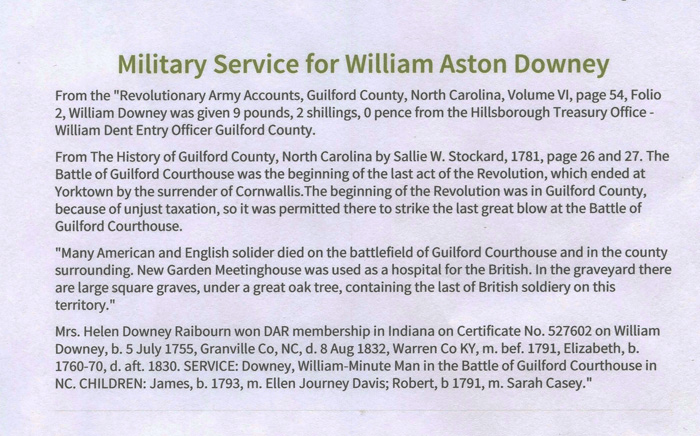
|
The weather was great. I was in the parking lot waiting for someone to show up and that didn't happen. Maybe the day after the end of the school year wasn't a great day for an outing? Maybe going under a bridge would have been too difficult for some sailors? For whatever the reason, no one showed up for our outing this morning. It was going to be a learning outing where we demonstrated sail shape and light wind performance using my 16 as a reference. Can you point as high as I can? We would have found out today. Can a 16 out point a Sun Cat or anything else that could get under that bridge? Some of the best sailing in the World is on Morgan Bay. Our Cat family is well equipped to get under that bridge and do some wonderful sailing. If you live within 50 miles, you need to try sailing on Morgan Bay. A 16 shipper needs to be under 50 years old or have our new mast raising system installed for the bridge. Our 16 mast gallows should work by itself if you are young enough. |
The forecast for Saturday the 20th of May is 60% rain with thunderstorms. Sounds like the last time we did this on the 13th. We need to postpone again and this time also miss some holidays. The next time that we can get together is the 10th of June. Maybe the weather will cooperate on the 10th. |
The forecast for Saturday the 13th of May is 95% rain with thunderstorms and gusts to 40 mph. It is not going to be a good day to be on the water. As sailors, we live by weather forecast. A forecast that's only 1 day old is normally very accurate. A forecast that's in the future by several days is not normally that accurate. That's called a 5-day forecast. We are only 2 and 1/2 days away from Saturday the 13th and the current forecast doesn't look good for an outing. With that in mind, we will postpone the May 13 outing until the following Saturday, the 20th. We will keep our fingers crossed for good weather on the 20th. We will meet at 10:00 on Saturday in the parking lot between the bridges in Jacksonville. See you there. |
The weather has been pretty good. The grass is growing and the trees are full of leaves. I'm looking forward to a great sailing season. The times for our outing on the 13th of May are on this page. They are a few paragraphs down the page. A rain day for the outing will be the following Saturday. Let me know if you have any questions by email. The Used Parts page is leaving this Web site for the summer. It will be back in the fall with new items for sale. Our new boat business has been good this year and I think the economy is going to get better soon. The Com-Pac Factory is really busy. I hope to see you all on the water. |
We talked to lots of old customers at the Oriental Boat Show. For sure and certain, if you own a Com-Pac Yacht, you will become a sailor and maybe stop by boat shows from time to time just to see what's new. Anyway, it was great seeing all my old friends at the show. The weather on Friday and Saturday was warm with lots of sun. We spent extra time moving our chairs from place to place to keep them in the shade of our tree. The main show was at some distance from our location, but I heard that they were showing automobiles over there. I wonder if an automobile float? I doubt it. We demonstrated our new mast raising system to anyone that wanted to see me exercise. The way to stay slim and trim is with lots of exercise. We can raise the mast from outside the boat and maybe for some people, raise the mast electrically
|
The Oriental Boat Show is an in the WATER boat show. There are lots of boats in the water if you are looking for that type of sailboat. On the landside of the show, it is mostly powerboats and vendors selling nautical parts and pieces. I think small sailboats might be limited to just one sailboat on a trailer. You will need to look really hard to find that boat because it's at some distance from the center of the show. The Sailboat Company is located close to the M&M Restaurant, between a tent and a tree. We are showing a new mast raising system for a Com-Pac 16. It's a cool system for going under bridges or raising you mast in the parking lot with no one in the boat. We will put the details on our Current Projects Page soon. |
Com-Pac 16s/19s, Legacies, Sun Cats and any other Com-Pac Yacht that can go under a low bridge should joint the rest of us between the bridges in Jacksonville, NC on the 13th of May. We all need to be there and ready to go by 10:00 on Saturday morning. We should be able to be in the water and move to Morgan Bay by noon. Sail shape and reading the wind will be some of the topics for the day. Every one will be required to have a good time. Getting out of water by 5:00 and moving next door to the Marina Cafe for dinner by 6:00 is on our schedule. The talk at dinner after an afternoon sail is always interesting. A rain day for the event is the following Saturday. Call or email Keith if you have questions. We hope to see you there. |
We sold a boat and trailer to a nice man in 2002. We put the boat in a slip on Jordan Lake and it has been there ever since. The trailer was parked in a trailer parking lot at that same time. Both boat and trailer did pretty well considering it has been 15 years. We didn't trust the trailer to make it the 115 miles back to Richlands. We decided to piggyback the boat and trailer on a Com-Pac 23 trailer. I purchased two 2X8 boards that were 8 feet long. They would fit inside my short bed truck. With help from the boards and the 23-trailer winch, we loaded the 16 trailer on the 23 trailer. It combination looked pretty good and away we went to the launching ramp. The 16 came in nice and slow and it appeared to know where it was suppose to go. We had to winch just a little to get her on the trailer. Down with the mast and away we went to grandmothers house or Richlands as the case may be.
|
I have never own a "new" Com-Pac 23D, but I have owned several used 23Ds and they sail better than their outboard cousins. The EPA stopped the sale of the wonderful Yanmar 1GM10 because it had "raw water cooling" in its name. They like the larger more polluting engines that are fresh water-cooled. Go figure? So the big question is: How can we proceed with what we have? Com-Pac modified the deck to accommodate their new 23D with a 2YM15. That being our next best choice. It's a fresh water-cooled two-cylinder diesel with some nice improvements. Of course it cost more than the old 1GM10. Richard Summers used a CP-23D with a 1GM10 to circumnavigate the eastern half of the United Sates. His story is on our Archive Second Site. We are currently installing a 2YM15 in a Com-Pac 25. It looks like it's going to be a good improvement over the old 1GM10 that we are removing. More power and fresh water-cooling in a salt-water environment is an improvement for the 25. We are going to school on this installation and learning how we are going to install one in a 23 without the cost of modifying the deck. The problem with a 23 installation is the room under the cockpit floor. It looks like it's going to work by moving the engine forward a few inches. The only problem is going to be cost. I think $15K will get one installed in an outboard CP-23. You might get a few dollars trade-in on the old outboard if it's nice and 4 stroke.
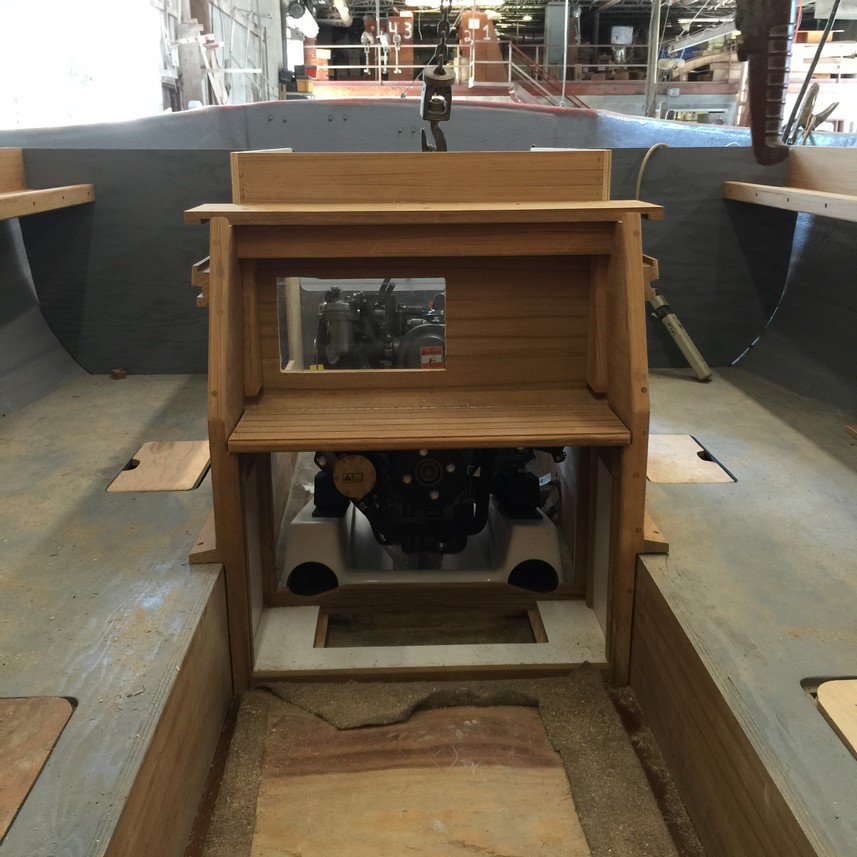
|
We are considering conducting a Com-Pac Owner's sailing school on the water. If we have enough interest, the class will be a day of sailing on the New River with dinner after at the Marina Cafe. The launch ramp is between two bridges in Jacksonville, NC. Com-Pac 16s, 19s and Sun Cats should have no problem going under the bridge and raising their mast on the other side. We have a dock on the other side for people that need to hold on something while they raise their mast. We will be talking sail shape and pointing angles during the class. The Com-Pac Club always held their outings the second weekend of each month and we will follow that precedent. The first class will be in May with other classes to follow. More details will be on this Web site in April. |
We have a Boat Show coming in April and we will be there. The Jacksonville, FL dealer and The Sailboat Company will show boats at the Show. The dates are 21 April to 23 April. I hope to see you all at the show. |
Many motors in Com-Pac Yachts and others that we sold in the 80s are getting old. The boats keep on going, but the engines may need some care with others needing replacement. We are currently doing a Com-Pac 25 that's in the water at a slip. We plan on removing and replacing the engine in the field. That's what we did in Viet Nam when we lost a helicopter's engine. We put a perimeter around the aircraft, dropped the bad engine and replace it with a good engine and continued to fly. We don't have the bad guys shooting at us here, but we do have another problem. A replacement engine today properly will not be the same brand or size as the old engine. A good example is the above Com-Pac 25. Its replacement engine will be Yanmar 2YM15 fresh water-cooled engine. It has a larger physical size with more power than the original engine. Will it fit? The answer is yes. Will it need a new propeller? The answer is maybe. If it does need a new propeller, will we have to pull the boat to replace the propeller? The answer is yes. The good news is the cost. Engine cost including installation is going to be around $10,000. We will know about the propeller soon. I think the 2YM15 will be the replacement engine of choice and they will all take the same propeller. |
We have had a warmer than normal winter so far. Some days in January have been almost like spring. The boat business has improved and maybe that was caused by the good weather? Our customers are getting ready for the coming sailing season early. All those repairs that needed to be done last year are being done now. I'm looking forward to a good sailing year. All Nimble sailboats with big windows on the side leak. I'm talking about the 25 and 26-foot boats. One reason is the fiberglass sides that support the windows are too thin. We have a solution to that problem if anyone is interested. Caulking the windows is not the answer. The pretty interiors in those boats need to be preserved and they need to be dry boats. The rest of the boat is made like a tank. They are really quality boats with only a few flaws. Not bad for a boat that's not currently being produced. More people are sailing in the coastal waters of South Carolina and Georgia. They have moved into the area for the weather and the low cost of living. They are day sailing in areas with a tidal range of 3 or 4 feet. Not many people sail in those areas because the current can be very strong. I hope to do a how-to article soon on sailing in strong currents. It's possible to do, but you need to know what's going to happen before it happens. Knowledge of the currents is one more skill required by these coastal sailors. |
We just lost a notable sailor from North Carolina s sailing community. John (Dick) Wertz owned many sailboats and participated in many organized sailing events through the years. Dick was a retired Marine MSgt with an exceptional military career. The Marine Corps identified Dick as highly intelligent when he enlisted and they sent him to language school in California. The Navy Language School is not an easy school to graduate from, but Dick did with flying colors and continued in that field for the rest of his career. He wasn t one of those captured, but remember the Pueblo Sailors that were apprehended off North Korea s coast? He did as a Marine what the Pueblo Sailors were doing when they were captured. That was something that he really couldn t talk about in public. Dick enjoyed sailing and the social life surrounding sailing. Eating at fish restaurant after a long day s race was what he really enjoyed. Sleeping in a hot cabin wasn t all that great, but the sail home in the early morning was another high point almost as good as the race the day before. Through research, Dick identified that his right arm and his left arm were not the same when steering a tiller sailboat. We did our research on the wind and proved that to be the case. It s a consideration on long voyages. All of Dick's boats were called "Nuther Toy". As Dick got older, he became a proficient clay artist. He attended the Ringling School of Art and Design. Moving from the sailing community to the artistic community was easy for Dick. He was intelligent enough to do anything if he wanted to do. Dick was an interesting person to know, my friend and will be missed by everyone that knew him. |
|
|
Mike's Boat Sales and Repair is going to sell new and used boats in Augusta. Check out his Web site when you can and watch him grow. There is some great racing on the lakes around Augusta. His Web site is: http://www.mikesboatsalesandrepair.com. |
Com-Pacs can be restored well. The Com-Pac 19 below has new teak, new rub rails and new tape. It also has our standard spit and polish that all restoration receives. I can remember when 19s from the factory looked like this:
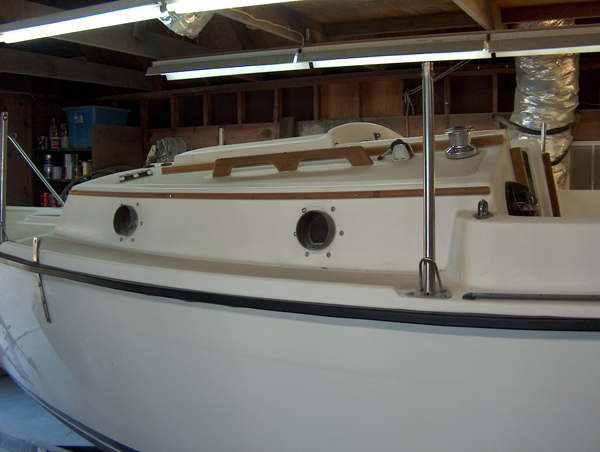
|
Good news for small boat sailors. The Com-Pac Pilot House 23 now comes in an outboard version. With a Dealer discount and a trade-in, most of us can now purchase this great little boat. A Com-Pac 23 owner can trade-in his or her boat and keep their old trailer, get a discount and have a boat that can go anywhere. A four-stroke motor on the back solves lots of problems. Cost being a major problem. The diesel was too expensive for most of us and it did take up lots of room on the inside. The diesel is still available, but I bet most of the new PH boats will be outboard models. A prefect boat for a couple that's going cruising. It can sleep six if required, but two is as good as it gets. Standing headroom and still goes on and off a trailer. Can it get any better than that? The current price list is below. Send me an email for a quote.
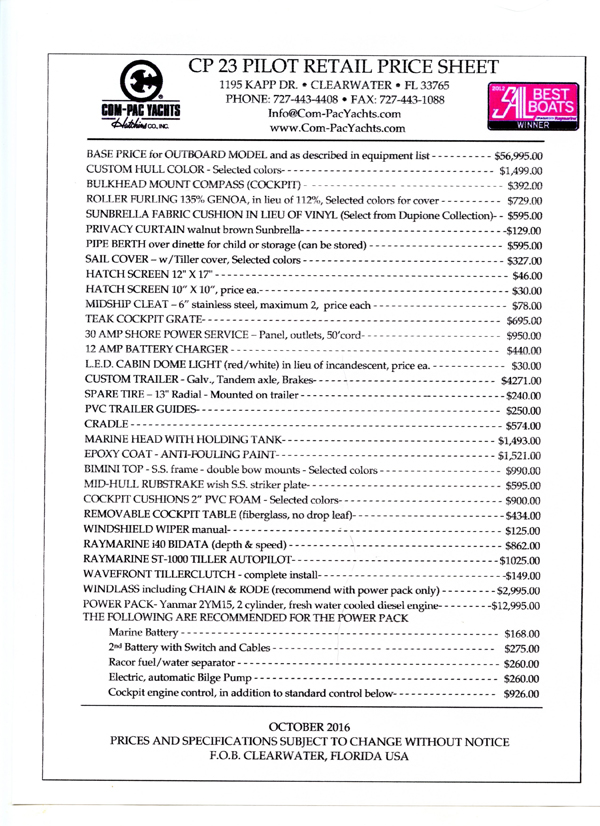
|
Hurricane Matthews just came calling. It wasn't as bad as Hurricane Floyd in 1999, but it wasn't that good either. We moved lots of boats and watched the water get higher. A few boats moved, but most kept their wheels dry during and after the storm. We had no damage to boats or property. The secret to small boats and floods is to tie the trailer to the boat. The boat floats with the trailer under the boat the boats come down on the trailers when the water leaves. Our little Cape Dory did a little dance with the cradle tied to the boat and came down on the cradle when the water receded. I hope this was the last Hurricane for this season.
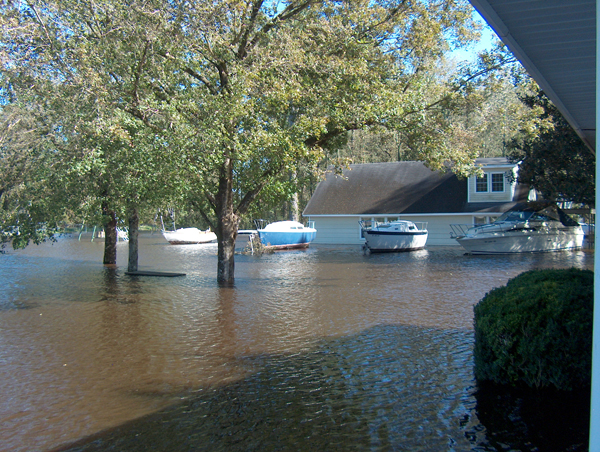
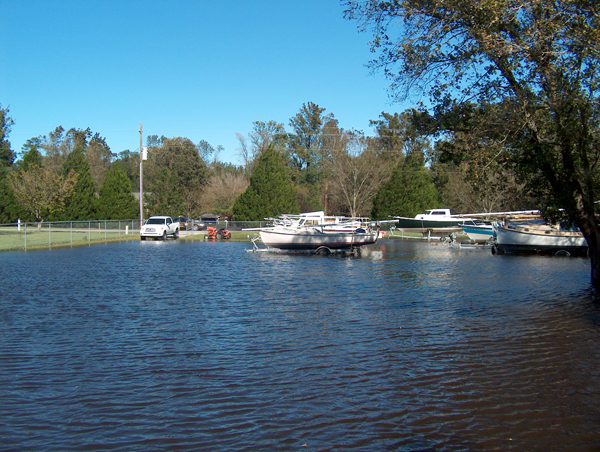
|
An owner and I were sailing a Com-Pac 16 on Sunday and we saw another 16 on Morgan Bay. I was doing "A How To" drill in our 16 and I think the other boat was running our Morgan Bay racecourse. I waved, but the other boat didn't see my hand signals. They were busy. The weather was great, but we could have used more wind. The water was warm and I fell in at the dock. I'm not sure how it happen. I was sitting on the deck and the boat heeled and I slid off. I did enjoy doing the backstroke until I could stand up on the ramp. Great exercise. We are in the process of restoring a 1979 Sun Cat. Com-Pac didn't build this boat. This boat is a heavy duty Sun Cat with a diesel motor, more sail area, a fixed keel and a gaff main and jib. The boat carries a 4-foot long bowsprit and appears to be a little bigger on the inside. I owned a similar boat back in the 80s that was built by Clark Mills in Clearwater, FL. That boat wasn't a diesel, but had the same keel arrangement and a real pretty inside. The 1979 boat is from the same molds and looks to be of about 2000 pounds displacement. The original fixed mast, boom and gaff are going to be changed to a Horizon Cat Mast-Tender system. I remember trailing our old boat and the fixed keel wasn't a launching problem. Getting the tall Marconi mast up was a problem and changing it to a Mast-Tender will solve that problem. The boom extending 2.5 feet aft of the transom might be interesting. We also have a Com-Pac 19 and 16 in work. The Heavy Duty Sun Cat and the 19 and 16 should be ready about the same time. Other than working on those boats, we plan on sailing in the Neuse and the New River this fall. We normally have great weather all the way to Christmas. See you on the water. |
We recently had to do a repair for an insurance company. The boat was damaged after a lighting strike. It was a late model popular brand of sailboat. It had some physical damage and the running lights didn't work. During our repair work, we noticed some other problems with the electrical system. Problems not caused by the lighting strike. The boat was equipped with shore power, but didn't have an A/C panel or circuit breakers. The equipment using A/C power was a stove, battery charger and several bulkhead outlets. When shore power was plugged in, the boat was hot. An internal ground fault circuit may have protected the outlets, but did do anything else. This equipment appeared to be factory or dealer installed. A bulkhead compass was also installed in the cockpit next to a large winch. The compass always pointed northeast or towards the winch. I believe the compass was installed by a dealer. Someone didn't read the installation instructions for the compass. An owner may have also installed several other non-fused electrical components. This type of workmanship can cause a fire or kill people. The unmarked wires in this boat ran behind and under panels. With unmarked wires, troubleshooting electrical problems are very difficult. A good wiring diagram wasn't available and was a constant complaint by owners on the Inter-net. A 12-volt short can burn down a boat. A bad shore power installation can kill people. The running lights not working were not caused by the lighting strike. It was man-made by someone that didn't know how to wire a boat. How safe is your wiring? |
We have fly-fishing in our backyard. Come check out our boats and bring a fly rod. Our Red Belly Breams like small artificial lures sold just about everywhere. The fish would look bigger if my son was smaller.
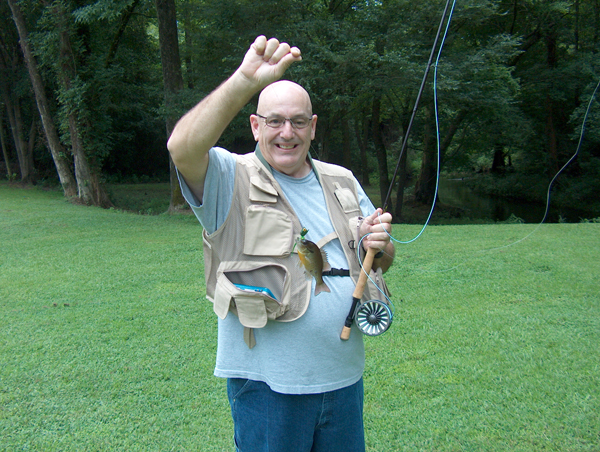
|
Most of the races were run in 2006. I remember most of the races because I was on all the boats that raced. What I do remember most is the general weather conditions and the race results. The new format "Pick A Race" on the left answered some old questions and created a few new ones. The first race was in our green Com-Pac 23. The wind was over 12 knots and I didn't use the jib because I didn't need to. The main was all the power that we needed. I remember the race being fast because the wind was high. We had some wave action created by the wind. The race results show the wind was out of the northwest. The close tacking at the finish line tells us the wind direction. The first leg was downwind and we surfed a little. Run the race on "Slow" and you can see the speed go up and then drop off. The graphic also skips a beat on a surf. We had a little bit of a screw up rounding the first mark and then a big bounce off the terrain between the first and second marks. Rounding the second mark looked pretty good and then we started fighting the bumps caused by the wind bouncing off the terrain as we sailed upwind. We could have tacked to the center, but that would have been a longer distance and those big waves were still blowing down the center. The race start and finish is latitude 34.4212. Going to the east side of the bay is a shorter distance to the finish line. The green boat almost crossed the start/finish line twice. A 23 can surf up to 10 knots in 35 mph winds from the right direction. The second race was a recent race in a Cal 28.9. The boat has a draft of over 5 feet. They had 8 people on board and not everyone was into racing. They went aground after the second mark, but got off without starting the motor. The wind was a little less than 12 knots. They promised to do better next time. This is a little 16 that could. The wind was out of the southwest and over 12 knots. I was sailing close the wind on the first leg. I tacked too soon at mark 1 and should have gone further into the cove that has all those crazy wind changes in that area. You can see the effects of the terrain between marks 1 and 2 and then I was off to the finish line after rounding 2. You can see me taking advantage of every gust. I was sailing with a constant go up and fall off rhythm. It looks like the boat has the shakes. The forth race was a Sun Cat with wind on the nose. We sailed too close to the terrain on the west side of Morgan Bay and got all the bumps and bubbles off the terrain. With the wind coming out of the south, the wind was bouncing along the shoreline and causing all kinds of bad air. Maybe we should have sailed down the center of the Bay? We got a little bit of clean air just before the first mark and had one good tack. The terrain got us again between mark 1 and 2 and then we sailed into a wind shift caused by the terrain in the middle of the Bay. We recovered and continued on a new course. It was a bad wind and terrain day in general. The fifth race was in a Com-Pac Legacy. The wind was out of the north and light. The little boat had the same terrain problem between marks 1 and 2. Going upwind in light air with some of the air going through the terrain before it got to the boat wasn't all that great. The boat could have done better with more wind. Running the race program on "Slow" will show lots of details. Maybe why a bad tack is a bad tack? Using the "Fast" button will get you around to the more interesting spot quickly. Comments and questions are welcome. |
Racing outside Duck Creek Marina will be interesting. The start will be between marks 24 and 22 and the first mark is going to be the entrance mark to Duck Creek. A wind out of the north will funnel wind down Duck Creek towards that mark. Expect some crazy sailing getting to that mark. The next mark is across the river at day mark 29 and a north wind will pass through a high-rise bridge before it gets to the racecourse. More crazy sailing. A south wind will reduce the bridge problem, but sailing back to the turning marks against the wind might be difficult because that side of the river has a deep channel with more current than the other more shallow side. Of course the current could be going in the right direction? That side of the river also has a high bluff that will cause wind shadows and wind direction changes. The racecourse is going to be twice around the marks. So what gets screwed up the first time around should get fixed the second time around. Look for the differences between the two.
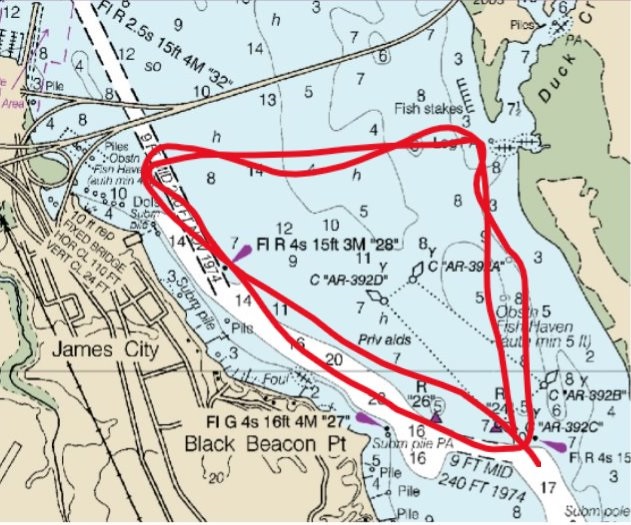
|
What did you learn from your first look? Some of boats did some crazy things? Back sailing after a tack and other odd sailing maneuvers. You might have said some of those things may have happen to me. And I think the reason was something that you can't see. When the wind hits the terrain, (the terrain being the shore line, a bridge, another sailboat or anything else at boat and mast level) the wind might change direction and twirl (definition: spin quickly and lightly around, especially repeatedly). Is that happening in of all the races on the New River? We are sailing around marks that are close to the shore. Our air funnels in some spots and drags against the shoreline in others. I think it's the terrain that causes lots of poor sailing. Being great sailors as most of us are, I'm sure you can calculate the wind direction at most locations before you get there. Knowing what going to happen before it happens is called experience or local knowledge. Most of the boats had problems where I have red lines on the map below. |
My plan is to modify our "A New Sailing Tool" link on the left with lots of information. It's going to be a template for our Neuse River sailing this summer and maybe some 16 racing on Morgan Bay this fall. The dynamic information will be the graphics, speed, time and distance sailed for each boat. PHRF handicaps and the course distance will also be provided. All you have to do is start the race and analyze the results. You will also have to do some math! That way everyone can learn what works and what doesn't. The course distance between the marks on Morgan Bay is 5 nautical miles. How much sailing distance is required to cover a fixed distance course??? How much time and distance was recorded between the start and finish lines??? We will figure the handicap and publish the winners. We hope to get as many boats as possible on the Neuse and The New River. They may not be sailing at the same time. I might be able to get 2 boats at the same time if I'm lucky. If it's a single boat, the skipper better pick a day with good wind to win. |
Monkey see and monkey do. That's an old saying that's used by many teachers today. The plan is to enjoy some sailing on the Neuse River and teach the World a little more about sailing. Racing is one of the best methods used at becoming a good sailor. When I was younger, we raced boats in our local waters and I was always disappointed that we never knew where we placed in the group of boats that finished the race. The race committee published first, second and third place and that was it? We could have learned more about sailing had we had better reporting. Getting a race together and publishing the results is a major undertaking today. We don't do much of that anymore and that's not good. Racing gives us a reason to be on the water and we can learn lots of good information from the other boats in a race. The next best thing to being on the water may be watching two boats race on your computer screen. We plan on using the tool on the left "A New Sailing Tool" to publish the results of boats racing on the Neuse River this summer. The plan is to have two boats race a course and for you to see speed, elapsed time, handicap and the maneuvering of both boats on a map all at the same time. It will be your job to analyze the skipper's decisions, how the terrain affected the race and the suitability of boats racing. You have a big job. The Cal 29.9 in the sample program has a hadicap of 186 and the Com-Pac 23 has a 251. The two boats sailed at different times. The Cal had less wind and their crew didn't know they were racing. They had 7 people on board and they were just having a good time. When two boats sail at the same time on the Neuse, both crews will know they are racing and they will be doing their best to win the race. We may do two Com-Pac 16s on the New River in the fall. |
Most "rag" sailors like their boats because they are very stable. They can get on and off their boats without the boat throwing them around. I like to step on a small boat when it feels like a big boat. Most sailboats are very stable because they have ballast to counterbalance the power from the sails. You get that steady boat feel just because it s a sailboat. The older you get, the better it feels. Our little 19-foot O'Day Mariner 2+2 has that feel. When it was a sailboat, it had lots of sailing power and needed enough ballast to make her stable. As a power launch, she rides smooth and turns flat in a fast turn. An O'Day Mariner Launch conversion costs about $15K including the motor. The sailing rig is extra and optional. The customer provides the boat and trailer. A sailing rig for the O'Day cost about $4K including a mast, boom and rudder. The original sail can be cut down to make a modest sailing rig. This boat can fish, sail and go places with an economical 9.9hp motor. Of course, everyone likes its looks. Click "Current Projects" on the left. The picture of the boat going down the river shows me on the starboard side steering the boat. Notice that the boat is not leaning to one side. I'm 6 feet tall and weight 200 pounds. Other boats like the Rhodes 19 have the same hull as the O'Day and they could also be converted to a Sailing Launch. |
|
Who wouldn t want to be a great sailor? We would all like to see the wind and feel the boat as an extension of ourselves as we sail. That might take a few years of sailing for most of us. Some sailing schools offer great instructors; lots of time at the helm and that can help sailors become good sailors quickly. A better solution may be through the magic of GPS. When a computer measures the distance and direction between GPS track points, they are very accurate. Every track point has the same error caused by the equipment and the earth. With the same error,the measurements between those points are very accurate. You can see many examples on this Web site. This is the plan. Download the free GPS Utility from www.gpsu.co.uk. Buy a GPS receiver like the one pictured on my Navigation link at the lower left. The Garmin eTrex and other receivers will also needs a cable to download their data from the receiver to your computer. Several different combinations of computers, cables and GPS receivers will work. After downloading your data, you save the track points as a "gpx" file and email that file to me. That's what I need to publish your data on the Web. Your first published sail cost $25 and subsequent sails cost $10. You need to be a costal North Carolina sailor to qualify for this service. You can own any brand or size of sailboat. We will expand our service to the rest of the east coast soon. To record your data, you turn the GPS receiver on when you start sailing and turn it off when you finish sailing. The receiver picks up the data without you doing anything else. We recommend sailing on the wind through several tacks for your first sail. That sail will be your reference sail and other sails should be over the same course or in the same area in different conditions and maybe with different equipment. Being able to see your progress from one season to the next is important, but knowing when to change sail trim may be the most important. You need to record the water's surface condition from each sail so we can calculate wind speed. With more than one sail, we can make performance recommendations and solve common sailing problems. You will also become a great sailor because you will see what works and what doesn't. If you race PHRF, you really need this service. It will win races. Ask questions via email : sailboat@sailboatrichllands.com |
I think that was a popular Peter, Paul and Mary song back in my Vietnam days. They were singing about our military then, but now it s "where have all our sailors gone". It seems like only yesterday that we were sailing in all kinds of weather and having a great time. I'm sad to report that Bob Andrews from Oriental NC just passed away. He was an extraordinary sailor that loved sailing and sailboats. His story of sailing can be found at: http://towndock.net/ published 30Mar16 and http://towndock.net/search/?q=bob+andrews. |
My old "ipass.net" server address is being re-directed to my new server "sailboatrichlands.com". All the old files are on the new server and most of the stuff is working as before. My servers are not the same type of machines and that complicated the process somewhat. I still have to figure out how Common Gateway Interface (CGI) files work on my new Windows server. The Question and Answer link will be missing the Question part of the link. That is a CGI file that I need to work on. Until I get that part of the new site working, just send me an email with your question and I will answer them like we did before. The old address will not be re-directed after 29 April. Our new Web site address is http://www.sailboatrichlands.com and the new email address is sailboat@sailboatrichlands.com. Sorry about the inconvenience. |
It has been a good 35 years. My server people started out as a dial-up concern in the basement of a Raleigh office building. I remember they had 2 rooms full of modems. Egor was the technician and he had his hands full. "DotComs" were just getting started and I didn't want one of those new gadgets that cost more money, so our address was just ipass.net/sailboat. Anyway our new address is www.sailboatrichlands.com and our email is sailboat@sailboatrichlands.com. The old server is going to continue working until 29 April and we plan on maintaining both sites until then. After that, we will have just a Primary site and an Archive site for the old stuff. I don't know about you, but I don't like change. The Q&A is not going to work on our new site for now. Send me an email if you have a question. Thanks. |
The widow of a North Carolina sailor would like to know the whereabouts of the Francis R. The ship is a wood skipjack that belonged to her husband many years ago. Let me know if you have seen her. Thanks. |
I failed. I made a mock-up that looked pretty good, but it didn't solve all the general dodger problems associated with small boats. The problem with dodgers in general is getting into and out of the cabin. Some people go in backwards to make access better and others say bad words. Small boats with hard dodgers are not a marriage made in heaven. To make a hard dodger work on a Com-Pac 23, the bridge deck would need to be modified and maybe the main sail size reduced. All and all, too much permanent work to make a hard dodger practical. My mock-up kept looking like a pilothouse or trawler. In my opinion, a pretty canvas dodger that can be removed is the best solution. Com-Pac has had problems with ugly dodgers in the past. Square looking dodgers are practical, but ugly in my opinion. I have seen several pretty dodgers that have nice rounded sides that compliment the shape of the boat. They are made by independent canvas shops. Permanent shade and wind protection on big boats works well. I think little boats need the option of removing that protection when it s not needed. |
Who would like to have a hard dodger on their Com-Pac 23? Standing headroom in the sink and stove area and easy entrance and exit from the cabin. Great for old folks and long distance cruising on the ICW. I think my 23 is going to get the first one. A gallows and a tall tabernacle will be included. |
We just developed a new and better way to communicate. The sailing map data displayed on this Web site will be more understandable in the future. The old display system was a string of positions using dots or images of boats. A new image would partially cover an old image on most displays. More than one boat sailing at the same time makes a display with lots of dots. The Sea Trials on the YSB8" diesel conversion link on the left has been changed to the new system. Check it out. Our display system is very accurate and shows the boat's course when we use an image. The relationship of one position to all the other positions is very, very accurate. Using an image to show a boat's course on a map over the Internet was a major step forward last year. Now with a single moving image, sailors can see what a boat can do. |
We have new boat ramps in Jacksonville, NC and a local Marina that only charge $75 per month for small sailboats. The entrance channel has 3 feet of depth. The Marina has limited facilities, but 16s, Sun Cats and 19s should qualify. November would be a great month to race and get good at sailing on Morgan Bay. Morgan Bay is just outside Jacksonville on the upper New River. It s a real pretty place to sail that s surrounded by the Marine Corps. Owners that would like to sail on Saturdays during November should email Keith and let him know. |
Com-Pac has been selling boats to Japan and Germany for years. We can also add Australia to countries that know quality sailboats. The boat in the picture is a 1993 Com-Pac 19 that really looks good.
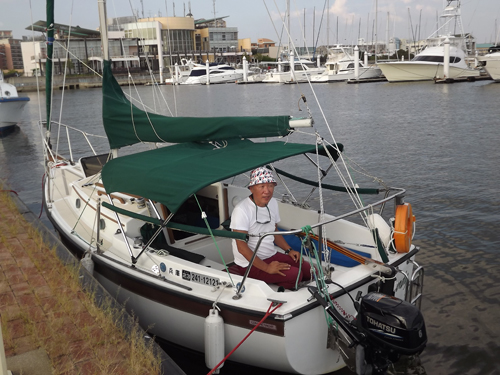
|
When you need to move a 16 and the trailer isn't that good, a ramp made from two 2X12X12 boards and away you go on a 23 trailer.
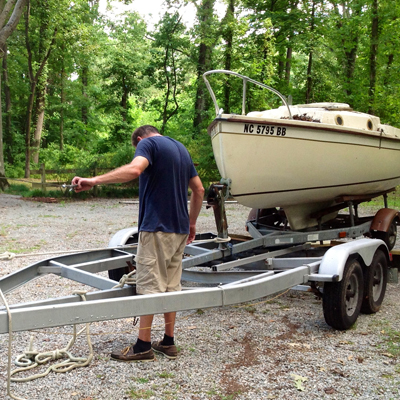
|
The plastic ports in some Com-Pac Cat Boats leak. A new inexpensive cover protects the ports from leakage and also keeps the plastic lens clear. Adding cat eyes to the covers are optional. They are available from Mail Order Canvas on the lower left hand side of this Web site.
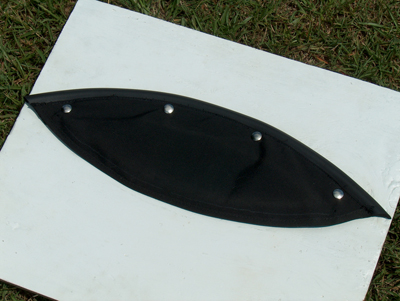
|
Com-Pac is currently making me a custom rudder-lifting lever for a Com-Pac 16. The price is reasonable and I'm sure Com-Pac is going to include a good set of installation instructions. Old 19s and 23s will also sail better with the improved lifting device installed. It keeps the rudder up when a boat is in a slip and down while sailing. You don't need extra long arms to make it work. Some current Com-Pac Yachts have the handle as standard equipment. It's an unadvertised option on all the other Com-Pac boats. |
I remember the competition between the Com-Pac 16 and the Victoria 18 25 years ago. You could sleep in a 16 and turnover and you would hit your hips on the overhead in the Victoria. The 16 won that battle and we sold lots of 16s. I think we will be able to sleep in a Sunday Cat? You might need to be young or middle aged to sleep well, but the boat has more room than a 16. A bulkhead will need to be removed to make sleeping possible. The head will go outside in the cockpit during the night. That's really what we do with all the trailer-able Com-Pacs anyway. Some old Com-Pac owners may remember 2 moons over Cape Lookout featuring one of our club member's wife. With the mast raising system plus the possibility of spending the night and a good price, I think the Sunday Cat is going to be very popular. Have a Happy Forth. |
Com-Pac has created another cool boat. The Sunday Cat is a Sun Cat with a big cockpit. You pull the mast up from the cockpit with a single line. That's all you do. No going forward to connect the forestay. Just raise the sail and go sailing. It's that easy. The price is also a big improvement. The Sunday Cat sells for less money. The factory is selling more Sunday Cats than Sun Cats. I wonder why? The head area is large for a head area. Well appointed, functional and pretty. The Sunday Cats and the Sun Cats now have fixed ports. No more leaky opening ports. The Sailboat Company is currently building port covers for the old boats that have ports that leak. They are inexpensive and the covers will keep your boat dry.

|
Peter was an active member of the Com-Pac Club of North Carolina for years. Peter cruised with us and led the way during most of our club races. He was a member of the Blackbeard Sailing Club and had many sailing friends on the Neuse River. He will be missed.
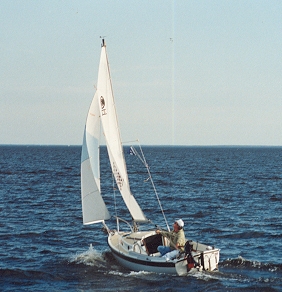
|
We just had a 2009 Horizon Cat owner come by with a common and interesting problem. He has an odd noise or vibration in his boat while running his engine at normal cruising speeds. He has owned diesel engines before and he thought that he might have something wrong with his engine alignment. The boat was on a trailer, so I rotated the shaft at the propeller and observed the shaft move in the cutlass bearing. It was rubbing the bearing with a noise for about 25% of a full rotation on the starboard side. The shaft moved freely during the other 75%. When you adjust engine alignment, you are adjusting the shaft to fit the cutlass bearing. Having a new or almost new bearing is helpful. After checking the other 4 or 5 boats on the yard with the same engine configuration, the Horizon Cat may have been the worse. One of the checked boats was perfect and the others had some drag. We thought the first problem solving check should be to make sure the engine isn't hitting something at cruise speed. The engine will move on its mounts as power is applied. The next check is to see if the drive shaft is bent. If alignment is the problem and the shaft is straight, the rub on the cutlass bearing would be constant at the same spot. I think pulling a propeller poorly can bend a 1-inch stainless steel shaft. The amount of pressure required to pull a propeller is considerable. Putting a micrometer at the end of the shaft will identify shaft misalignment (a bent shaft). Most machine shops can straighten a shaft. The expense will be in getting it out and back in. |
Most builders of small sailboats can't build custom boats. The Henry Ford idea of cookie cutter production is the only way to make a profit building small sailboats. Most production sailboats have their own specific Achilles heel. The San Juan 23 and many other 23-foot sailboats have masts that are too tall to raise by an owner and his or her first mate. Com-Pac solved this problem with their gaff-rigged catboats. The Com-Pac Horizon Cat and Sun Cat are boats that are easy to trailer and the masts go-up with minimal effort. Com-Pac deserves an award for the idea. The San Juan 23 is a big boat with a big cabin and it would be easy to trailer if wasn't for the tall mast. All we have to do remove the old mast and replace it with a Horizon Cat rig and the problem is solved. The boat will look and sail similar to the Com-Pac 23 below. Check out the price for the boat, motor and trailer when we get her completed.
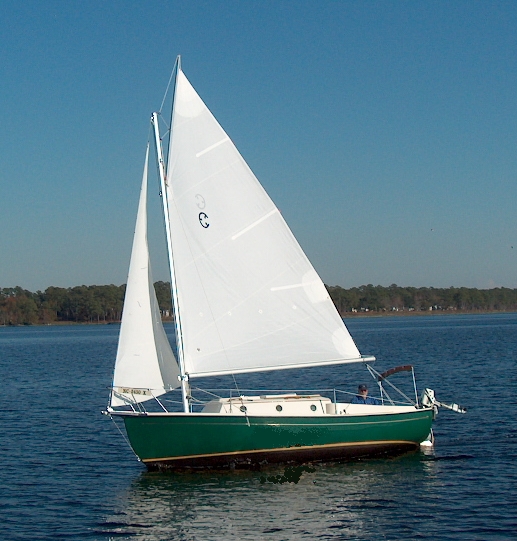
|
The eastern part of the country has been too cold. This unusual weather has slowed the start of our 2015 sailing season. Normal spring maintenance is several weeks behind schedule. The weatherman says maybe normal spring weather will start in about 10 days. We can hope. |
If you can get to Jacksonville, FL this weekend, they are showing a pretty Sun Cat at their annual Boat Show.
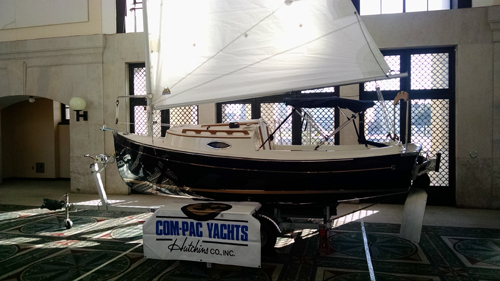
|
Mike Humphrey s is currently a Horizon Cat owner (His boat is on my yard for sale). He has sailed North Carolina's lakes and coastal areas and is now extending his sailing adventures to Europe. The following is a recent email conversation I had with Mike: "I m basically buying this boat to undertake my Celtic Cruise (to really build my sailing skills and general seamanship skills) in May thru June 2015, on my own and it will cover just over 800 miles from Wales to Ireland (that will be the longest sail - 90 miles across the Irish sea), and then really day sails of between 25 and a maximum of 60miles going up the East Coast of Ireland, visit to the Isle of Man, back to Ireland and than over to the Clyde Estuary in Scotland and my target destination is Iona on the Isle of Mull and back as fast as I can to my Home Port of Porthmadog, North Wales. If I manage all that, without losing the boat, I would like to then take the boat down to the Mediterranean in 2016 - with EasyJet we can fly directly from Basel to all main sailing areas in the Med for about $100 return People have advised me that a Centre-Cockpit (the Moody 333) can be particularly good for solo-sailors - do you agree? Additionally the Westerly s have a reputation for being Over-built and the Westerly Falcon at 33 8 in length weigh in at 12,588Lbs and the Moody 333 at 33 in length weighs in at 10,575Lbs. again don t bother researching that I have another friend looking into that for me. Again, only if you have 10 mins to quickly review the details of both boats I would love your overall thoughts." I think he is going to buy the Westerly. Both boats have twin keels that are made for harbors that dry out. |
Who would like to have a Catalina 22 Trawler on a trailer? Standing headroom and she still goes down the highway. That's a great combination. We will build you a 1986 Catalina 22 Trawler with a motor and trailer for $12,000. If you have been thinking about making a trawler out of your boat, talk to us about a trade-in. The cost difference may be smaller than you think. After 40 years of selling sailboats, we have collected lots of odds and ends. We will be listing those items on our third Web site. Click "Used Marine Equipment" on the left. We will remove items as they are sold and add items when we have time to do so. Stoves, biminis, canvas lots of hardware will be listed. |
The Pilothouse is now available with outboard power. That makes the boat more affordable and even more affordable when you trade-in your old Com-Pac. A discount, trade and a lower priced outboard model sounds like a bargain to me. Maybe it is time to go cruising. |
Installing oarlocks on heavy little boats has always been a challenge. Most commercial oarlocks are designed for light boats in the 150-pound category. The Com-Pac 16 at 1100 pounds is more stable and has better directional control. You can standup and row. This new project looks really good in the early stages. We may have a replacement for our expensive outboard motors soon. Moving a sailboat with oars and getting some good exercise at the same time isn't all that bad. We will publish on our "Current Projects" link when we get it done. |
We got it done early. Our Trawler/Pilothouse Study Guide is available by clicking the link on the left. This is a great winter project for some sailors. We are looking forward to publishing pictures of work in progress and the finished boats. |
The Study Plans announced below are going to be free and available on the Web. The completion date for the plans is still the 15th of October. A price list will be available for patterns and parts at that time. I have been talking to several people about sailing performance. A fact that not many people think about is size and location. A 3000-pound sailboat doesn't sail very well in less than 3 knots of wind. A 1000-pound sailboat does very well in those same light winds. If you are thinking about buying a large sailboat and sailing in a location that only has little ripples of wind on the water, plan on not sailing very much. Sailors with big boats get good sailing spinnakers in light winds. Of course, you will need crew to do that. We have come up with a good idea for Com-Pac 23 Pilothouse. It can be sailed from inside the cabin and also outside in the cockpit. The secret to this feature is the helm location at the rear of the house/cabin. The pilothouse's open rear entrance allows easy access for the sheets. Steering with the wheel and controlling the sheets while standing or sitting is possible. I can't wait to try this one out. |
We will offer Study Plans for converting sailboats to pilothouses and trawlers. It will cover converting small cabin sailboats from 16 feet to 24 feet. This will be a "How To" book showing constructions details including a parts list with prices. The study guide will be published in October 2014 and we will accept orders at that time. It's going to be a great Christmas gift for the old man. Introductory price will be $35 including shipping. |
You have all analyzed the Com-Pac 23 sailing in Sailing School Primer 2 and know what happen during the sail. Lets see if your answers to the questions are the same as mine. We talked about the first leg and I answered those questions below. The rest of the questions are more interesting. Was there a downwind leg? I'm sure your answer was no. We had several broad reaches, but no downwind sailing. Was the wind speed on the water affected by the terrain? The answer is a big YES. We talked about the first leg below. The good speed at the beginning of the second leg was caused by the lack of terrain and a long fetch. We slowed as we sailed the second part of the leg because we bumped into the reverse eddies from the land. We were very close to the land. Pointing into the wind and the land being close caused the slow speed on the third leg. The reverse wind eddies off the land can kill your power to point. The reason that we could sail in 2 feet of water with a boat that has a draft of 2 feet 3 inches is the chart shows low water numbers. We were very close to the bottom. The fastest overall leg was leg number 1. The tacking at the end was close tacking to make the finish look good. This 23 was a Horizon Cat rigged catboat. Catboats point well. |
If you have a late model Web Browser, the Sailing School Primers may not have worked. Sorry about that. The World is in the process of making the Web more difficult to use. I have to rewrite lots of code on this site to make everything work by 2016. The Primers had to have the new code to work on the latest browsers now. They are currently fixed and working correctly. Primer number 2 used a Com-Pac 23 with a Horizon Cat sail. The boat sailed well. The wind was out the northwest and blowing pretty good. We got the sail up and flying before we started recording. We started the course on a broad reach and maintained it all the way to the first mark. We were bumping the wind shadow from the land as we sailed towards the mark. You can see that our boat speed wasn't that great. The taller mast and the broad reach masked the wind's affect on our course. It was just slower. We had to pinch at the end of the first leg to make the mark and maintain our speed. |
Happy 4th of July. Lets talk about the second and third legs of the Sailing School Primer. Have you ever tried to take a picture in substantial winds and maintain your course and speed? After looking at the picture, you can see where I had to be to get that picture. The tiller was in the way and I had to try several times. The little boat was doing better than I was during the picture taking. That was the reason for the crazy course changes identified by the blue boats on the Primer.
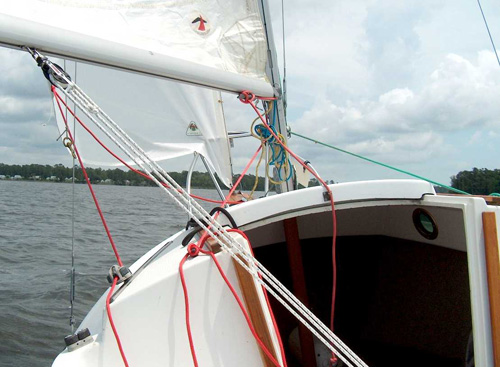
The third leg only had small round-ups from gusts. I was sailing on a broad reach and the little boat was flying. The boat hit 6 knots twice on the last leg. If a 16 is going to surf, it's going to do it in big winds, flat water on a broad reach. The finish line is at the junction of two large creeks that intersect with the river at that point. A longer fetch without the terrain blocking the wind helped with the speed increase at the end. We are on the wrong side of the waves to see the whitecaps in the picture below.
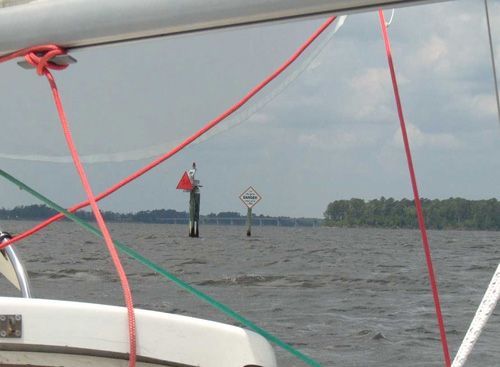
Come sail with me again in Sailing School Primer 2. The answers to those questions will be on this page in a week or two. |
The answers to the first leg Sailing School Primer questions are below. My errors are marked in red on the Primer page. The wind was out of the southwest and I'm sure most of you figured that out. The course to the first mark was as good as I could do with the wind that I had. I sailed the course and tacked one time to reach the mark. Looking at the tack, it was a 45-degree tack and looked good to me. You can see where I fell off to maintain my speed after the tack. Most of the sailing was OK with the wind and waves I had that day. My errors had to do with the terrain. The first red course errors could have been avoided. When the wind comes over the trees and approaches the water, the height of the terrain including the trees determines where the boundary layer is between light wind, no wind the wind we need to sail fast. The land projected out into the river at my first error point and you can see that I tried to maintain my course through the boundary layer. I should have looked at the terrain and sailed a better course. I found out the hard way that I didn't have the wind direction and speed to maintain my first course. Maybe I was sleeping at the switch. The boundary layer line is something to be avoided if possible. You can configure your boat for light air and you can figure your boat for heavy wind, but doing both at the same time really looks bad and it's also very slow. I did my tack and ran into same terrain boundary layer again. The terrain southwest of the mark is higher. The boundary layer projected out pass the mark. I had to sail through the boundary layer to get to the mark. Rounding the mark really looks bad on the Sailing School Primer. Had you been in the cockpit with me, I'm sure you would have mentioned a better course solution. Next week we will talk about the rest of my 16 sail. Hitting 6 knots of boat speed was exciting. I have pictures that I will publish next time. My solution after the fact would be to sail off the terrain more than I did. Instead of short tacking at the mark, long tacks with more boat speed going into the boundary layer would have improved my mark rounding. |
For those sailors sailing with me on the computer, I just improved the Sailing School Primer. The course information is more accurate. I didn't think I was that bad. Notice the boat surfs at 6 knots while sailing the course. Most people didn't know a 16 could go that fast. I may have had more than 10 to 12 knots of wind at the finish. |
We created a learning tool for new and maybe some old sailors. Our Sailing School Primer is listed below under our Sailing School Heading. It's a game to see if you see what I see when I go sailing. My answers to the questions (which may be different than yours) will be published here in a few weeks. Playing the game should be fun. Good luck. |
Three boats departed the New Bern area for Oriental at noon today. Chuck Diesher, CP-27; Bruce Woods, CP-23 and Terry Gillette, CP-19 set sail for a cruise down the Neuse. They plan on spending the night in Oriental and returning to New Bern on Sunday. |
There are some boats that see the World and there are some boats that never leave the marina. David St. Charles owns a Com-Pac 23D that's covered lots of miles. The boat spent 6 months in the Bahamas with a young couple (they only got off the boat 2 days in 6 months) and has just come back from the Dry Tortugas. Fort Jefferson is located there and it can only be reached by boat. The whole place is a National Park. David said he sailed the 70 miles in open blue water between Key West and Fort Jefferson. He said the trip going over took about 18 hours of continuous sailing. He said the trip was a fascinating and challenging trip. He also said that the 23 D performed well and that he was able to single-hand over and back. The return trip had light and shifting winds and he used the motor for the return trip. The red box on the map is Key West and the Blue Box is the Dry Tortugas.
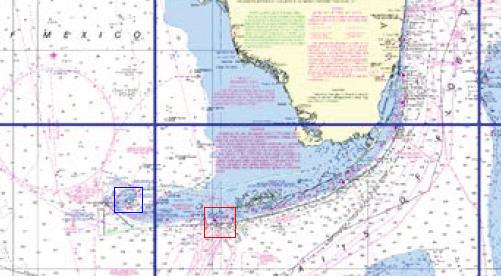
|
Something that will help sailors be better sailors is always useful. The World of Computing has developed a new technology called "Canvas" that's going to make teaching and learning how to sail better. Not easy, but better. The first big breakthrough technology for us way back when was GPS. Most people don't know how good it really is. The accuracy of civilian GPS isn't all that great when you are trying to find a geographical location on earth. GPS has errors built into the system and it's only accurate within about 30 feet of a given location. However and this is a big however, the accuracy of GPS between two track points received by the same GPS on the same sailboat is super accurate. The errors are the same for both track points. You can measure the difference between 2 or 200 track points with one GPS receiver. You can also measure between the bow and stern of the same sailboat using 2 GPS receivers. You can measure the location and the relative position of each GPS receiver with a computer. So much for the GPS lesson. Drawing dynamic lines on computer screens by programmers have been difficult up this point. Only the newest and latest Browsers have this Canvas capability. Most programmers use track points recorded by the GPS receiver to identify sailing performance by a sailboat. I'm not sure why sailing magazines don't use this type of technology to identify the sailing performance of new boats. Maybe that's more information than what they want to publish. One more thing about track points. They were designed to help GPS users find their way home. Like leaving breadcrumbs in children stories. They are generated by the receiver based on changes in a course or direction. That works for us too because that's what we want to know. We want to record when we change directions. Sailing is about position and time and the computer can do all the other calculations for us. Canvas is going to make our track points more accurate. I will be able to calibrate the map that we sail on more accurately (it's cosmetic, but helps us understand). Notice how I sailed through the piece of land at the bottom the chart. With the canvas lines, I can see that I need to keep my boat in the water. Accurately measuring upwind tacks with a right angle on the computer screen is going to be easy. A plastic protractor can measure every course change and we will all learn from what we did on the water. We will see how good we are when we get our first Web page with lines.
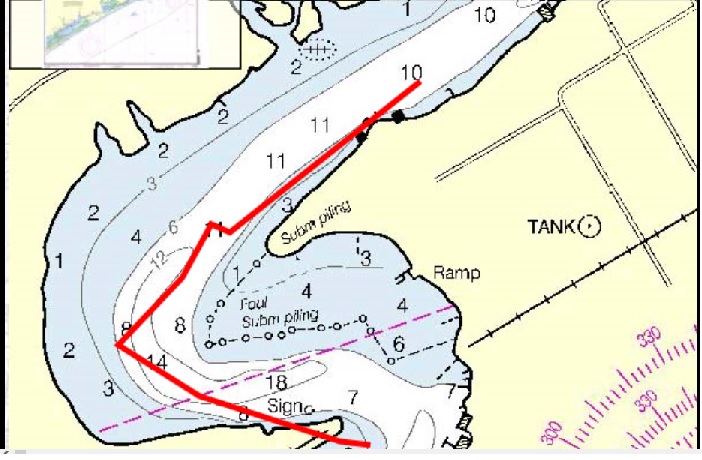
|
Com-Pac has built a new boat. It's currently called a Launch and it has gone through sea trials with some great results. Check the Factory's Web site under the "News" link. A diesel version of this boat is going to sell for about $42,000. With a good trade-in, this boat is going to be affordable. That's good news! A picture of the new boat is on our Home Page. |
Ron Brown from Jacksonville, NC has started his big Trawler trip to the Keys. We plan on keeping track of his progress with the article below. |
We have been installing diesel motors in Com-Pac Yachts for some time. People going long distances need an inboard diesel motor. Some owners use their motors to move their boats short distances to and from a place to sail. The electric inboard motor may be the right solution for these owners. The motor and the installation cost are less than a diesel and the electric motor can't be stolen off the back of the boat like an outboard. Most of our Com-Pac Yachts can handle an electric inboard installation well. Gerry at Com-Pac makes 6 different kinds of inboard motor mounts for Com-Pacs. The motor installation that we are looking at is 48 volts and it has a very small footprint. Email Keith for details. |
You may have noticed that The Sailboat Company has two Web Sites. The new site is going to hold our archived articles and short stories and maybe other items as we fill up the server. The new site address is sailboatrichlands.com, but you can click the link on the left to get to the new site. A newer Web browser will put one site on one tab and the other one on second tab. It will be easy to go back and forth. Our computer browsers have changed. The old ones would tolerate mistakes by programmers and render good understandable information with all kinds of errors and mistakes. Internet Explorer has about 60% of the market and most people write to that medium. In 2016, every one will have to write perfect HTML5 code. It will be used by all browsers including our friendly IE browser. If you have a late model browser like IE9 through IE11, reading old code like this site is best done in compatibility view. The tool menu lets you choose a compatibility view for old Web sites like this one. You really don't have to do anything, but the site isn't going to be as perfect as it will be when I upgrade my code. |
The Sailboat Company will be moving their Yamaha 25 from New Bern, NC to Jacksonville, NC this spring. Ports of call will be Beaufort or Morehead City, Swansboro and Snead s Ferry. Tag along by anyone wanting ICW experience is encouraged. |
Cumberland Boat Works is planning an ICW trip from Jacksonsonville, FL to the Keys this summer. They plan on doing the trip in a Com-Pac 23. If you want to sail along, you might want to contact them. They have a Web site at http://www.cumberlandboatworks.com/ or click on the link at the bottom of the page on the left. |
We have a new Airplane and Sailboat short story on the left. The EPA has removed sulfur from our diesel fuel. It doesn't smell bad anymore. That's the way I would test to see if my fuel was fresh. Fresh diesel would smell bad and the old fuel didn't have that same strong odor. Now the old fuel and the new fuel smell the same. Sulfur was used as a lubricate in the old fuel. We always use 30-weight oil in diesel motors in the south. Real hot weather in the summer months make that oil desirable. The oil was thick and didn't leak as much as the thin multi-grades. It kept our engines clean. The new 30-weight oil isn't thick anymore. I'm sure it meets the technical requirements for 30-weight oil, but it's as thin as the multi-grades that I try to avoid for my old engines. |
The Com-Pac Club (CPYANC) on this Web site is really a social site for Com-Pac owners. It was a way for members to connect and talk boats between other owners. Identity theft is a big problem and getting bigger. People doing Spam on computers are also a growing problem. I think it's time to close down the Com-Pac Yacht Association of North Carolina on this Web site. We need to protect your identity. I hope we can get together again sometime in the future for an outing and have some fun with our boats. We still plan on maintaining the Q&A section on this site. |
A Com-Pac 23D that just spent 6 months in the Bahamas is going to Key West. I think the boat likes the warm weather. A Trinka sailboat is going along for the ride.

|
We have the sister site in Jacksonville, FL and now we also have a new used equipment site. The Things of Yesteryear Store will sell used marine equipment like canoes, outboard motors and other used stuff (I call it junk). Prices will be good and the storeowner is my son. The outboard motors will be on the Web site as soon as we get a sunny day to make pictures. The Web site address is www.thingsofyesteryear-2u.com. Is that a mouth-full or what? |
Rick and Kelly have their business operating and they have a Web site. Their address is: www.cumberlandboatworks.com. Go to their Web site and say "Hello" using their email page. The Jacksonville, FL. area has some great cruising waters and their business is on the water. Maybe a good jumping off place for a cruise down the St. Johns river. |
Com-Pac sells parts to install small diesels in most brands of small sailboats from 20 to 25 foot. Used engines are available from boats that have been salvaged due to the current economy. Of course new diesels are available at a higher cost. It's a big DIY project, but most sailors that are handy with their hands can get it done. We just installed an old 1976 Yanmar YSM8 in a Com-Pac 23. It took about 2 weeks of spare time. |
We didn't have enough interest in our Club Race. It may be the economy or it may be the weather, but almost no one signed up for our racing weekend. The Annapolis Sailboat Show is the same weekend and Hurricane Karen is coming through this week and that didn't help our racing plans. Last year we had our outing on Mothers Day. I think I have a hard time picking good dates for outings. The racing would have been fun. It could be that everyone is just busy. The Sailboat Company has had a big 2013 so far. The used boat business has been very busy for us and Com-Pac said they have been busy building Picnic Cats. We have been ordering parts from Com-Pac to modify and bring our used boat fleet up to date. Have you noticed that our used Com-Pac 16s are getting few and far between? We stopped working on the 23T while we were doing our customer's boats. We still have a customer Com-Pac 23D that's going to Key West. It is going to be a pretty boat with lots of options. Our old 82 Com-Pac 23 outboard that we sold new in 82 currently has a diesel motor. It is just about completed and I think I'm going to play with it for a while. We may take it to the St. Johns River in FL for sea-trials. I have a son-in-law that going into the Com-Pac restoration business in Jacksonville, FL. He has already started on a 23 and he looking for some 16s. We will be updating our Web site when the weather gets cool. We will be doing an article on the care and feeding of small diesel engines. Most of it is finished, but it still needs to be published. Mike Humphreys just made a big voyage in his Horizon Cat. He picked up his boat at Jordan Lake and took it to Bath, NC and then sailed from Bath to Ocracoke Island. A picture of his boat in Bath is on this Web site's Home Page. I'm sure Blackbeard made that same voyage many times. He had a home in Bath. This is the same boat that made the long journey from Beaufort, SC to the Erie Canal in New York State. If sailboats could only talk, they could tell some great stories. I will publish the first owner's cruise story again this winter. |
We tried to race in the New River, but launching was going to be too complicated to make it work. The race on the 12th will start at Duck Creek Marker #1 in the Neuse River at Noon. We can use ramps at Northwest Creek Marina, Union Point in New Bern and the Park site next to the big bridge on the Trent River. You should be at the start line at least 15 minutes before start time. The plan is to race the course twice. The first race is a practice race and the final race will pick the big winner. You can look for the Com-Pac Coastal Packet committee boat at the race start line. The course will be from Duck Creek to #7 and #26 and back to Duck Creek. Dinner will be at Applebee s on Highway 17 in New Bern at 7:00 PM. Spending the night at Northwest Creek Marina or Duck Creek Marina is possible if you plan on going home on Sunday. Check with the management about the heads and a transit slip fee. RSVP is important so let Keith know if you plan on coming. An email or a phone call will do. We hope the weather is going to be fantastic and that we have a good turnout.
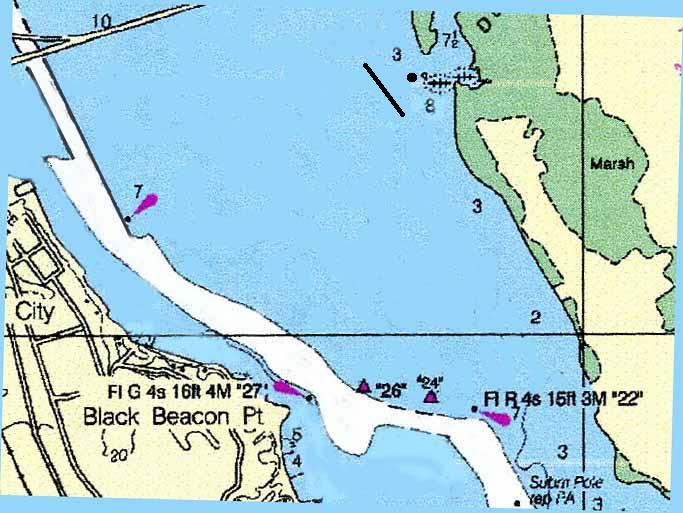
|
Being a software person, we have several pages on this Web site displaying Com-Pac racing and individual boat performance. We made an improvement to our software recently that shows boat headings as we sail around the course. The boats on the page are objects with 2 colors. The blue end is the stern and the red end is the bow. You can see the boat tack on its blue stern and point towards the new heading with its red bow. I like to print the chart and analyze the results while I'm in my easy chair. The headings and terrain tell the story. You can print the chart by pressing the PrtScreen key on your keyboard. The copy and paste method can move the image to a paint program for printing. The Browser Print function doesn't work that well. The images below show an Eclipse sailing on the wind towards the first mark. The wind is out of the south and light. We assume that the boat is pointing 45 degrees to the wind on that first leg. Can you see where the terrain changed the wind direction and the boat's course on that first leg? The little bump on the second leg is a wind change caused by terrain. The images are close together on the third leg indicating a slower boat. Going down wind is going to be slower.
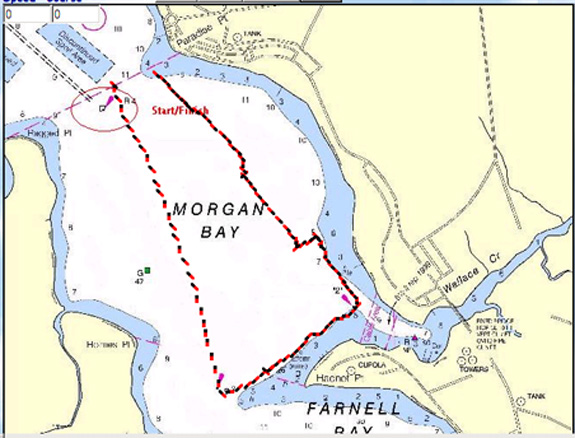
|
The Coastal Packet had it final US Coast Guard Inspection and she passed without discrepancies. It may be the only 20-foot pilothouse sailboat with a diesel. We had one person come by during the inspection and he said it was a boat that could do it all. It may not be a live aboard, but it is a boat that can go places on a trailer and can be sailed from inside with wheel steering and sleeping accommodations for two.
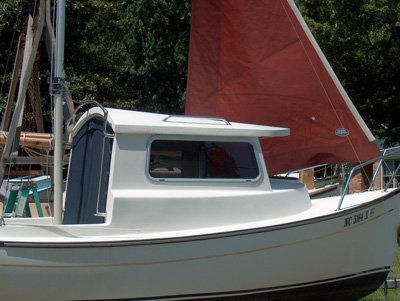
|
We lost another sailor on the 15th of this month. Bill was an Annapolis Graduate with a distinguished career as a Naval Officer and had captained ships laying communications cables across he Atlantic after leaving the Navy. You may have met Bill at the Raleigh Boat Show during the last 30 years. Bill stood in at the show while the other salespeople had dinner. He was the person with a smile and a dry sense of humor. Bill sailed his small boats all over the eastern part of North Carolina and he ferried small and large boats all over the country. He helped Richard Summers take his Com-Pac 27 to Texas by water. He also made many trips up and down the ICW with fellow sailors when they needed crew. He was good company on long voyages. Bill once captained a Ferry down the Mississippi, across the Gulf and on to New Bern, NC. I'm sure he did more, but Bill didn't talk that much about Bill. Bill came by The Sailboat Company 3 weeks ago and we talked about the good times. One time of note was when we were on our way to the Com-Pac Factory to pick up his new Horizon Cat. I was driving the truck and Bill was riding copilot and he said: "If I had to drive through this traffic to get this boat, I would leave it in Florida". He had a way of telling it the way it was. That's Bill on the left in the picture. We will miss William DeHart of Pittsboro, NC.
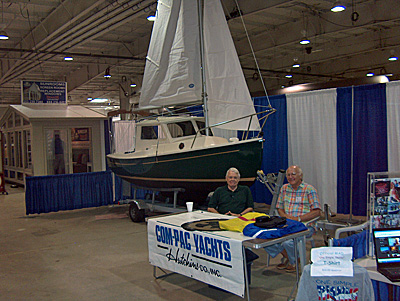
|
We have 2 sailors signed up for the October race on the New River. Bruce Woods and Wes Newman said they would be there. The plan is to launch at the Marina Cafe in Jacksonville. They have a ramp and a big parking lot. The masts have to stay down on the inland side of the Jacksonville bridges. Power lines prevent the mast from going up in that area. After going under 2 bridges, John Fountain's Marina is on the left and he said we could put our mast up there. From that point, it's only a hop, skip and jump to the race area on Morgan Bay. You can check out the racecourse on the links on the left. I currently have 4 GPS receivers and we will document the race. Dinner will be at the Marina Cafe and spending the night there should work well. Restrooms in the marina are large and clean. Sign up for the race when you can. |
The weather has been crazy this year and the boat-selling season started late. We are currently busy getting boats ready for their new owners. We did have time while it was raining (it rained a lot) to work on our computer sailing program. An improved program (Sun Cat Sail below) shows graphics with pointed ends instead of round dots. The graphics follows the course direction the boat is sailing. That way you can see when we miss a tack. We had some bad tacks on the first leg below. Can you pick them out? We hope to get some 16s, 19s and maybe Sun Cats out on this racetrack in the fall. Seeing reds and blues and greens with pointed ends going everywhere should be fun. Let me know if you think you can come down on a Saturday for a race in October. I think it needs to be in October to be enjoyable. |
The Sailboat Company has been blessed with a good selection of used boats this year. Most of the boats in the picture below are for sale. A few are being repaired and of course I own several boats that I call my own.
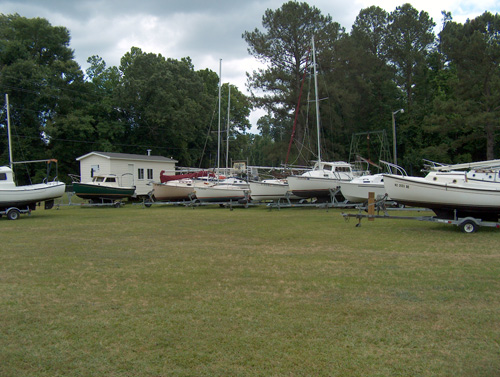
|
We just published a new Short Story on Racing. Click Racing Can Be Fun on the left. |
We didn't have enough members sign up for the cruise and we didn't go. Maybe that's a good thing because the weather turned super hot (91 degrees in the shade) with very little wind. The sail from Northwest Creek to Oriental would have been a great sail if the wind had been 10 to 15 knots. The forecast of 5 to 10 or less would have required the motor. We also had the same light wind forecast for Saturday and Sunday and it's hard to make miles on the Neuse River in light winds. |
The Marine Wind Forecast for Oriental is as follows:
16May 10 to 15 knots |
The Marine Wind Forecast for Oriental is as follows:
15May 10 to 15 knots |
The Marine Wind Forecast for Oriental is as follows:
14May 10 to 15 knots |
The Marine Wind Forecast for Oriental is as follows:
13May 10 to 15 knots |
The Marine Wind Forecast for Oriental is as follows:
12May 10 to 15 knots |
This is another update to the May Club Outing. Chart BookletCharts are available free from NOAA on line. 2 Booklets will be needed for this cruise. They are Booklets 11552 and 11548. Booklet 11552 covers the upper Neuse and Booklet 11548 covers the lower Neuse. Coverage splits at Oriental. This is the coldest spring on record and our sailing weather hasn't been that good so far. We expect winds in March, rain in April and spring flowers in May. It seems like we might be getting all three at the same time. 20 knots or more of wind on the lower Neuse is too much wind. It will give us waves of 3 feet or more and that's too much for a fun cruise. We need a forecast of 10 to 15 knots of wind in the lower Neuse for 3 days. A bad weather plan "B" for the cruise is to stay in the upper Neuse. The most important feature of this plan is to keep everyone informed. I plan on monitoring the weather and publishing the forecast for Oriental on this Web site for the cruise. Weather forecasts are petty good for 3 days in advance and a little less accurate for 5 days. We have to look at the 17th through the 19th with some parts of all three days navigating the lower Neuse. When you look at this big expanse of water and we are the only boats out there, we know something is wrong. TO MAKE THIS CRUISE WORK SMOOTHLY, EVERYONE THAT'S COMING NEEDS TO CHECK-IN WITH KEITH ON THE 15TH OR 16TH OF MAY BY EMAIL OR PHONE. PHONE NUMBER 910 324 4005. I WILL LET YOU KNOW THE PLAN AT THAT TIME. We are hoping for sunshine and fair winds. Keep your fingers crossed. |
This is a change to the May Cruise Outing below. Whittaker Creek Marina will be glad to have us spend the night with them on the 17th. They will take us to the restaurant in town and the restraint will bring us back to the boats. Anchoring out in Green Creek is no longer on our schedule. My cell phone number on the boat is 1-910-381-9596 and it will be turned on during the cruise. Of course we will also be up on VHF Channel 16 on the 17th. Whittaker Creek has an entrance marker about 200 yards downriver from what we call Oriental #1. Really, Oriental #1 is Smith Creek #1. The channel going into Whittaker Cheek is perpendicular to the Oriental entrance channel. Whittaker Creek has several marks including a range mark at the end on shore. Before getting to the range mark, you have to turn to port for Whittaker Creek Marina or starboard to go to Whittaker Point Marina. We will turn to port and from that turn, you can see the fuel dock at Whittaker Creek. Someone at the fuel dock will tell you where to go. It's the marina that appears to be on a point of land between 2 other creeks. The rest of the cruise remains the same so far. |
Our May Cruise is scheduled to begin Friday, the 17th of May. We will leave Neuse River Marker # 19 across from Northwest Creek Marina at 10:00 and head for Oriental, NC. The plan for Oriental is to anchor-out in Green Creek for the night. Transit facilities in Oriental are fewer than they were several years ago. Marinas that do offer transit slips in Oriental are Whittaker Creek, Whittaker Point and the Oriental Marina. The next morning, we will rendezvous off Oriental at 10:00 and head down the river for the River Dunes Marina on Board Creek. We will arrive at that marina Saturday afternoon and spend the night there. The next morning, we will depart at 9:00 for Northwest Creek Marina and home. This is going to be a flexible cruise because boats can join and depart the cruise at any time. Some boats may want to launch at Oriental and go from Oriental to River Dunes and back. Others may want to start with the group at Northwest Creek, sail to Oriental and then back to Northwest Creek. You can pick your days and the weather and sail as much or as little as you like. Launching ramps at Northwest Creek, Oriental and River Dunes are very good. The launching ramp in Oriental is at the base of the high-rise bridge. The details about launching at Northwest Creek are in last year's instructions. The maps of Northwest Creek Marina are still on this Web page below and that information is still accurate. Anchoring in Green Creek will be just inside the high-rise bridge on the port side. If the wind is high, we may go up the creek another 1/2 mile for more anchor room. Of course, you can email me (sailboat@ipass.net) or call (910 324 4005) for more information. The old name for Northwest Creek Marina was Fairfield Harbor Marina and I may have used that name last year. The correct name is Northwest Creek Marina. Both Northwest Creek and River Dunes know we are coming. That's a good thing. A bad thing is the restaurant at Northwest Creek is closed. I don't have a solution for that problem, but I think everyone should bring lots of food, drinks and drinking water. The food at River Dunes requires a reservation 10 days in advance and that's not going to work for us. I plan on having a grill on the stern of my boat and everyone on the cruise can use my grill. I think hotdogs may be on my menu at River Dunes. The distance from Northwest Creek to Oriental is about 17 miles and the distance from Oriental to River Dunes is about 10 miles. The anchoring in Green Creek will be on a short anchor rode to stay out of the channel. We need to monitor the weather forecast for Friday night. An anchor light will be needed for Green Creek. If you don't want to anchor-out, you could stay at one of the three marinas above that offer transit slips. Slips are available on a first come, first serve basis. |
Bruce Milne has owned several boats. His first was a Com-Pac 23 sailed while he was still in the Marine Corps. Bruce and his 23 had some good stories tell. Bruce flew helicopters in the Corps and after the Corps he worked for the FBI in Alaska. He currently has 37 dogs and races the IDITAROD when he can. His current and maybe last sailboat is a Com-Pac 23 on Resurrection Bay near Seward Alaska. He can only sail 30 days a year, but he says it's worth every minute. The picture was taken last summer and you can still see the snow on the mountains.
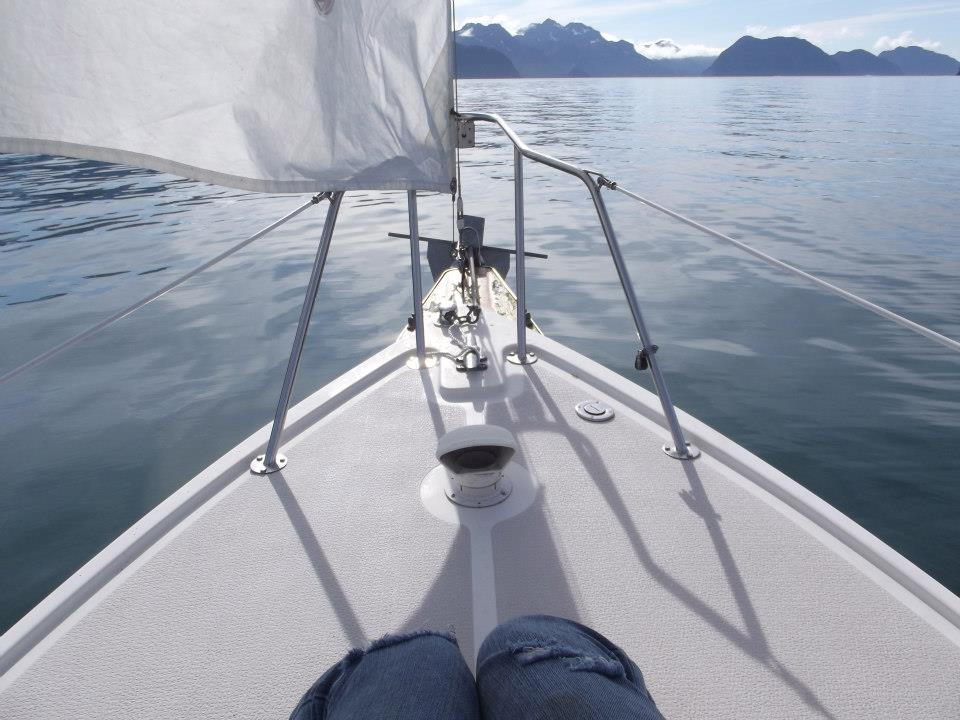
|
We published more sailing short stories on this Web site. It's too cold to sail anyway. Click "Sailing Short Stories" on the left. The New River at the mouth of the river and the inlet at Snead's Ferry have been dredged. We have a creek behind our boat yard that's running faster than it was before. Everyone with any draft was concerned about going aground at Snead's Ferry. I plan on coming through there with 4 feet of draft this summer. We talked to River Dunes about our cruise in May. They do weddings on Saturdays during the summer, but they said they could feed us at a different location. It looks like the cruise will start on Friday the 17th of May at Fairfield Harbor. Boats can join or leave the cruise at different locations. We plan on leaving Fairfield Harbor on Friday, departing Oriental on Saturday and going home from River Dunes on Sunday. We will have more details as time go on. |
We published 2 sailing short stories on this Web site. Click "Sailing Short Stories" on the left. We will have more stories about coastal sailing as time permits. |
We have a good-looking Com-Pac 23 Pilothouse on the yard. It should be here for the winter and you may want to come by and see this great looking boat. There is a reason why Sail Magazine picked this Pilothouse for their "Boat of the Year Award".
|
 Click Image For The Sailboat Company's Home Page
Click Image For The Sailboat Company's Home Page

